Analysis of Social Media Campaigns on Sainsbury's Brand Image
VerifiedAdded on 2023/02/01
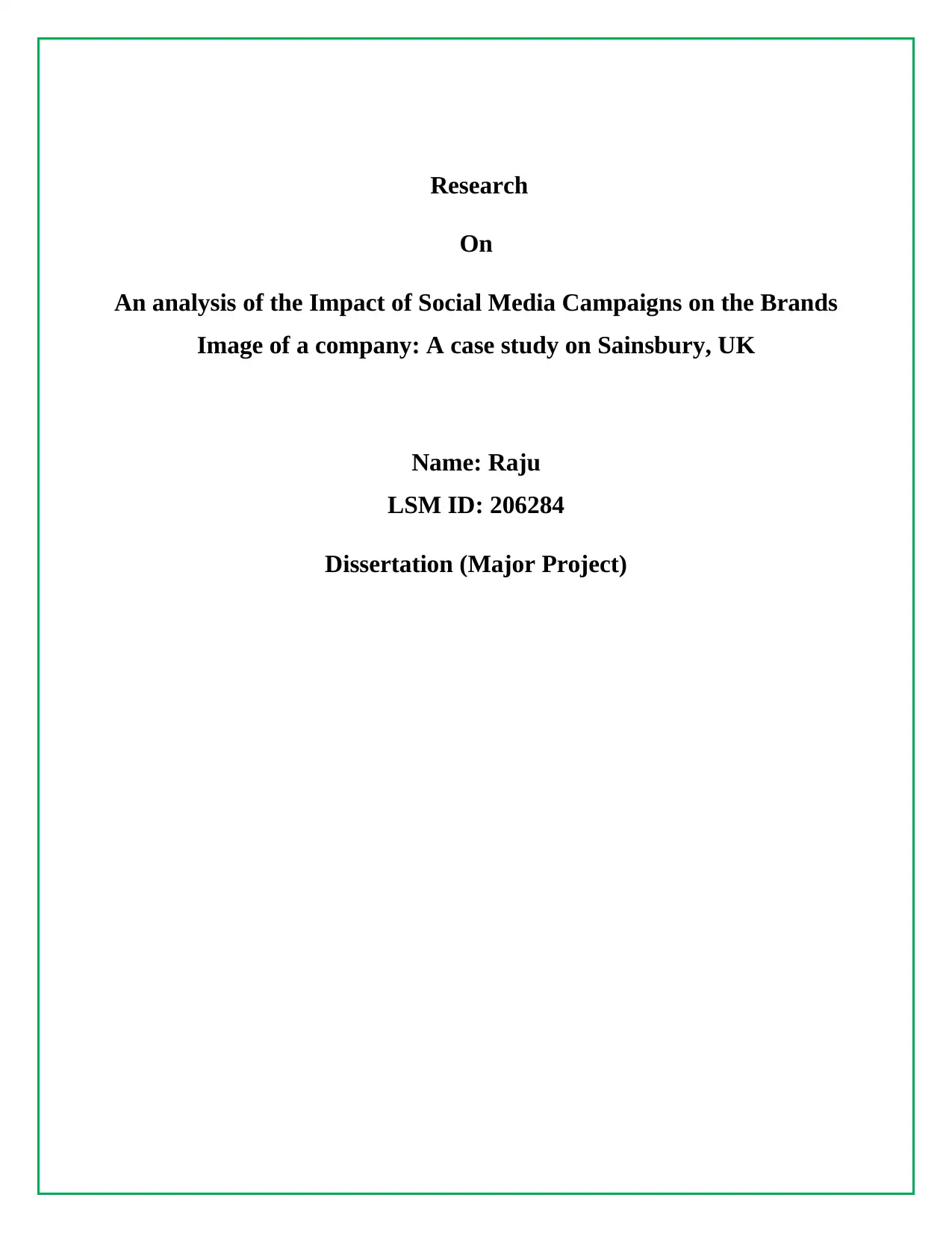
On
An analysis of the Impact of Social Media Campaigns on the Brands
Image of a company: A case study on Sainsbury, UK
Name: Raju
LSM ID: 206284
Dissertation (Major Project)
Paraphrase This Document

I would like to thank the Almighty for giving us the strength, and the aptitude to complete this
report within due time. I also express the depth of appreciation to my supervisor for his
suggestions and guidelines, which helped us in completing this report. I am also thankful to get
primary data from Marketing Managers and the customers of Sainsbury to complete this study.

I declare that the entire research paper has been completed by me and the entire work has been
done by writing and no copy pasting material has been added in this dissertation.
⊘ This is a preview!⊘
Do you want full access?
Subscribe today to unlock all pages.

Trusted by 1+ million students worldwide
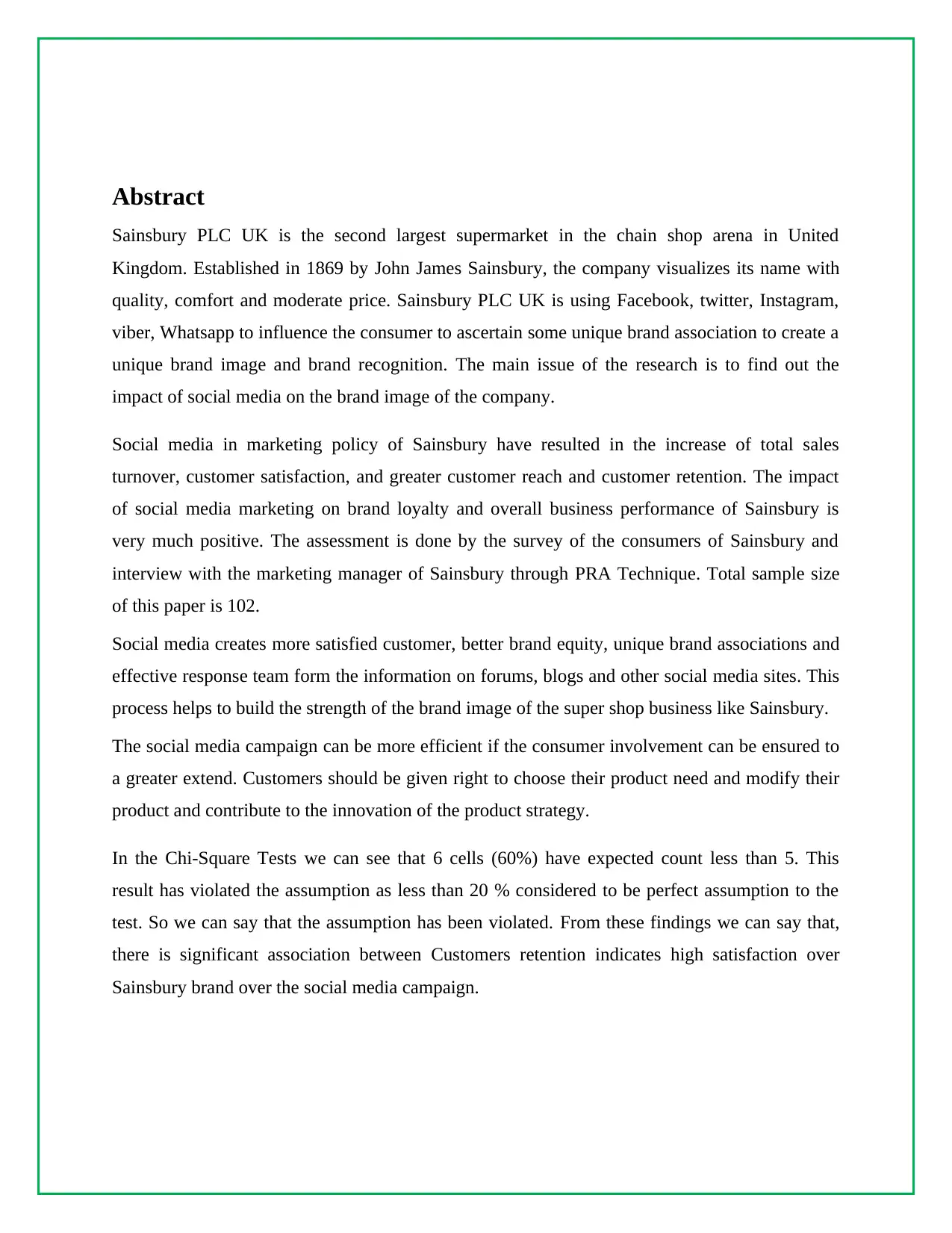
Sainsbury PLC UK is the second largest supermarket in the chain shop arena in United
Kingdom. Established in 1869 by John James Sainsbury, the company visualizes its name with
quality, comfort and moderate price. Sainsbury PLC UK is using Facebook, twitter, Instagram,
viber, Whatsapp to influence the consumer to ascertain some unique brand association to create a
unique brand image and brand recognition. The main issue of the research is to find out the
impact of social media on the brand image of the company.
Social media in marketing policy of Sainsbury have resulted in the increase of total sales
turnover, customer satisfaction, and greater customer reach and customer retention. The impact
of social media marketing on brand loyalty and overall business performance of Sainsbury is
very much positive. The assessment is done by the survey of the consumers of Sainsbury and
interview with the marketing manager of Sainsbury through PRA Technique. Total sample size
of this paper is 102.
Social media creates more satisfied customer, better brand equity, unique brand associations and
effective response team form the information on forums, blogs and other social media sites. This
process helps to build the strength of the brand image of the super shop business like Sainsbury.
The social media campaign can be more efficient if the consumer involvement can be ensured to
a greater extend. Customers should be given right to choose their product need and modify their
product and contribute to the innovation of the product strategy.
In the Chi-Square Tests we can see that 6 cells (60%) have expected count less than 5. This
result has violated the assumption as less than 20 % considered to be perfect assumption to the
test. So we can say that the assumption has been violated. From these findings we can say that,
there is significant association between Customers retention indicates high satisfaction over
Sainsbury brand over the social media campaign.
Paraphrase This Document
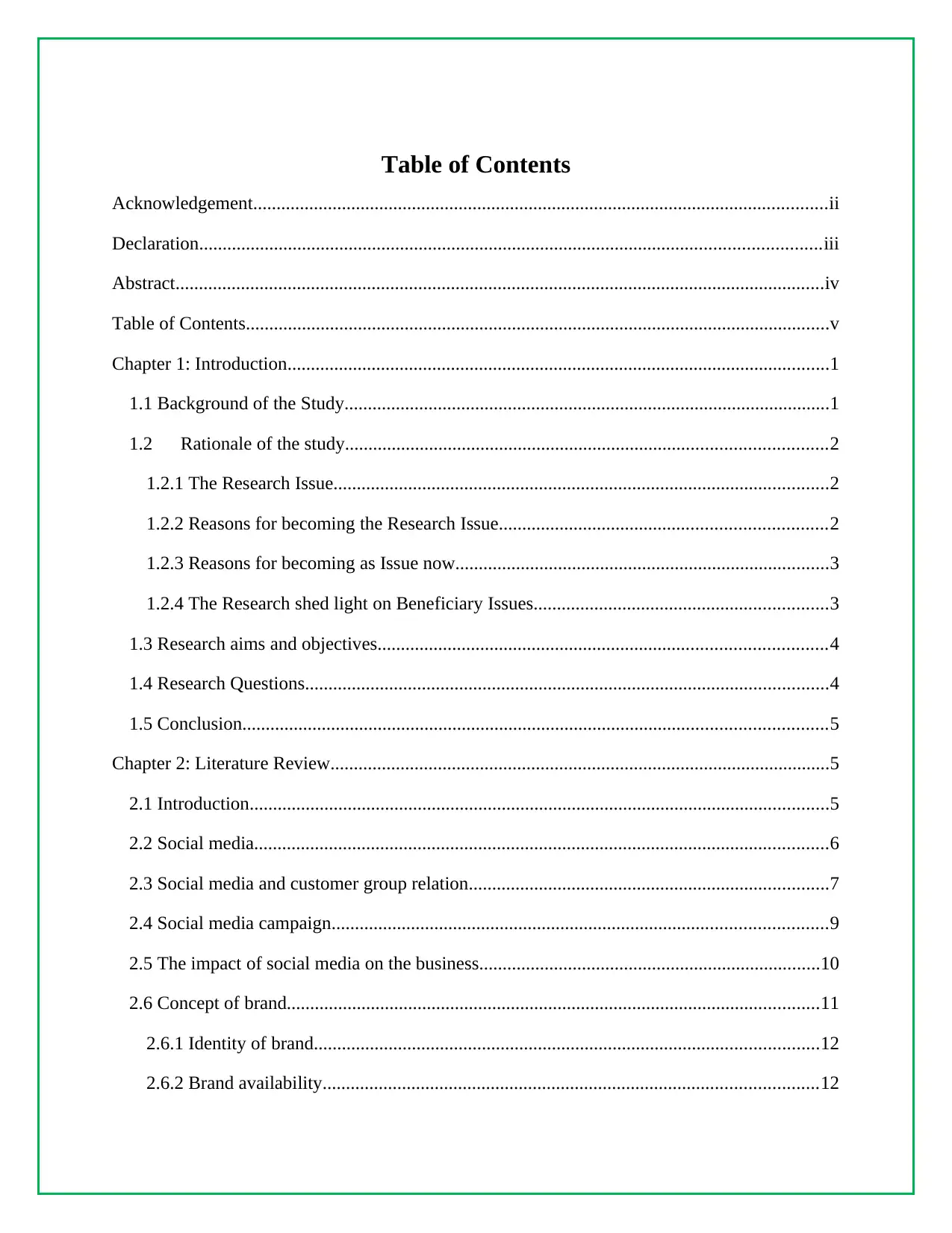
Acknowledgement...........................................................................................................................ii
Declaration.....................................................................................................................................iii
Abstract...........................................................................................................................................iv
Table of Contents.............................................................................................................................v
Chapter 1: Introduction....................................................................................................................1
1.1 Background of the Study........................................................................................................1
1.2 Rationale of the study.......................................................................................................2
1.2.1 The Research Issue..........................................................................................................2
1.2.2 Reasons for becoming the Research Issue......................................................................2
1.2.3 Reasons for becoming as Issue now................................................................................3
1.2.4 The Research shed light on Beneficiary Issues...............................................................3
1.3 Research aims and objectives................................................................................................4
1.4 Research Questions................................................................................................................4
1.5 Conclusion.............................................................................................................................5
Chapter 2: Literature Review...........................................................................................................5
2.1 Introduction............................................................................................................................5
2.2 Social media...........................................................................................................................6
2.3 Social media and customer group relation.............................................................................7
2.4 Social media campaign..........................................................................................................9
2.5 The impact of social media on the business.........................................................................10
2.6 Concept of brand..................................................................................................................11
2.6.1 Identity of brand............................................................................................................12
2.6.2 Brand availability..........................................................................................................12
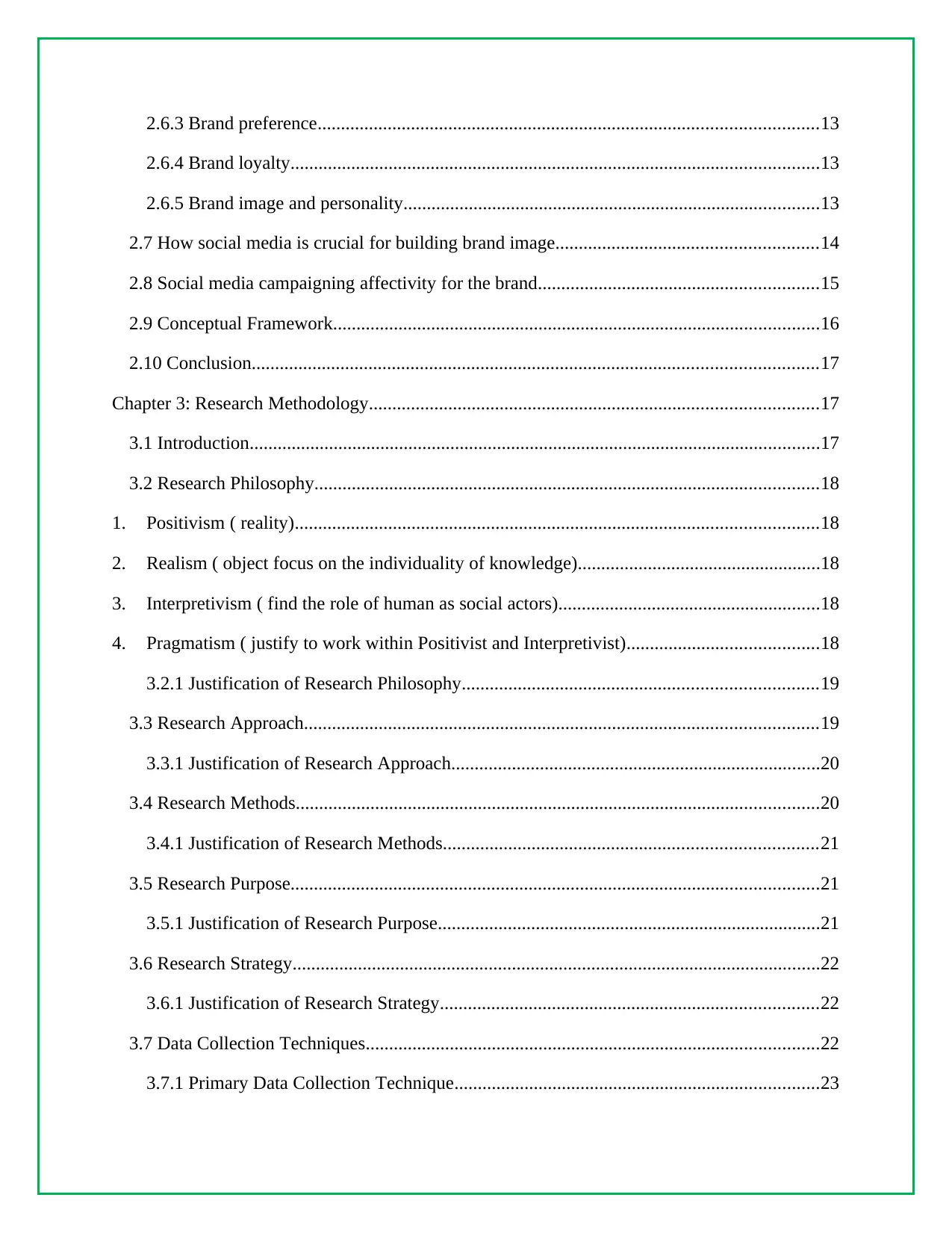
2.6.4 Brand loyalty.................................................................................................................13
2.6.5 Brand image and personality.........................................................................................13
2.7 How social media is crucial for building brand image........................................................14
2.8 Social media campaigning affectivity for the brand............................................................15
2.9 Conceptual Framework........................................................................................................16
2.10 Conclusion.........................................................................................................................17
Chapter 3: Research Methodology................................................................................................17
3.1 Introduction..........................................................................................................................17
3.2 Research Philosophy............................................................................................................18
1. Positivism ( reality)................................................................................................................18
2. Realism ( object focus on the individuality of knowledge)....................................................18
3. Interpretivism ( find the role of human as social actors)........................................................18
4. Pragmatism ( justify to work within Positivist and Interpretivist).........................................18
3.2.1 Justification of Research Philosophy............................................................................19
3.3 Research Approach..............................................................................................................19
3.3.1 Justification of Research Approach...............................................................................20
3.4 Research Methods................................................................................................................20
3.4.1 Justification of Research Methods................................................................................21
3.5 Research Purpose.................................................................................................................21
3.5.1 Justification of Research Purpose..................................................................................21
3.6 Research Strategy.................................................................................................................22
3.6.1 Justification of Research Strategy.................................................................................22
3.7 Data Collection Techniques.................................................................................................22
3.7.1 Primary Data Collection Technique..............................................................................23
⊘ This is a preview!⊘
Do you want full access?
Subscribe today to unlock all pages.

Trusted by 1+ million students worldwide
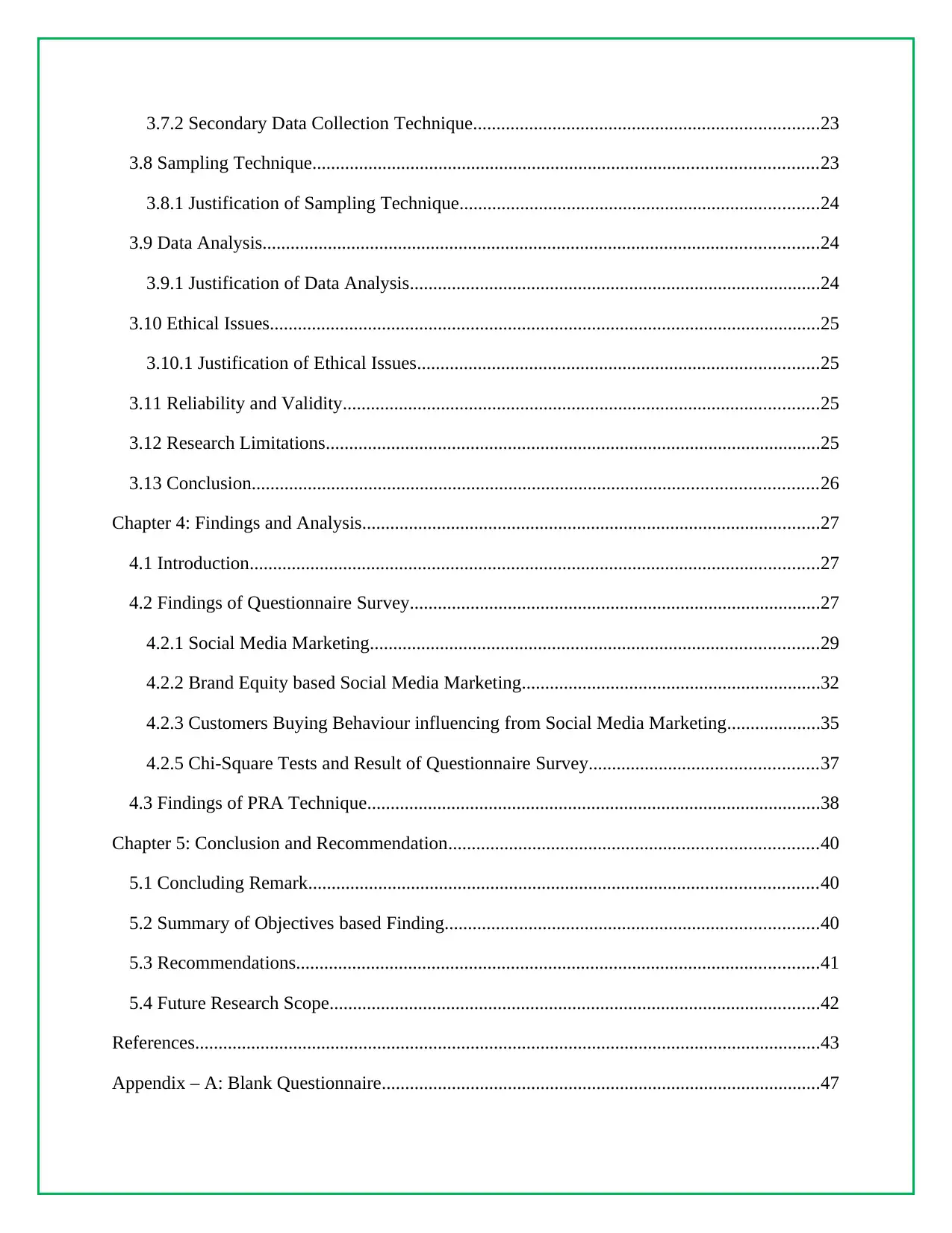
3.8 Sampling Technique............................................................................................................23
3.8.1 Justification of Sampling Technique.............................................................................24
3.9 Data Analysis.......................................................................................................................24
3.9.1 Justification of Data Analysis........................................................................................24
3.10 Ethical Issues......................................................................................................................25
3.10.1 Justification of Ethical Issues......................................................................................25
3.11 Reliability and Validity......................................................................................................25
3.12 Research Limitations..........................................................................................................25
3.13 Conclusion.........................................................................................................................26
Chapter 4: Findings and Analysis..................................................................................................27
4.1 Introduction..........................................................................................................................27
4.2 Findings of Questionnaire Survey........................................................................................27
4.2.1 Social Media Marketing................................................................................................29
4.2.2 Brand Equity based Social Media Marketing................................................................32
4.2.3 Customers Buying Behaviour influencing from Social Media Marketing....................35
4.2.5 Chi-Square Tests and Result of Questionnaire Survey.................................................37
4.3 Findings of PRA Technique.................................................................................................38
Chapter 5: Conclusion and Recommendation...............................................................................40
5.1 Concluding Remark.............................................................................................................40
5.2 Summary of Objectives based Finding................................................................................40
5.3 Recommendations................................................................................................................41
5.4 Future Research Scope.........................................................................................................42
References......................................................................................................................................43
Appendix – A: Blank Questionnaire..............................................................................................47
Paraphrase This Document
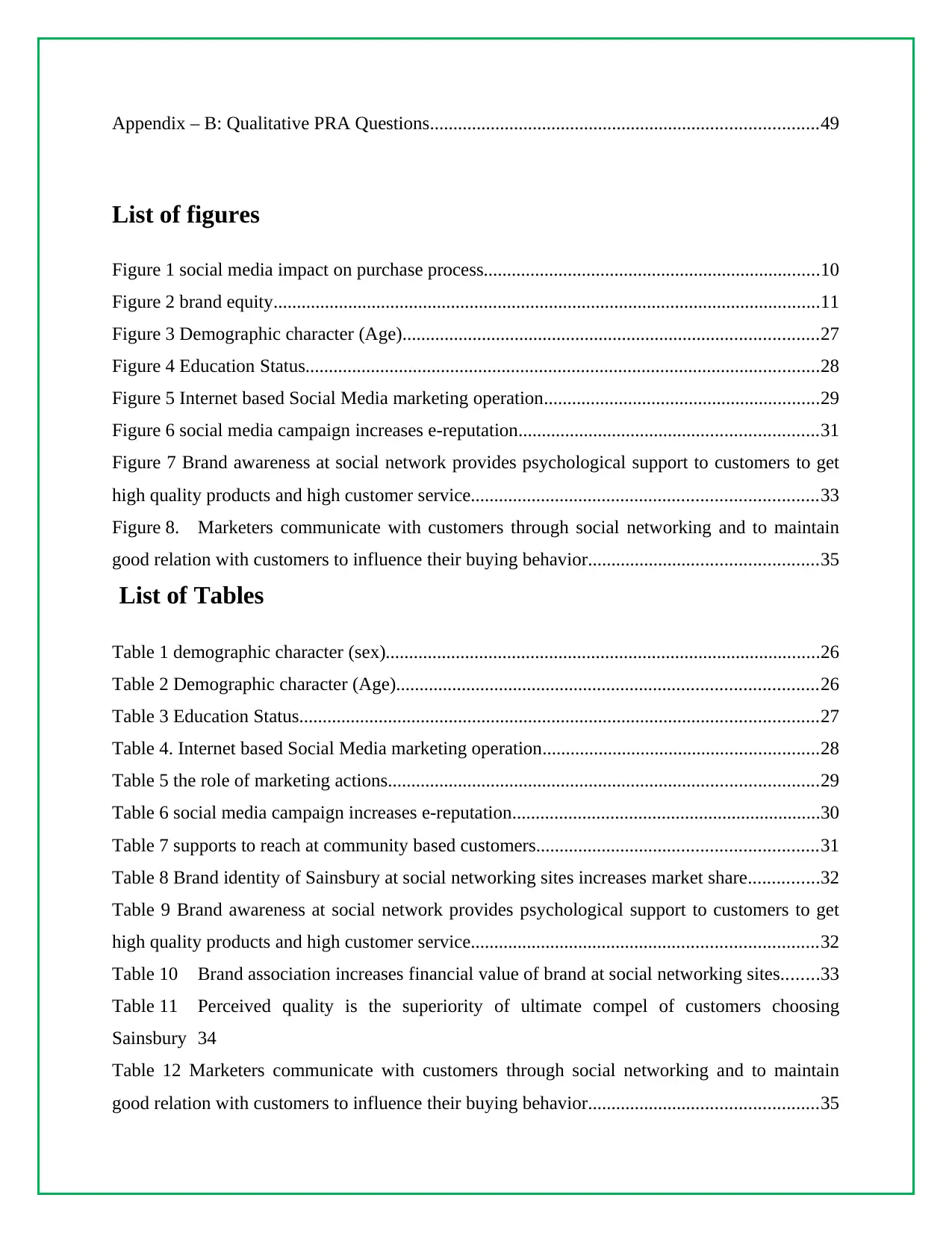
List of figures
Figure 1 social media impact on purchase process........................................................................10
Figure 2 brand equity.....................................................................................................................11
Figure 3 Demographic character (Age).........................................................................................27
Figure 4 Education Status..............................................................................................................28
Figure 5 Internet based Social Media marketing operation...........................................................29
Figure 6 social media campaign increases e-reputation................................................................31
Figure 7 Brand awareness at social network provides psychological support to customers to get
high quality products and high customer service..........................................................................33
Figure 8. Marketers communicate with customers through social networking and to maintain
good relation with customers to influence their buying behavior.................................................35
List of Tables
Table 1 demographic character (sex).............................................................................................26
Table 2 Demographic character (Age)..........................................................................................26
Table 3 Education Status...............................................................................................................27
Table 4. Internet based Social Media marketing operation...........................................................28
Table 5 the role of marketing actions............................................................................................29
Table 6 social media campaign increases e-reputation..................................................................30
Table 7 supports to reach at community based customers............................................................31
Table 8 Brand identity of Sainsbury at social networking sites increases market share...............32
Table 9 Brand awareness at social network provides psychological support to customers to get
high quality products and high customer service..........................................................................32
Table 10 Brand association increases financial value of brand at social networking sites........33
Table 11 Perceived quality is the superiority of ultimate compel of customers choosing
Sainsbury 34
Table 12 Marketers communicate with customers through social networking and to maintain
good relation with customers to influence their buying behavior.................................................35
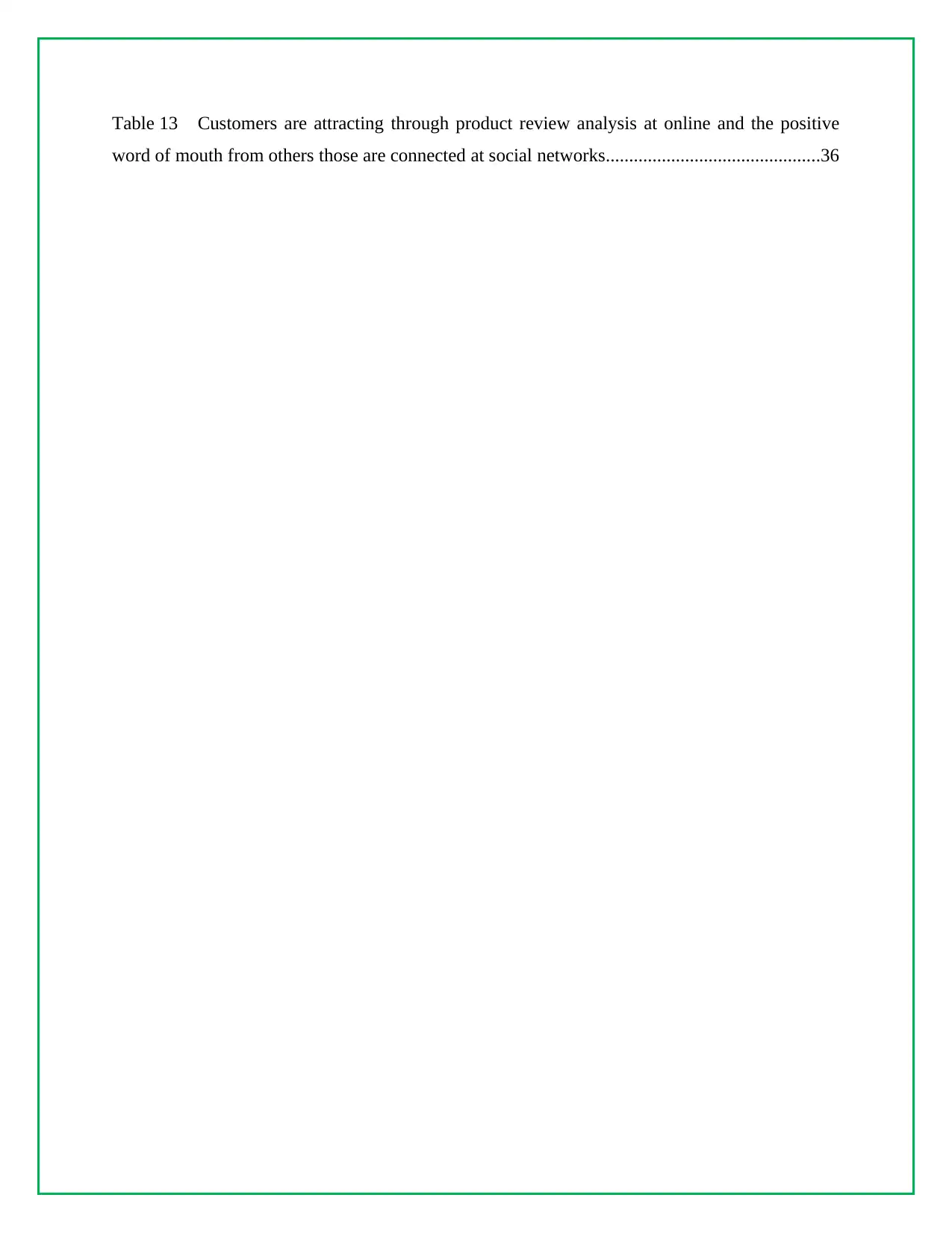
word of mouth from others those are connected at social networks..............................................36
⊘ This is a preview!⊘
Do you want full access?
Subscribe today to unlock all pages.

Trusted by 1+ million students worldwide
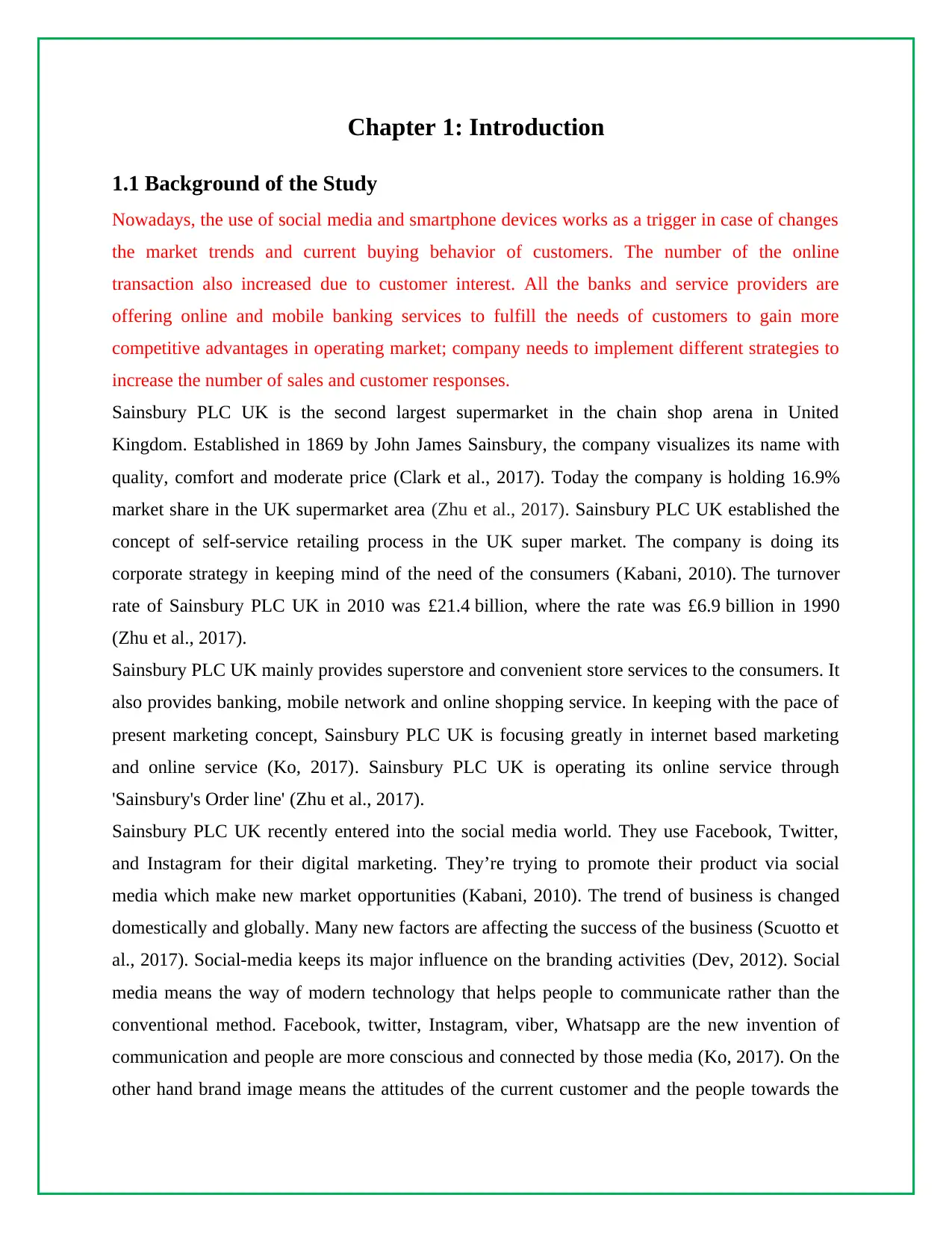
1.1 Background of the Study
Nowadays, the use of social media and smartphone devices works as a trigger in case of changes
the market trends and current buying behavior of customers. The number of the online
transaction also increased due to customer interest. All the banks and service providers are
offering online and mobile banking services to fulfill the needs of customers to gain more
competitive advantages in operating market; company needs to implement different strategies to
increase the number of sales and customer responses.
Sainsbury PLC UK is the second largest supermarket in the chain shop arena in United
Kingdom. Established in 1869 by John James Sainsbury, the company visualizes its name with
quality, comfort and moderate price (Clark et al., 2017). Today the company is holding 16.9%
market share in the UK supermarket area (Zhu et al., 2017). Sainsbury PLC UK established the
concept of self-service retailing process in the UK super market. The company is doing its
corporate strategy in keeping mind of the need of the consumers (Kabani, 2010). The turnover
rate of Sainsbury PLC UK in 2010 was £21.4 billion, where the rate was £6.9 billion in 1990
(Zhu et al., 2017).
Sainsbury PLC UK mainly provides superstore and convenient store services to the consumers. It
also provides banking, mobile network and online shopping service. In keeping with the pace of
present marketing concept, Sainsbury PLC UK is focusing greatly in internet based marketing
and online service (Ko, 2017). Sainsbury PLC UK is operating its online service through
'Sainsbury's Order line' (Zhu et al., 2017).
Sainsbury PLC UK recently entered into the social media world. They use Facebook, Twitter,
and Instagram for their digital marketing. They’re trying to promote their product via social
media which make new market opportunities (Kabani, 2010). The trend of business is changed
domestically and globally. Many new factors are affecting the success of the business (Scuotto et
al., 2017). Social-media keeps its major influence on the branding activities (Dev, 2012). Social
media means the way of modern technology that helps people to communicate rather than the
conventional method. Facebook, twitter, Instagram, viber, Whatsapp are the new invention of
communication and people are more conscious and connected by those media (Ko, 2017). On the
other hand brand image means the attitudes of the current customer and the people towards the
Paraphrase This Document
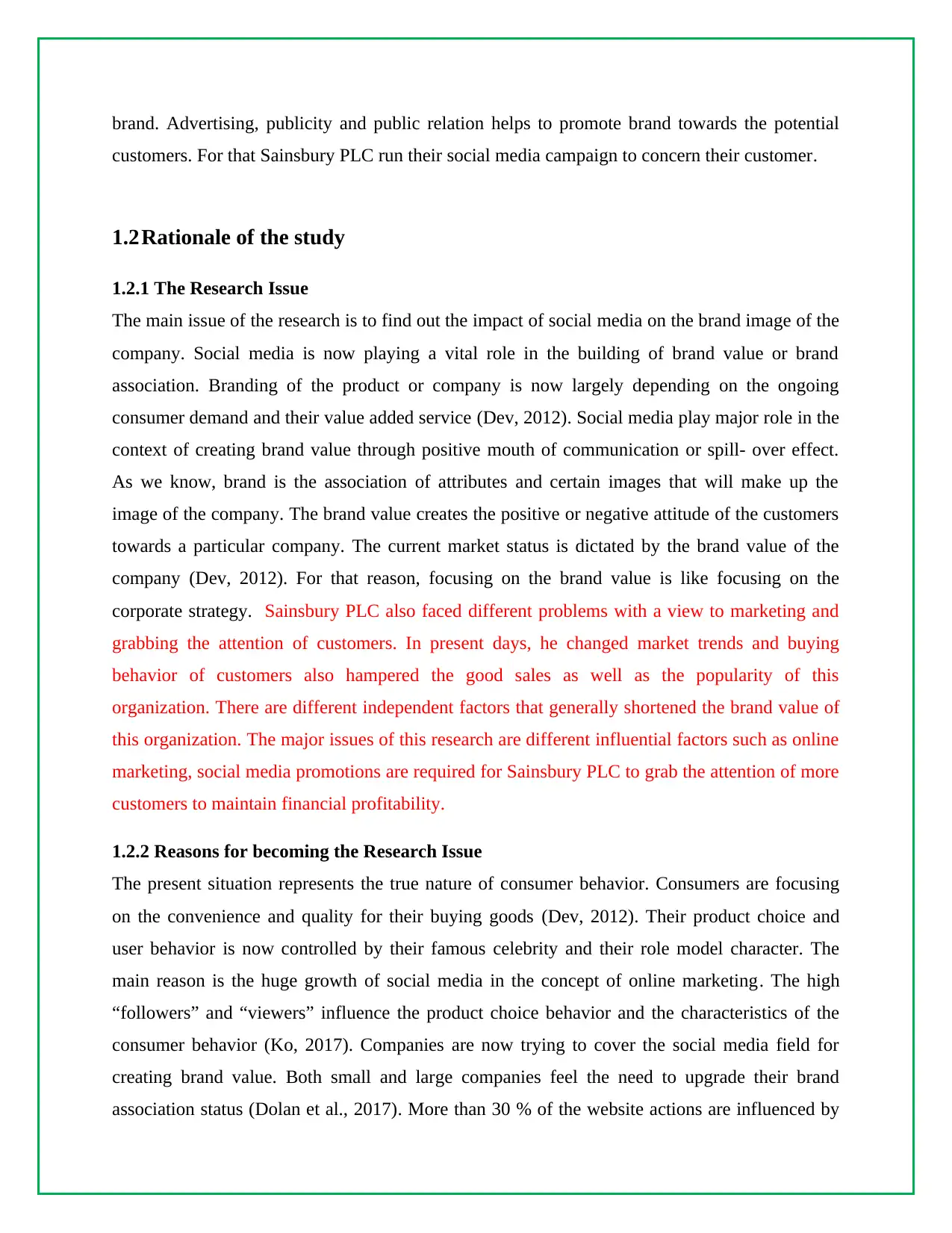
customers. For that Sainsbury PLC run their social media campaign to concern their customer.
1.2Rationale of the study
1.2.1 The Research Issue
The main issue of the research is to find out the impact of social media on the brand image of the
company. Social media is now playing a vital role in the building of brand value or brand
association. Branding of the product or company is now largely depending on the ongoing
consumer demand and their value added service (Dev, 2012). Social media play major role in the
context of creating brand value through positive mouth of communication or spill- over effect.
As we know, brand is the association of attributes and certain images that will make up the
image of the company. The brand value creates the positive or negative attitude of the customers
towards a particular company. The current market status is dictated by the brand value of the
company (Dev, 2012). For that reason, focusing on the brand value is like focusing on the
corporate strategy. Sainsbury PLC also faced different problems with a view to marketing and
grabbing the attention of customers. In present days, he changed market trends and buying
behavior of customers also hampered the good sales as well as the popularity of this
organization. There are different independent factors that generally shortened the brand value of
this organization. The major issues of this research are different influential factors such as online
marketing, social media promotions are required for Sainsbury PLC to grab the attention of more
customers to maintain financial profitability.
1.2.2 Reasons for becoming the Research Issue
The present situation represents the true nature of consumer behavior. Consumers are focusing
on the convenience and quality for their buying goods (Dev, 2012). Their product choice and
user behavior is now controlled by their famous celebrity and their role model character. The
main reason is the huge growth of social media in the concept of online marketing. The high
“followers” and “viewers” influence the product choice behavior and the characteristics of the
consumer behavior (Ko, 2017). Companies are now trying to cover the social media field for
creating brand value. Both small and large companies feel the need to upgrade their brand
association status (Dolan et al., 2017). More than 30 % of the website actions are influenced by

media sites and the word of mouth communication is influencing the brand value than ever (Zhu
et al., 2017).
1.2.3 Reasons for becoming as Issue now
The current trends towards the online marketing and internet marketing have created the trend of
using social media as a means of creating brand value of the company. Sainsbury PLC UK is
using Facebook, twitter, Instagram, viber, Whatsapp to influence the consumer to ascertain some
unique brand association to create a unique brand image and brand recognition (Zhu et al., 2017).
Several apps and online promotion media is utilized to create this brand value more interesting
and recognizable (Scuotto et al., 2017). The trend of online campaign and marketing massage
through social media are now getting momentum and creating more viewer than other form of
marketing and the reach is higher than ever (Dolan et al., 2017). The current form of distribution
is also getting influenced by the overall social media and the increasing trend is become vigilant
in the case of societal marketing strategy.
1.2.4 The Research shed light on Beneficiary Issues
This research is trying to shed light on the concept of social media in creating brand value of a
company. The study also wants to find the idea of creating effective brand value to the
segmented customer based on expected societal medium marketing strategy. This study will also
help to understand the impact of social media on branding, the proficiency of the social media as
promotional tools and the problems and opportunities conduct with it (Kabani, 2010). In new
pattern of business all firms even small firms re intensively join in social medic to promote their
product and service. The research will helps the others to join with social media for promote
their offer in a small cost but globally (Dolan et al., 2017). Meanwhile most of them are able to
seam in and can be achieved with a low budget. Buzzeo (2010) identified that 72% of the
companies already have Facebook accounts and 500 companies’ have LinkedIn accounts. This
research also proposes to the company to manage the negative attitudes to the media and
moderate it as like as the customer wants and preference (Carpentier et al., 2017). While social
media marketing is plentiful popular in the developed world but the latent assistances of it are
fewer underlined in the developing markets like as south Asia, Africa. Here some market
expertise suggested that the company should more concern on building social media attendance
⊘ This is a preview!⊘
Do you want full access?
Subscribe today to unlock all pages.

Trusted by 1+ million students worldwide
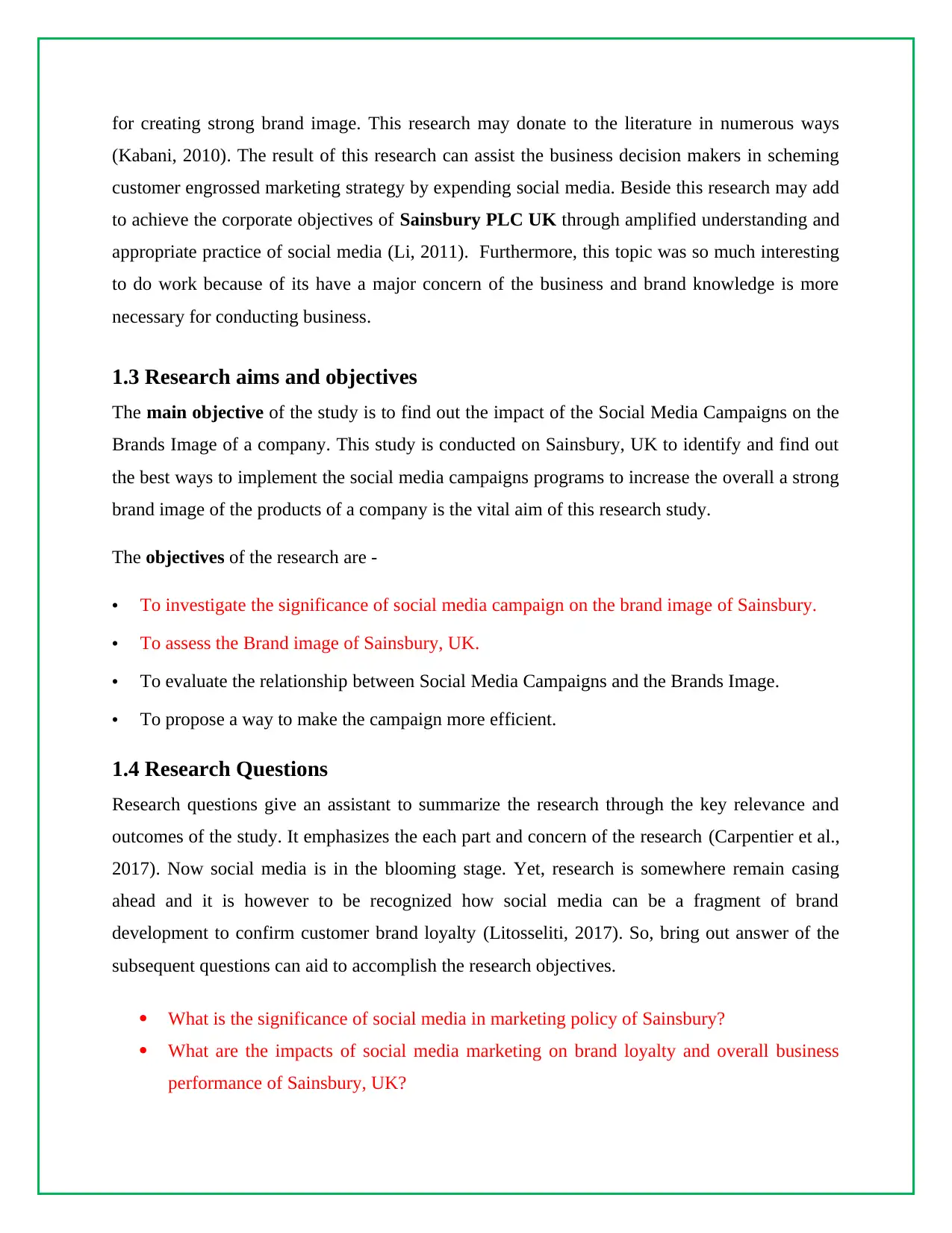
(Kabani, 2010). The result of this research can assist the business decision makers in scheming
customer engrossed marketing strategy by expending social media. Beside this research may add
to achieve the corporate objectives of Sainsbury PLC UK through amplified understanding and
appropriate practice of social media (Li, 2011). Furthermore, this topic was so much interesting
to do work because of its have a major concern of the business and brand knowledge is more
necessary for conducting business.
1.3 Research aims and objectives
The main objective of the study is to find out the impact of the Social Media Campaigns on the
Brands Image of a company. This study is conducted on Sainsbury, UK to identify and find out
the best ways to implement the social media campaigns programs to increase the overall a strong
brand image of the products of a company is the vital aim of this research study.
The objectives of the research are -
• To investigate the significance of social media campaign on the brand image of Sainsbury.
• To assess the Brand image of Sainsbury, UK.
• To evaluate the relationship between Social Media Campaigns and the Brands Image.
• To propose a way to make the campaign more efficient.
1.4 Research Questions
Research questions give an assistant to summarize the research through the key relevance and
outcomes of the study. It emphasizes the each part and concern of the research (Carpentier et al.,
2017). Now social media is in the blooming stage. Yet, research is somewhere remain casing
ahead and it is however to be recognized how social media can be a fragment of brand
development to confirm customer brand loyalty (Litosseliti, 2017). So, bring out answer of the
subsequent questions can aid to accomplish the research objectives.
What is the significance of social media in marketing policy of Sainsbury?
What are the impacts of social media marketing on brand loyalty and overall business
performance of Sainsbury, UK?
Paraphrase This Document
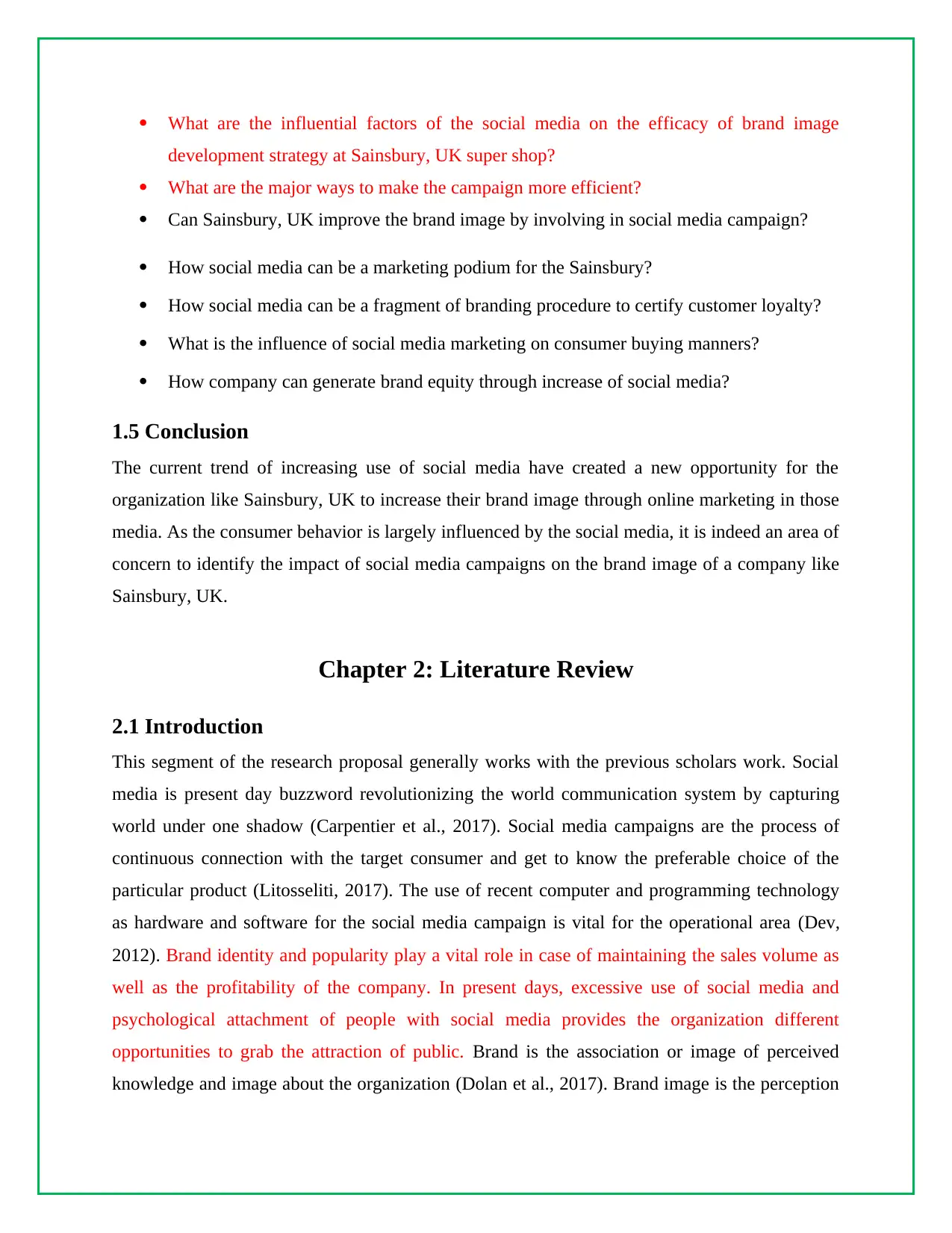
development strategy at Sainsbury, UK super shop?
What are the major ways to make the campaign more efficient?
Can Sainsbury, UK improve the brand image by involving in social media campaign?
How social media can be a marketing podium for the Sainsbury?
How social media can be a fragment of branding procedure to certify customer loyalty?
What is the influence of social media marketing on consumer buying manners?
How company can generate brand equity through increase of social media?
1.5 Conclusion
The current trend of increasing use of social media have created a new opportunity for the
organization like Sainsbury, UK to increase their brand image through online marketing in those
media. As the consumer behavior is largely influenced by the social media, it is indeed an area of
concern to identify the impact of social media campaigns on the brand image of a company like
Sainsbury, UK.
Chapter 2: Literature Review
2.1 Introduction
This segment of the research proposal generally works with the previous scholars work. Social
media is present day buzzword revolutionizing the world communication system by capturing
world under one shadow (Carpentier et al., 2017). Social media campaigns are the process of
continuous connection with the target consumer and get to know the preferable choice of the
particular product (Litosseliti, 2017). The use of recent computer and programming technology
as hardware and software for the social media campaign is vital for the operational area (Dev,
2012). Brand identity and popularity play a vital role in case of maintaining the sales volume as
well as the profitability of the company. In present days, excessive use of social media and
psychological attachment of people with social media provides the organization different
opportunities to grab the attraction of public. Brand is the association or image of perceived
knowledge and image about the organization (Dolan et al., 2017). Brand image is the perception
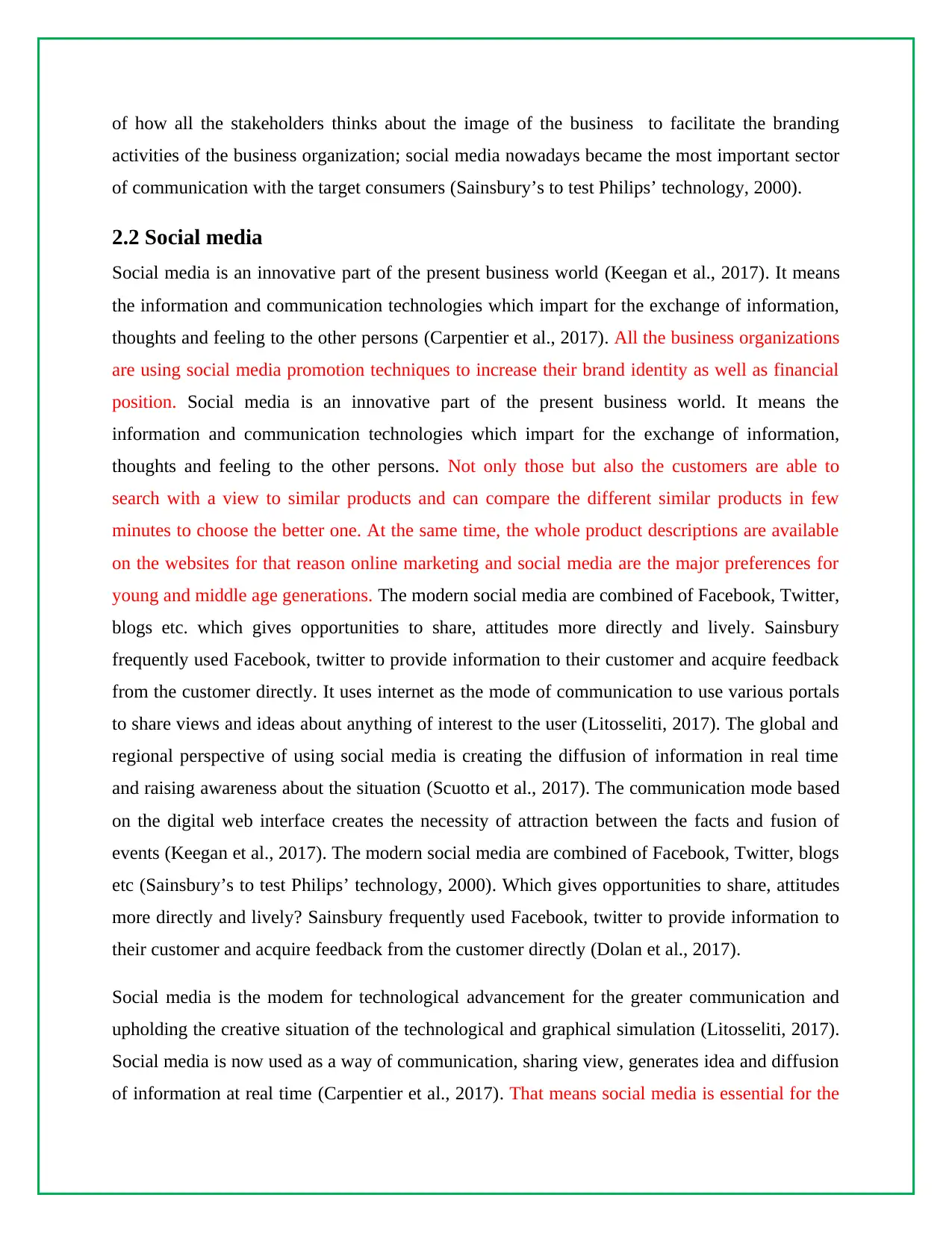
activities of the business organization; social media nowadays became the most important sector
of communication with the target consumers (Sainsbury’s to test Philips’ technology, 2000).
2.2 Social media
Social media is an innovative part of the present business world (Keegan et al., 2017). It means
the information and communication technologies which impart for the exchange of information,
thoughts and feeling to the other persons (Carpentier et al., 2017). All the business organizations
are using social media promotion techniques to increase their brand identity as well as financial
position. Social media is an innovative part of the present business world. It means the
information and communication technologies which impart for the exchange of information,
thoughts and feeling to the other persons. Not only those but also the customers are able to
search with a view to similar products and can compare the different similar products in few
minutes to choose the better one. At the same time, the whole product descriptions are available
on the websites for that reason online marketing and social media are the major preferences for
young and middle age generations. The modern social media are combined of Facebook, Twitter,
blogs etc. which gives opportunities to share, attitudes more directly and lively. Sainsbury
frequently used Facebook, twitter to provide information to their customer and acquire feedback
from the customer directly. It uses internet as the mode of communication to use various portals
to share views and ideas about anything of interest to the user (Litosseliti, 2017). The global and
regional perspective of using social media is creating the diffusion of information in real time
and raising awareness about the situation (Scuotto et al., 2017). The communication mode based
on the digital web interface creates the necessity of attraction between the facts and fusion of
events (Keegan et al., 2017). The modern social media are combined of Facebook, Twitter, blogs
etc (Sainsbury’s to test Philips’ technology, 2000). Which gives opportunities to share, attitudes
more directly and lively? Sainsbury frequently used Facebook, twitter to provide information to
their customer and acquire feedback from the customer directly (Dolan et al., 2017).
Social media is the modem for technological advancement for the greater communication and
upholding the creative situation of the technological and graphical simulation (Litosseliti, 2017).
Social media is now used as a way of communication, sharing view, generates idea and diffusion
of information at real time (Carpentier et al., 2017). That means social media is essential for the
⊘ This is a preview!⊘
Do you want full access?
Subscribe today to unlock all pages.

Trusted by 1+ million students worldwide
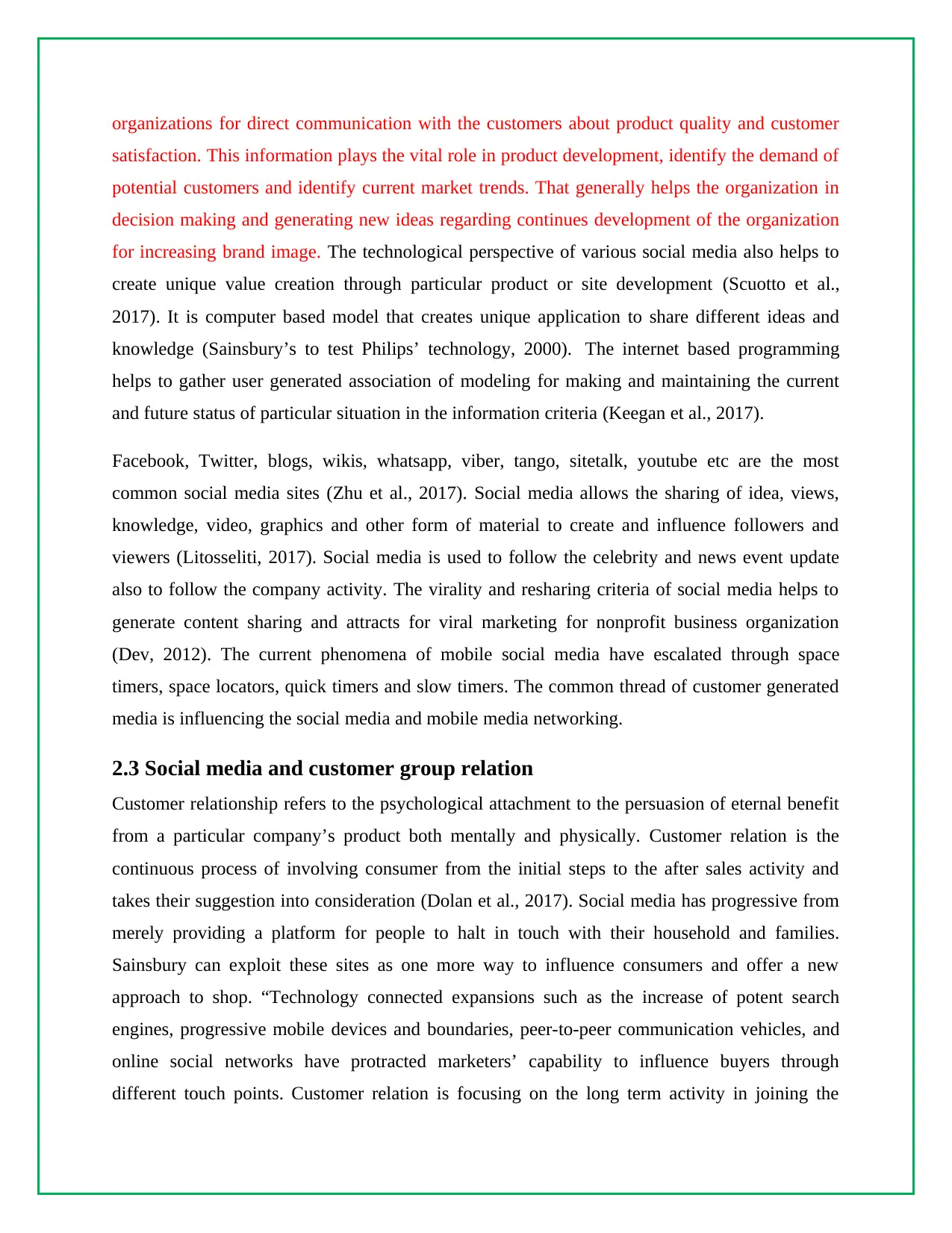
satisfaction. This information plays the vital role in product development, identify the demand of
potential customers and identify current market trends. That generally helps the organization in
decision making and generating new ideas regarding continues development of the organization
for increasing brand image. The technological perspective of various social media also helps to
create unique value creation through particular product or site development (Scuotto et al.,
2017). It is computer based model that creates unique application to share different ideas and
knowledge (Sainsbury’s to test Philips’ technology, 2000). The internet based programming
helps to gather user generated association of modeling for making and maintaining the current
and future status of particular situation in the information criteria (Keegan et al., 2017).
Facebook, Twitter, blogs, wikis, whatsapp, viber, tango, sitetalk, youtube etc are the most
common social media sites (Zhu et al., 2017). Social media allows the sharing of idea, views,
knowledge, video, graphics and other form of material to create and influence followers and
viewers (Litosseliti, 2017). Social media is used to follow the celebrity and news event update
also to follow the company activity. The virality and resharing criteria of social media helps to
generate content sharing and attracts for viral marketing for nonprofit business organization
(Dev, 2012). The current phenomena of mobile social media have escalated through space
timers, space locators, quick timers and slow timers. The common thread of customer generated
media is influencing the social media and mobile media networking.
2.3 Social media and customer group relation
Customer relationship refers to the psychological attachment to the persuasion of eternal benefit
from a particular company’s product both mentally and physically. Customer relation is the
continuous process of involving consumer from the initial steps to the after sales activity and
takes their suggestion into consideration (Dolan et al., 2017). Social media has progressive from
merely providing a platform for people to halt in touch with their household and families.
Sainsbury can exploit these sites as one more way to influence consumers and offer a new
approach to shop. “Technology connected expansions such as the increase of potent search
engines, progressive mobile devices and boundaries, peer-to-peer communication vehicles, and
online social networks have protracted marketers’ capability to influence buyers through
different touch points. Customer relation is focusing on the long term activity in joining the
Paraphrase This Document

depends on how much dependency a particular customer feels about in the decision making
process (Coolican, 2017). The planning, co-operation and join combination of production,
marketing and after sales effort make long term customer relationship with the company (Scuotto
et al., 2017). The ever changing scenario of customer preference can easily be predicted through
effective customer relationship with the company (Sainsbury’s innovation ROI, 2006). The
usage of social media is rising at an astral rate. With Facebook moving on the stock argument at
a mind baffling $104 billion, many pessimists forecast a gurgle. However, there is no repudiating
the control of social media and the influence that it can take on the business of marketing.
Sainsbury can get a large opportunity for its branding through connecting people through social
media affairs.
Social media has progressive from merely providing a platform for people to halt in touch with
their household and families. Sainsbury can exploit these sites as one more way to influence
consumers and offer a new approach to shop. “Technology connected expansions such as the
increase of potent search engines, progressive mobile devices and boundaries, peer-to-peer
communication vehicles, and online social networks have protracted marketers’ capability to
influence buyers through different touch points.
Sainsbury PLC UK is using Facebook, twitter, youtube and other form of social media to create
customer relation (Zhu et al., 2017). The automatic event update and package offerings are
quickly available to the customers (Felix, Rauschnabel and Hinsch, 2017). Customers can make
recommendation through online survey and service rating. The followers and viewers of
Sainsbury PLC UK influence others to come to the retail shop and find the discrepancy between
their expectations (Scuotto et al., 2017). Online space for conversation and online group can
share their views and feelings about any particular phenomenon and product initiating (Coolican,
2017). Sainsbury PLC UK gets their primary information about particular new product initiation
through social media (Zhu et al., 2017).
2.4 Social media campaign
Social media campaign is the process of gaining momentum or online traffic by using social
sites. The online hits and viewership will increase the customer reach of a particular company’s
product. Social media campaign is the effective tool for the ascertaining the customer choice and
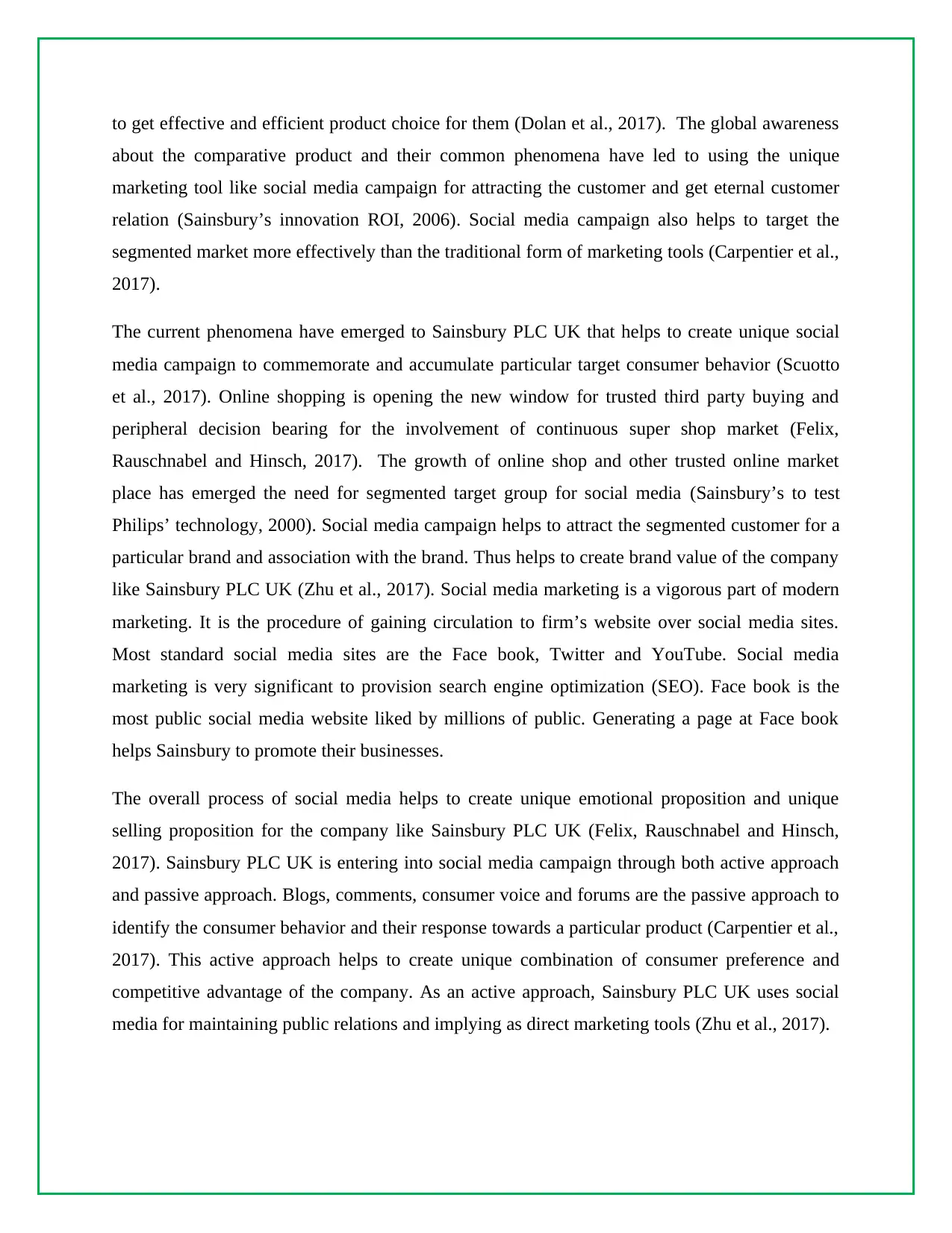
about the comparative product and their common phenomena have led to using the unique
marketing tool like social media campaign for attracting the customer and get eternal customer
relation (Sainsbury’s innovation ROI, 2006). Social media campaign also helps to target the
segmented market more effectively than the traditional form of marketing tools (Carpentier et al.,
2017).
The current phenomena have emerged to Sainsbury PLC UK that helps to create unique social
media campaign to commemorate and accumulate particular target consumer behavior (Scuotto
et al., 2017). Online shopping is opening the new window for trusted third party buying and
peripheral decision bearing for the involvement of continuous super shop market (Felix,
Rauschnabel and Hinsch, 2017). The growth of online shop and other trusted online market
place has emerged the need for segmented target group for social media (Sainsbury’s to test
Philips’ technology, 2000). Social media campaign helps to attract the segmented customer for a
particular brand and association with the brand. Thus helps to create brand value of the company
like Sainsbury PLC UK (Zhu et al., 2017). Social media marketing is a vigorous part of modern
marketing. It is the procedure of gaining circulation to firm’s website over social media sites.
Most standard social media sites are the Face book, Twitter and YouTube. Social media
marketing is very significant to provision search engine optimization (SEO). Face book is the
most public social media website liked by millions of public. Generating a page at Face book
helps Sainsbury to promote their businesses.
The overall process of social media helps to create unique emotional proposition and unique
selling proposition for the company like Sainsbury PLC UK (Felix, Rauschnabel and Hinsch,
2017). Sainsbury PLC UK is entering into social media campaign through both active approach
and passive approach. Blogs, comments, consumer voice and forums are the passive approach to
identify the consumer behavior and their response towards a particular product (Carpentier et al.,
2017). This active approach helps to create unique combination of consumer preference and
competitive advantage of the company. As an active approach, Sainsbury PLC UK uses social
media for maintaining public relations and implying as direct marketing tools (Zhu et al., 2017).
⊘ This is a preview!⊘
Do you want full access?
Subscribe today to unlock all pages.

Trusted by 1+ million students worldwide
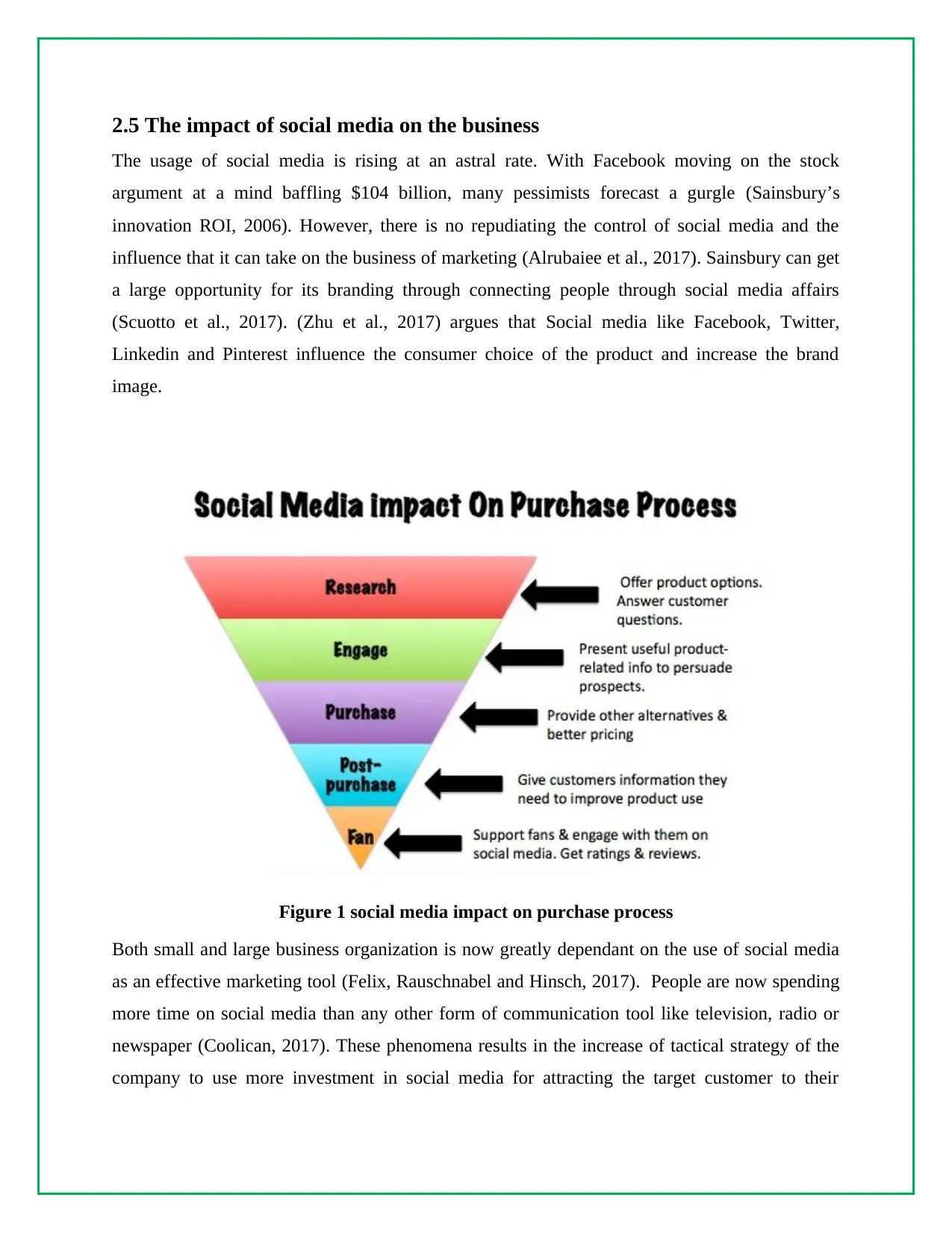
The usage of social media is rising at an astral rate. With Facebook moving on the stock
argument at a mind baffling $104 billion, many pessimists forecast a gurgle (Sainsbury’s
innovation ROI, 2006). However, there is no repudiating the control of social media and the
influence that it can take on the business of marketing (Alrubaiee et al., 2017). Sainsbury can get
a large opportunity for its branding through connecting people through social media affairs
(Scuotto et al., 2017). (Zhu et al., 2017) argues that Social media like Facebook, Twitter,
Linkedin and Pinterest influence the consumer choice of the product and increase the brand
image.
Figure 1 social media impact on purchase process
Both small and large business organization is now greatly dependant on the use of social media
as an effective marketing tool (Felix, Rauschnabel and Hinsch, 2017). People are now spending
more time on social media than any other form of communication tool like television, radio or
newspaper (Coolican, 2017). These phenomena results in the increase of tactical strategy of the
company to use more investment in social media for attracting the target customer to their
Paraphrase This Document
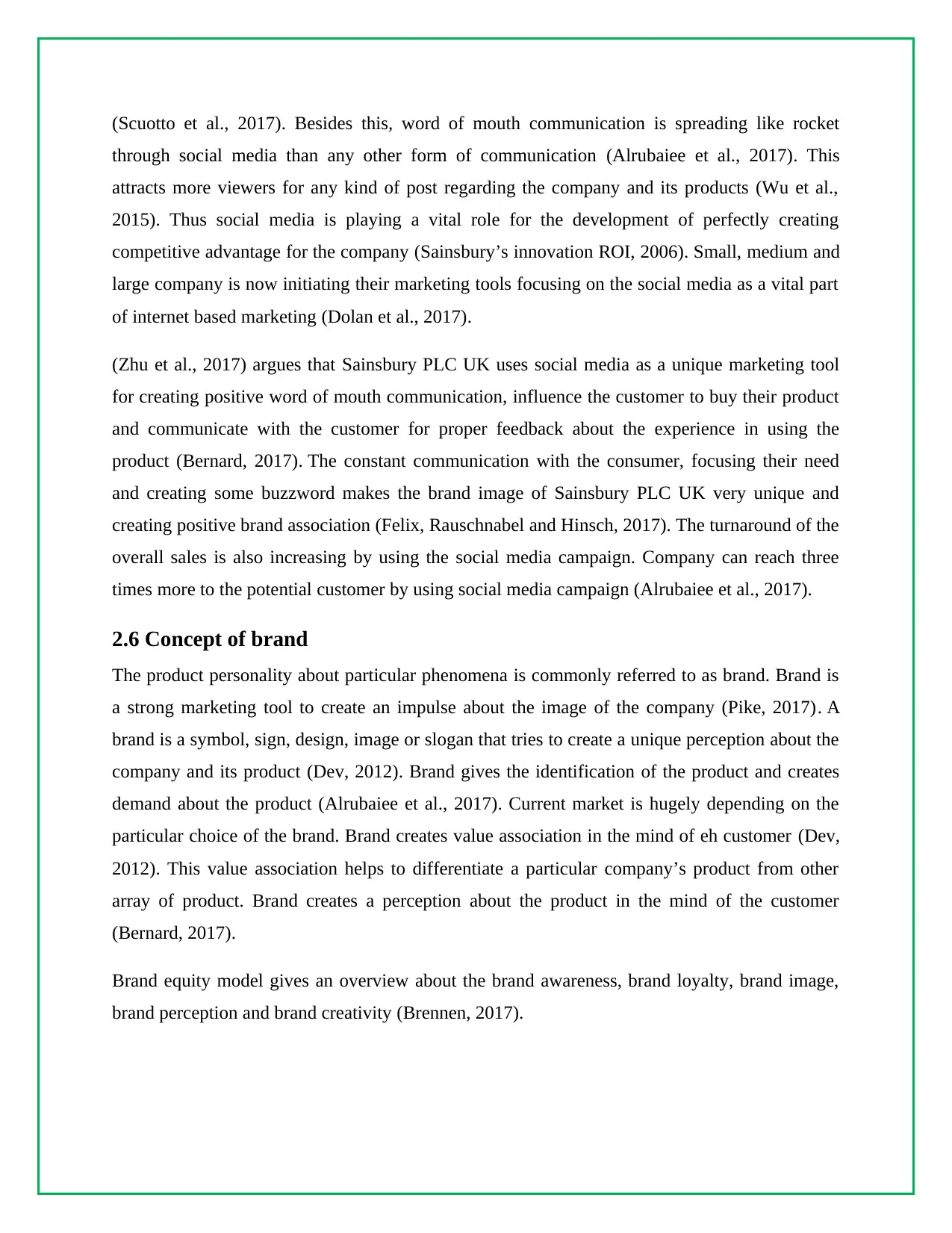
through social media than any other form of communication (Alrubaiee et al., 2017). This
attracts more viewers for any kind of post regarding the company and its products (Wu et al.,
2015). Thus social media is playing a vital role for the development of perfectly creating
competitive advantage for the company (Sainsbury’s innovation ROI, 2006). Small, medium and
large company is now initiating their marketing tools focusing on the social media as a vital part
of internet based marketing (Dolan et al., 2017).
(Zhu et al., 2017) argues that Sainsbury PLC UK uses social media as a unique marketing tool
for creating positive word of mouth communication, influence the customer to buy their product
and communicate with the customer for proper feedback about the experience in using the
product (Bernard, 2017). The constant communication with the consumer, focusing their need
and creating some buzzword makes the brand image of Sainsbury PLC UK very unique and
creating positive brand association (Felix, Rauschnabel and Hinsch, 2017). The turnaround of the
overall sales is also increasing by using the social media campaign. Company can reach three
times more to the potential customer by using social media campaign (Alrubaiee et al., 2017).
2.6 Concept of brand
The product personality about particular phenomena is commonly referred to as brand. Brand is
a strong marketing tool to create an impulse about the image of the company (Pike, 2017). A
brand is a symbol, sign, design, image or slogan that tries to create a unique perception about the
company and its product (Dev, 2012). Brand gives the identification of the product and creates
demand about the product (Alrubaiee et al., 2017). Current market is hugely depending on the
particular choice of the brand. Brand creates value association in the mind of eh customer (Dev,
2012). This value association helps to differentiate a particular company’s product from other
array of product. Brand creates a perception about the product in the mind of the customer
(Bernard, 2017).
Brand equity model gives an overview about the brand awareness, brand loyalty, brand image,
brand perception and brand creativity (Brennen, 2017).
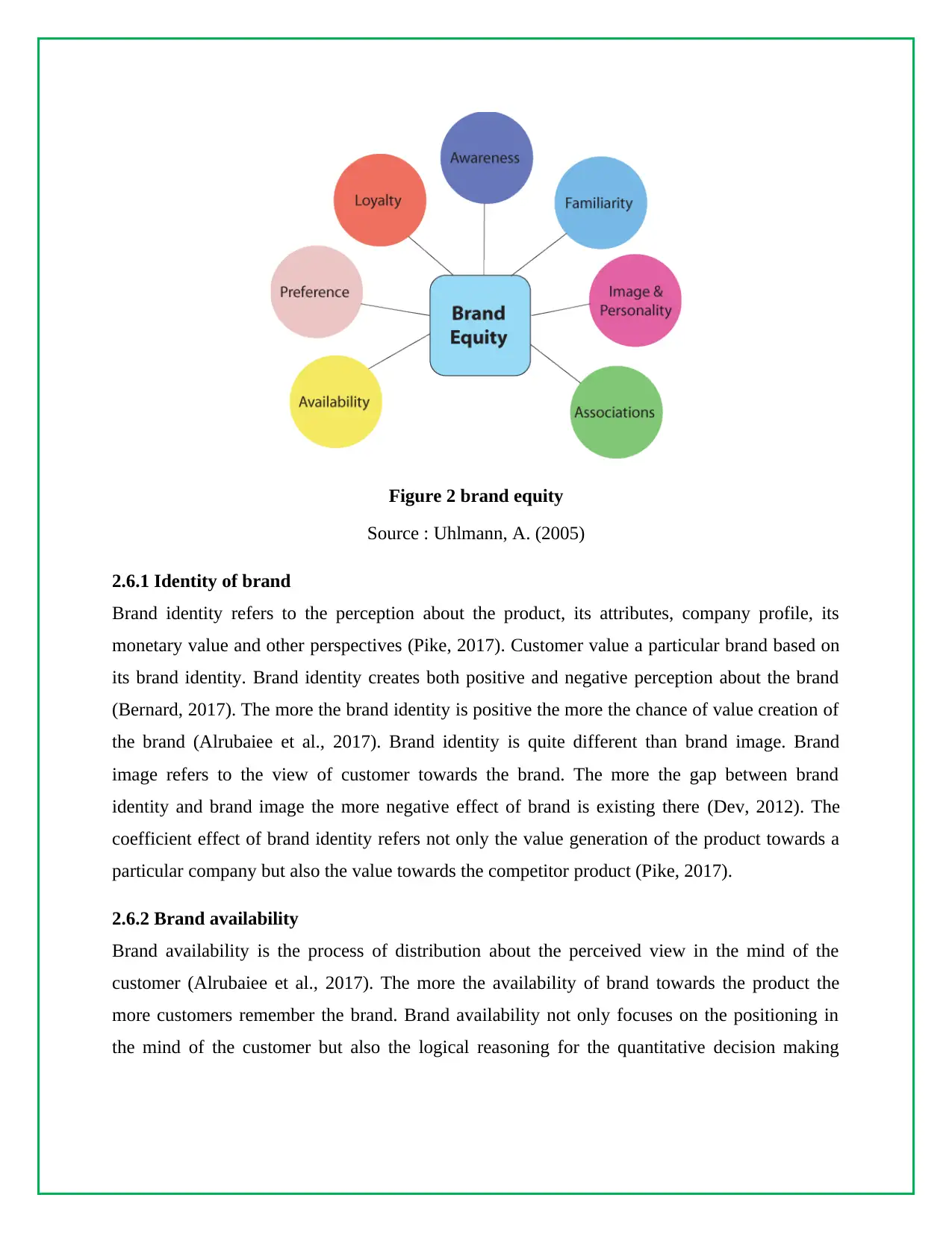
Source : Uhlmann, A. (2005)
2.6.1 Identity of brand
Brand identity refers to the perception about the product, its attributes, company profile, its
monetary value and other perspectives (Pike, 2017). Customer value a particular brand based on
its brand identity. Brand identity creates both positive and negative perception about the brand
(Bernard, 2017). The more the brand identity is positive the more the chance of value creation of
the brand (Alrubaiee et al., 2017). Brand identity is quite different than brand image. Brand
image refers to the view of customer towards the brand. The more the gap between brand
identity and brand image the more negative effect of brand is existing there (Dev, 2012). The
coefficient effect of brand identity refers not only the value generation of the product towards a
particular company but also the value towards the competitor product (Pike, 2017).
2.6.2 Brand availability
Brand availability is the process of distribution about the perceived view in the mind of the
customer (Alrubaiee et al., 2017). The more the availability of brand towards the product the
more customers remember the brand. Brand availability not only focuses on the positioning in
the mind of the customer but also the logical reasoning for the quantitative decision making
⊘ This is a preview!⊘
Do you want full access?
Subscribe today to unlock all pages.

Trusted by 1+ million students worldwide

reasoning, customer buyer box and the perceived association of the brand (Bernard, 2017).
2.6.3 Brand preference
Barefoot and Szabo (2010) finds that Brand preference or brand choice is the visible source of
comparison between the company brand and competitor brands. Brand preference shows the
position of brand in the marketplace among the competitor brand (Bernard, 2017). When
consumer chooses the company brand of Sainsbury PLC UK it means that brand preference of
Sainsbury PLC UK is higher than another brand available (Safko, 2013). Every company tries to
get higher brand preference. Higher brand preference is the key to create unique brand image and
possessive brand valuation (Brennen, 2017).
2.6.4 Brand loyalty
Brand loyalty is the customer repetitiveness about purchasing a particular company’s brand
(Tuten and Solomon, 2013). The loyal brand makes unique perception about the brand and
creates positive word of mouth communication about the brand (Bernard, 2017). Every company
tries to make their brand most loyal to the consumers(Pike, 2017). Brand loyalty guarantees the
repetitive purchasing of the particular brand and makes the brand positioning and brand equity
more valuable than ever (Tuten and Solomon, 2013). Barefoot and Szabo (2010) finds that Brand
loyalty is linked with previous experience with getting the momentum of psychological
satisfaction for desiring the product. Brand loyalty is attached with the branding value
proposition and creating the unique ambivalence of the satisfaction of the particular product
brand (Alrubaiee et al., 2017).
2.6.5 Brand image and personality
Brand image is the customers expected profile about the brand (Punjaisri and Wilson, 2017). The
personality of brand refers to the unique characteristics of brand that differentiates it from other
brand aptitudes. Brand image and brand personality is the process of creating brand value to the
overall process of brand value creation (Brennen, 2017). The identity of the brand makes the
ultimate result in the brand loyalty and brand association creates the momentum for brand image
and brand personality. The unique idea of brand image and personality creates value for the
overall creation of brand image identity ( Safko, 2013).
Paraphrase This Document
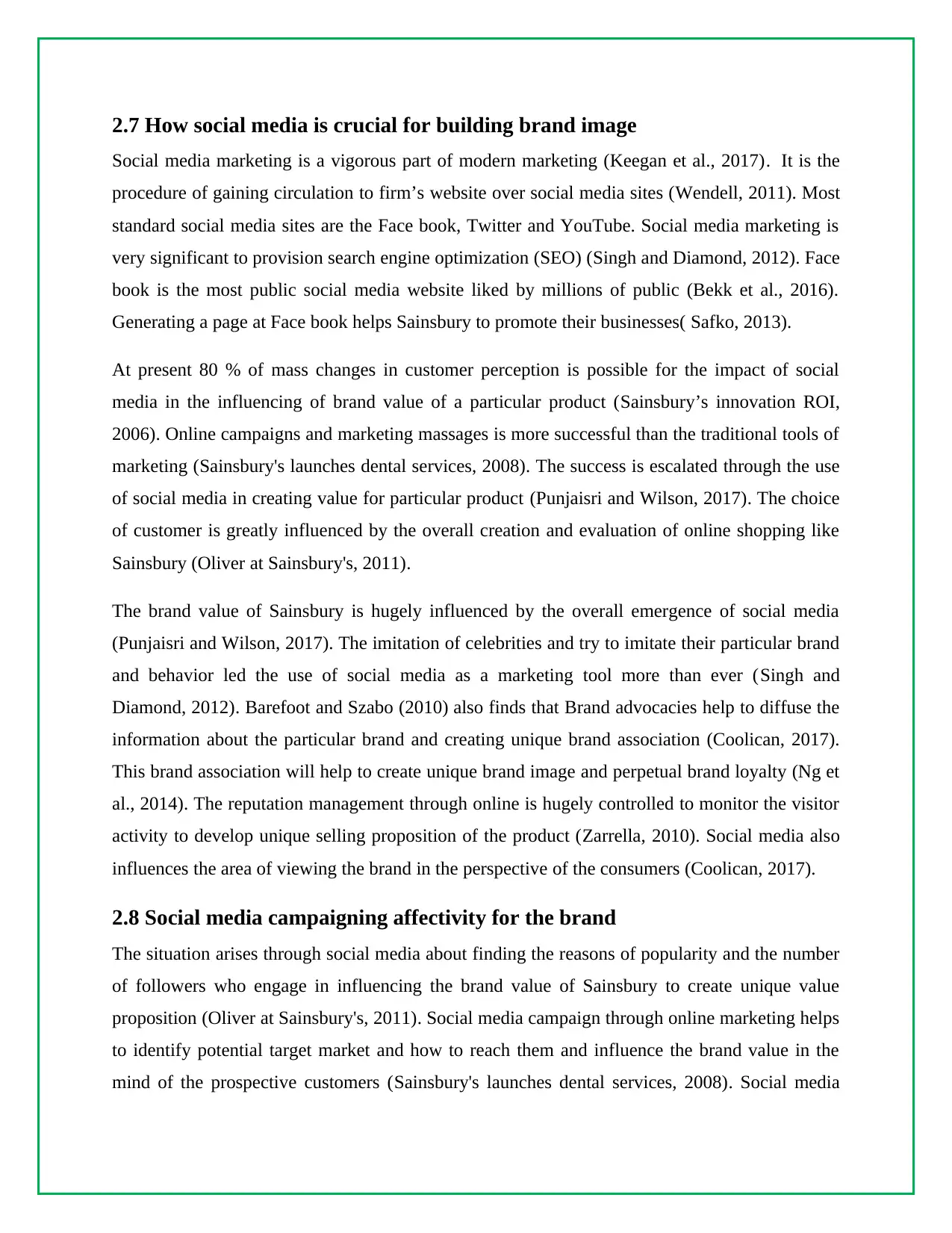
Social media marketing is a vigorous part of modern marketing (Keegan et al., 2017). It is the
procedure of gaining circulation to firm’s website over social media sites (Wendell, 2011). Most
standard social media sites are the Face book, Twitter and YouTube. Social media marketing is
very significant to provision search engine optimization (SEO) (Singh and Diamond, 2012). Face
book is the most public social media website liked by millions of public (Bekk et al., 2016).
Generating a page at Face book helps Sainsbury to promote their businesses( Safko, 2013).
At present 80 % of mass changes in customer perception is possible for the impact of social
media in the influencing of brand value of a particular product (Sainsbury’s innovation ROI,
2006). Online campaigns and marketing massages is more successful than the traditional tools of
marketing (Sainsbury's launches dental services, 2008). The success is escalated through the use
of social media in creating value for particular product (Punjaisri and Wilson, 2017). The choice
of customer is greatly influenced by the overall creation and evaluation of online shopping like
Sainsbury (Oliver at Sainsbury's, 2011).
The brand value of Sainsbury is hugely influenced by the overall emergence of social media
(Punjaisri and Wilson, 2017). The imitation of celebrities and try to imitate their particular brand
and behavior led the use of social media as a marketing tool more than ever (Singh and
Diamond, 2012). Barefoot and Szabo (2010) also finds that Brand advocacies help to diffuse the
information about the particular brand and creating unique brand association (Coolican, 2017).
This brand association will help to create unique brand image and perpetual brand loyalty (Ng et
al., 2014). The reputation management through online is hugely controlled to monitor the visitor
activity to develop unique selling proposition of the product (Zarrella, 2010). Social media also
influences the area of viewing the brand in the perspective of the consumers (Coolican, 2017).
2.8 Social media campaigning affectivity for the brand
The situation arises through social media about finding the reasons of popularity and the number
of followers who engage in influencing the brand value of Sainsbury to create unique value
proposition (Oliver at Sainsbury's, 2011). Social media campaign through online marketing helps
to identify potential target market and how to reach them and influence the brand value in the
mind of the prospective customers (Sainsbury's launches dental services, 2008). Social media
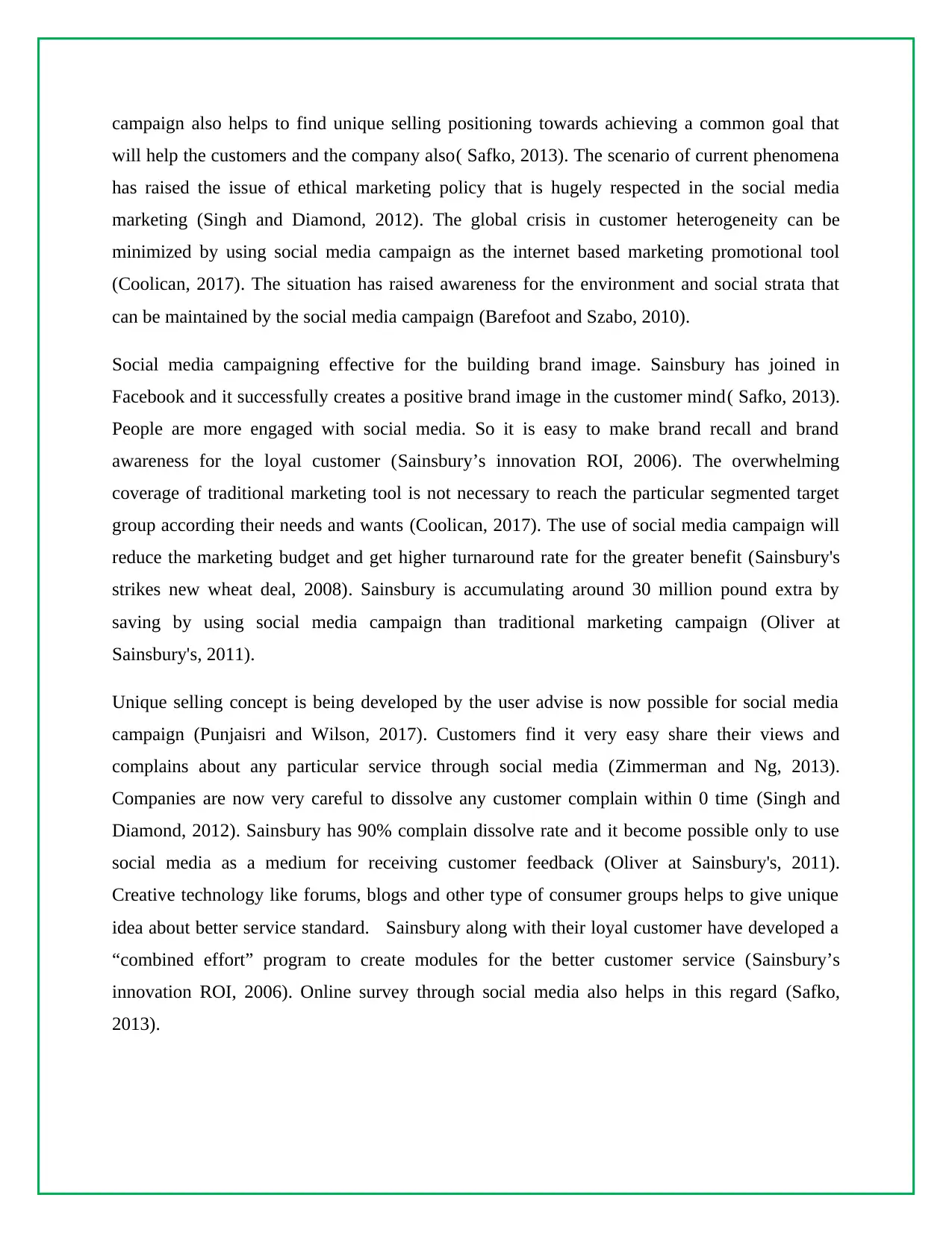
will help the customers and the company also( Safko, 2013). The scenario of current phenomena
has raised the issue of ethical marketing policy that is hugely respected in the social media
marketing (Singh and Diamond, 2012). The global crisis in customer heterogeneity can be
minimized by using social media campaign as the internet based marketing promotional tool
(Coolican, 2017). The situation has raised awareness for the environment and social strata that
can be maintained by the social media campaign (Barefoot and Szabo, 2010).
Social media campaigning effective for the building brand image. Sainsbury has joined in
Facebook and it successfully creates a positive brand image in the customer mind( Safko, 2013).
People are more engaged with social media. So it is easy to make brand recall and brand
awareness for the loyal customer (Sainsbury’s innovation ROI, 2006). The overwhelming
coverage of traditional marketing tool is not necessary to reach the particular segmented target
group according their needs and wants (Coolican, 2017). The use of social media campaign will
reduce the marketing budget and get higher turnaround rate for the greater benefit (Sainsbury's
strikes new wheat deal, 2008). Sainsbury is accumulating around 30 million pound extra by
saving by using social media campaign than traditional marketing campaign (Oliver at
Sainsbury's, 2011).
Unique selling concept is being developed by the user advise is now possible for social media
campaign (Punjaisri and Wilson, 2017). Customers find it very easy share their views and
complains about any particular service through social media (Zimmerman and Ng, 2013).
Companies are now very careful to dissolve any customer complain within 0 time (Singh and
Diamond, 2012). Sainsbury has 90% complain dissolve rate and it become possible only to use
social media as a medium for receiving customer feedback (Oliver at Sainsbury's, 2011).
Creative technology like forums, blogs and other type of consumer groups helps to give unique
idea about better service standard. Sainsbury along with their loyal customer have developed a
“combined effort” program to create modules for the better customer service (Sainsbury’s
innovation ROI, 2006). Online survey through social media also helps in this regard (Safko,
2013).
⊘ This is a preview!⊘
Do you want full access?
Subscribe today to unlock all pages.

Trusted by 1+ million students worldwide
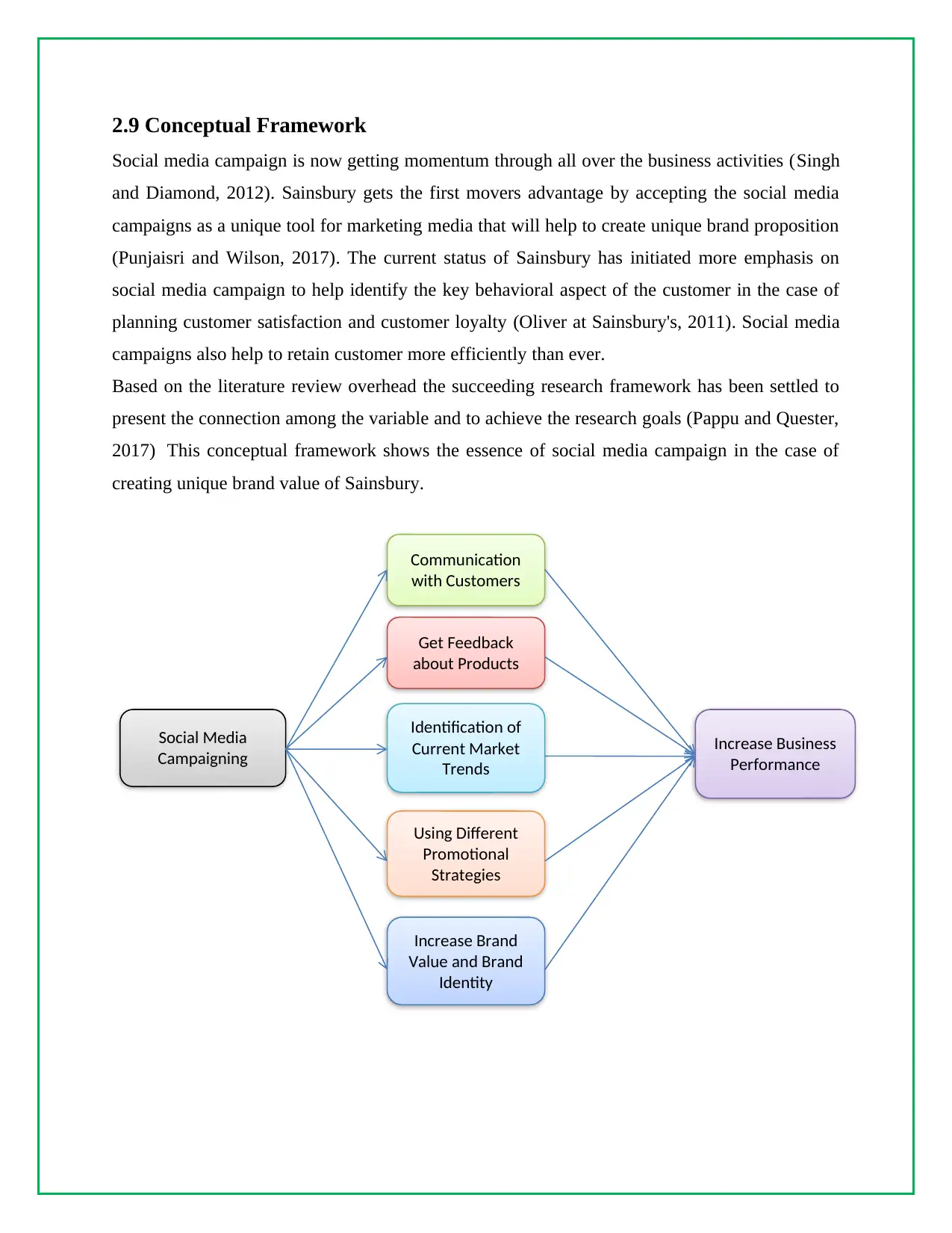
Social media campaign is now getting momentum through all over the business activities (Singh
and Diamond, 2012). Sainsbury gets the first movers advantage by accepting the social media
campaigns as a unique tool for marketing media that will help to create unique brand proposition
(Punjaisri and Wilson, 2017). The current status of Sainsbury has initiated more emphasis on
social media campaign to help identify the key behavioral aspect of the customer in the case of
planning customer satisfaction and customer loyalty (Oliver at Sainsbury's, 2011). Social media
campaigns also help to retain customer more efficiently than ever.
Based on the literature review overhead the succeeding research framework has been settled to
present the connection among the variable and to achieve the research goals (Pappu and Quester,
2017) This conceptual framework shows the essence of social media campaign in the case of
creating unique brand value of Sainsbury.
Social Media
Campaigning
Communication
with Customers
Get Feedback
about Products
Identification of
Current Market
Trends
Using Different
Promotional
Strategies
Increase Brand
Value and Brand
Identity
Increase Business
Performance
Paraphrase This Document
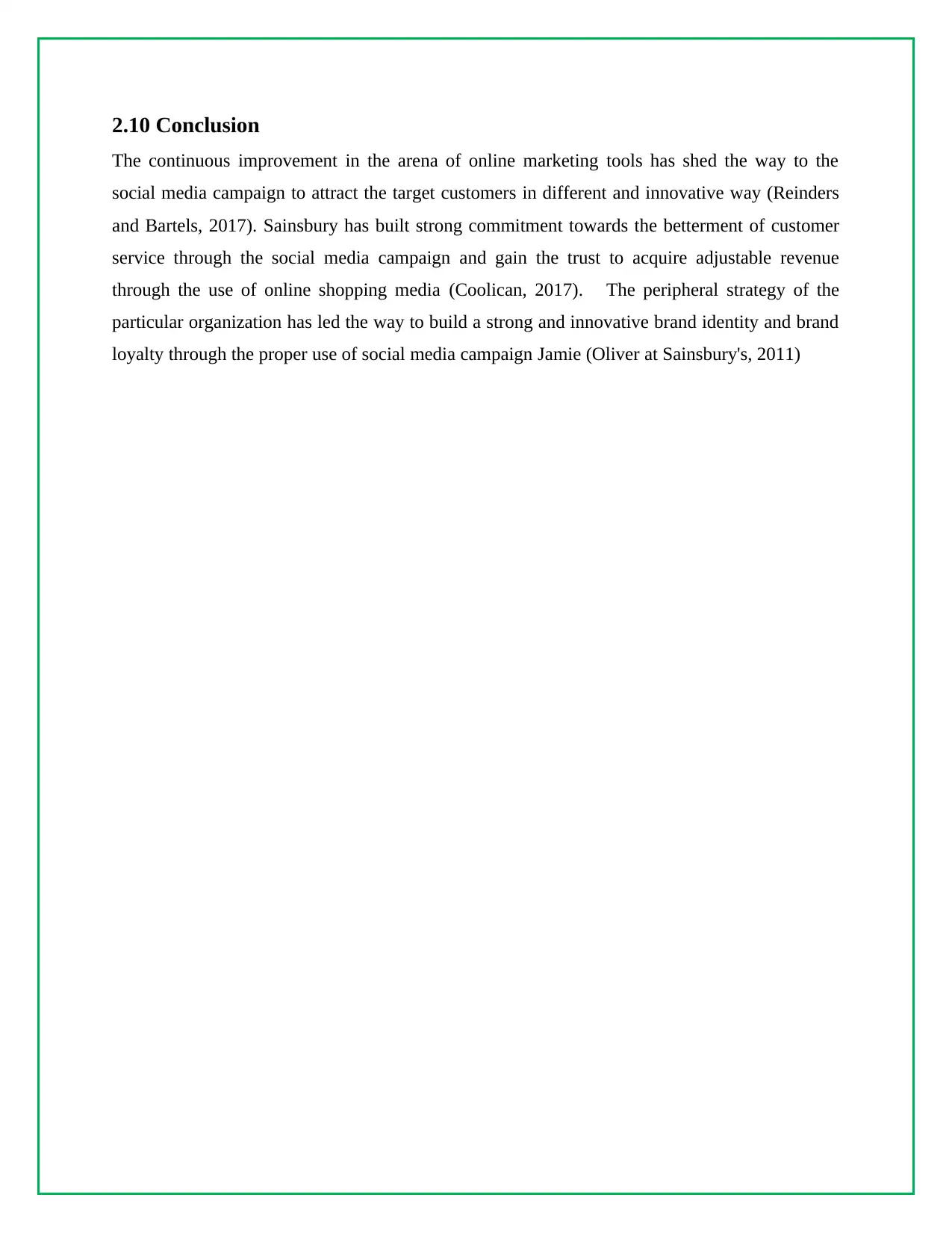
The continuous improvement in the arena of online marketing tools has shed the way to the
social media campaign to attract the target customers in different and innovative way (Reinders
and Bartels, 2017). Sainsbury has built strong commitment towards the betterment of customer
service through the social media campaign and gain the trust to acquire adjustable revenue
through the use of online shopping media (Coolican, 2017). The peripheral strategy of the
particular organization has led the way to build a strong and innovative brand identity and brand
loyalty through the proper use of social media campaign Jamie (Oliver at Sainsbury's, 2011)
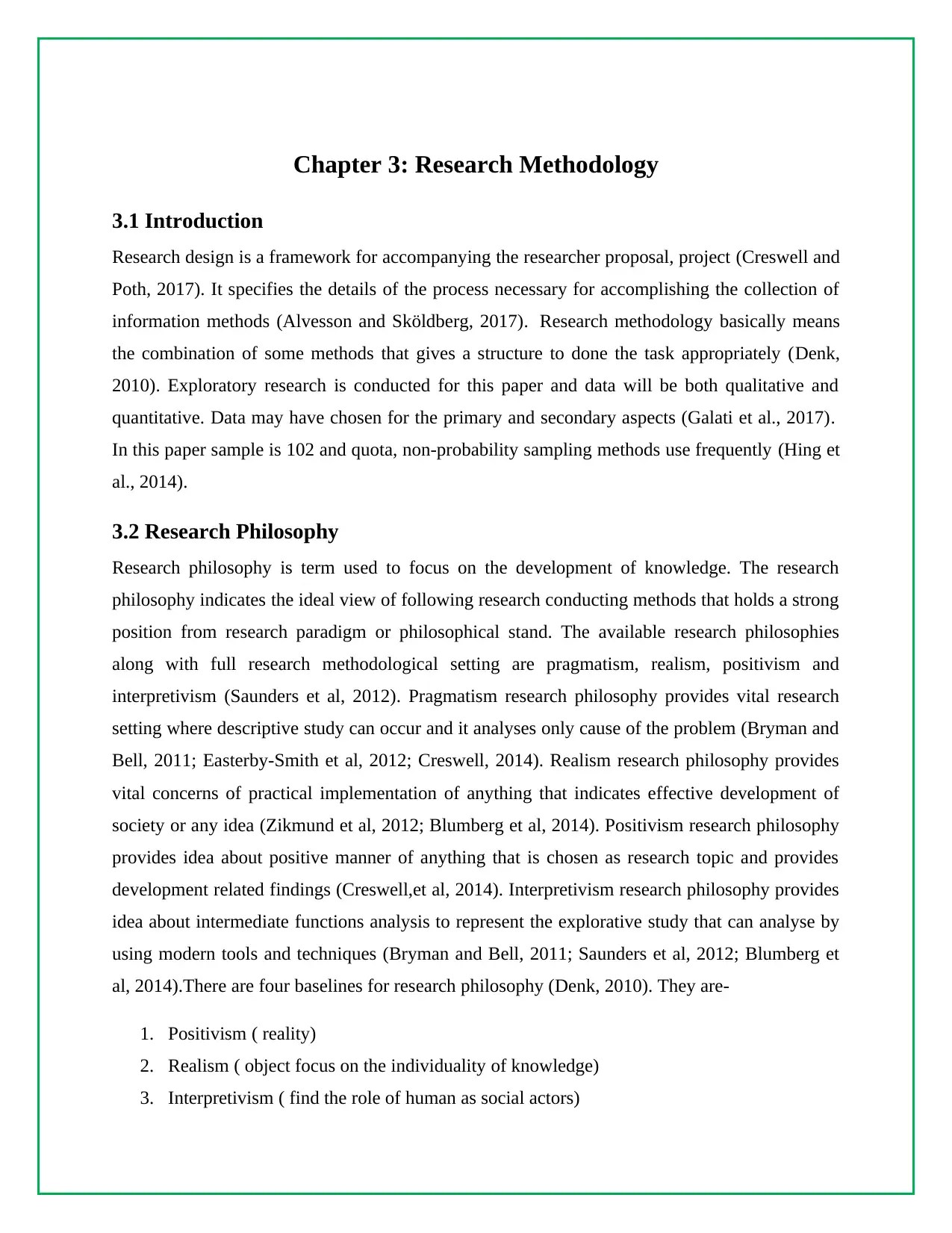
3.1 Introduction
Research design is a framework for accompanying the researcher proposal, project (Creswell and
Poth, 2017). It specifies the details of the process necessary for accomplishing the collection of
information methods (Alvesson and Sköldberg, 2017). Research methodology basically means
the combination of some methods that gives a structure to done the task appropriately (Denk,
2010). Exploratory research is conducted for this paper and data will be both qualitative and
quantitative. Data may have chosen for the primary and secondary aspects (Galati et al., 2017).
In this paper sample is 102 and quota, non-probability sampling methods use frequently (Hing et
al., 2014).
3.2 Research Philosophy
Research philosophy is term used to focus on the development of knowledge. The research
philosophy indicates the ideal view of following research conducting methods that holds a strong
position from research paradigm or philosophical stand. The available research philosophies
along with full research methodological setting are pragmatism, realism, positivism and
interpretivism (Saunders et al, 2012). Pragmatism research philosophy provides vital research
setting where descriptive study can occur and it analyses only cause of the problem (Bryman and
Bell, 2011; Easterby-Smith et al, 2012; Creswell, 2014). Realism research philosophy provides
vital concerns of practical implementation of anything that indicates effective development of
society or any idea (Zikmund et al, 2012; Blumberg et al, 2014). Positivism research philosophy
provides idea about positive manner of anything that is chosen as research topic and provides
development related findings (Creswell,et al, 2014). Interpretivism research philosophy provides
idea about intermediate functions analysis to represent the explorative study that can analyse by
using modern tools and techniques (Bryman and Bell, 2011; Saunders et al, 2012; Blumberg et
al, 2014).There are four baselines for research philosophy (Denk, 2010). They are-
1. Positivism ( reality)
2. Realism ( object focus on the individuality of knowledge)
3. Interpretivism ( find the role of human as social actors)
⊘ This is a preview!⊘
Do you want full access?
Subscribe today to unlock all pages.

Trusted by 1+ million students worldwide

Positivism is the logical reasoning and structural method for empirical decision for utilization of
human behaviour (Creswell and Poth, 2017). Realism is objective in nature. It exists
independently in human thought and nature (Alvesson and Sköldberg, 2017). Interpretivism is
the socally accepted behaviour based on subjective judgement and it may change through
multiple combination of variable (Galati et al., 2017).The concept of paradism consists of
ontology, epistemology and axiology. It is a basic combination of guidelines that calls for action
(Gobo, 2011).
3.2.1 Justification of Research Philosophy
The researcher uses positivism as the main philosophy for this particular research project (Denk,
2010). The current impact of social media in the brand value of Sainsbury is estimated through
this particular research philosophy to get the real phenomena and constant (Galati et al., 2017).
The variables will also help to create future prediction variables that will lay the example of the
rate of effectiveness in the case of strategic influence of social media campaign in the brand
identity of Sainsbury.
3.3 Research Approach
Any particular research problem can be solved by two type of research approach (Gobo, 2011).
They are
1. Inductive research approach
2. Deductive research approach
The former approach is the theoretical in nature (Alvesson and Sköldberg, 2017). Based on the
established general knowledge about any particular area a researcher can arrive at a specific
theory (Denk, 2010). This type of approach is much visible for the basic theoretical gathering of
common phenomena (Creswell and Poth, 2017). There are two research approaches are available
to conduct research work by following scientific procedure that can ensure proper investigation
of target research problem (Adams et al, 2014). The research nature based research approaches
setting is vital, two research approaches are inductive and deductive research approaches
(Blumberg et al, 2014). Inductive research approach is first hand research that ensures new
findings of research to build a new theory that can help to generate new knowledge (Creswell,
Paraphrase This Document
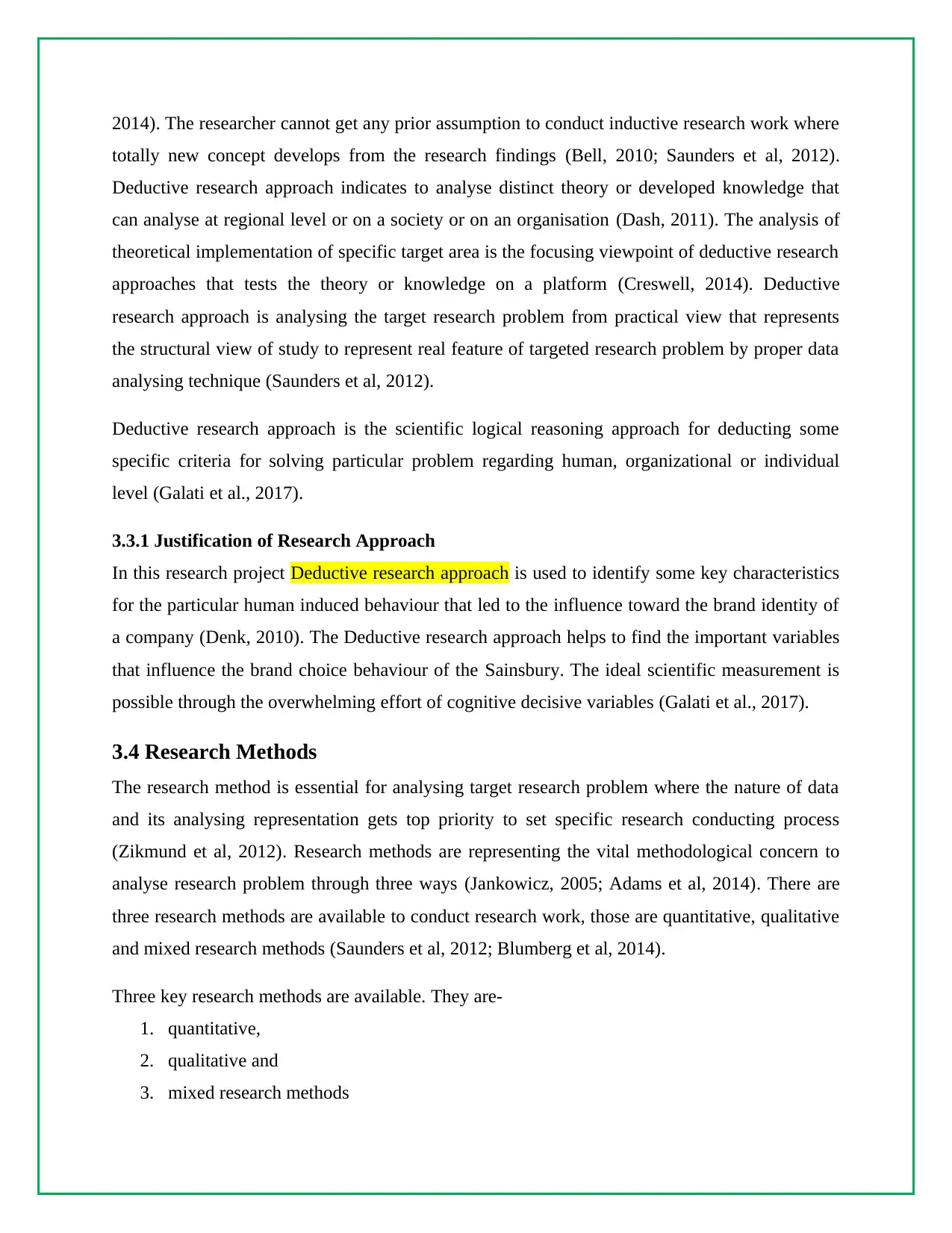
totally new concept develops from the research findings (Bell, 2010; Saunders et al, 2012).
Deductive research approach indicates to analyse distinct theory or developed knowledge that
can analyse at regional level or on a society or on an organisation (Dash, 2011). The analysis of
theoretical implementation of specific target area is the focusing viewpoint of deductive research
approaches that tests the theory or knowledge on a platform (Creswell, 2014). Deductive
research approach is analysing the target research problem from practical view that represents
the structural view of study to represent real feature of targeted research problem by proper data
analysing technique (Saunders et al, 2012).
Deductive research approach is the scientific logical reasoning approach for deducting some
specific criteria for solving particular problem regarding human, organizational or individual
level (Galati et al., 2017).
3.3.1 Justification of Research Approach
In this research project Deductive research approach is used to identify some key characteristics
for the particular human induced behaviour that led to the influence toward the brand identity of
a company (Denk, 2010). The Deductive research approach helps to find the important variables
that influence the brand choice behaviour of the Sainsbury. The ideal scientific measurement is
possible through the overwhelming effort of cognitive decisive variables (Galati et al., 2017).
3.4 Research Methods
The research method is essential for analysing target research problem where the nature of data
and its analysing representation gets top priority to set specific research conducting process
(Zikmund et al, 2012). Research methods are representing the vital methodological concern to
analyse research problem through three ways (Jankowicz, 2005; Adams et al, 2014). There are
three research methods are available to conduct research work, those are quantitative, qualitative
and mixed research methods (Saunders et al, 2012; Blumberg et al, 2014).
Three key research methods are available. They are-
1. quantitative,
2. qualitative and
3. mixed research methods
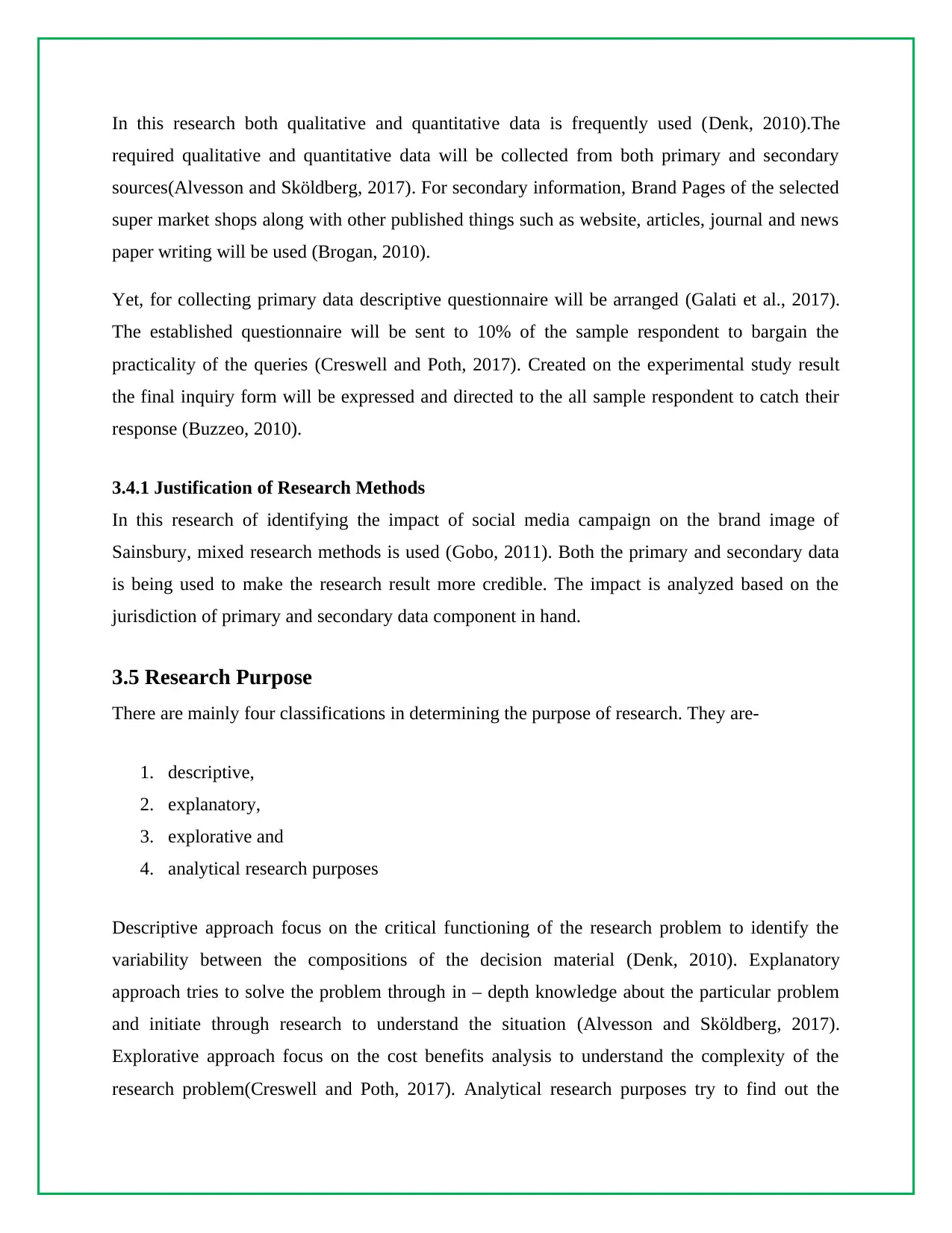
required qualitative and quantitative data will be collected from both primary and secondary
sources(Alvesson and Sköldberg, 2017). For secondary information, Brand Pages of the selected
super market shops along with other published things such as website, articles, journal and news
paper writing will be used (Brogan, 2010).
Yet, for collecting primary data descriptive questionnaire will be arranged (Galati et al., 2017).
The established questionnaire will be sent to 10% of the sample respondent to bargain the
practicality of the queries (Creswell and Poth, 2017). Created on the experimental study result
the final inquiry form will be expressed and directed to the all sample respondent to catch their
response (Buzzeo, 2010).
3.4.1 Justification of Research Methods
In this research of identifying the impact of social media campaign on the brand image of
Sainsbury, mixed research methods is used (Gobo, 2011). Both the primary and secondary data
is being used to make the research result more credible. The impact is analyzed based on the
jurisdiction of primary and secondary data component in hand.
3.5 Research Purpose
There are mainly four classifications in determining the purpose of research. They are-
1. descriptive,
2. explanatory,
3. explorative and
4. analytical research purposes
Descriptive approach focus on the critical functioning of the research problem to identify the
variability between the compositions of the decision material (Denk, 2010). Explanatory
approach tries to solve the problem through in – depth knowledge about the particular problem
and initiate through research to understand the situation (Alvesson and Sköldberg, 2017).
Explorative approach focus on the cost benefits analysis to understand the complexity of the
research problem(Creswell and Poth, 2017). Analytical research purposes try to find out the
⊘ This is a preview!⊘
Do you want full access?
Subscribe today to unlock all pages.

Trusted by 1+ million students worldwide

2011).
3.5.1 Justification of Research Purpose
This research uses the Explorative approach to find the internal characteristics of the influencing
behaviour relating the idea in social media. This approach helps to get eternal view of
Sainsbury’s marketing atmosphere to get the immediate approach.
3.6 Research Strategy
Research strategies help to scrutinize the research formula and solve the possible research
problem (Denk, 2010). Most important strategies are archival method, survey strategy, grounded
theory, ethnography policy, rural appraisals method (PRA – Participatory Rural Appraisal and
RRA – Rapid Rural Appraisal), FGD (Focus Group Discussion), Participant observation, case
study and experimental research strategy (Creswell and Poth, 2017).
Archival research is the secondary data processing methods that focus on the scientific decision
making based on the previous data methods available (Alvesson and Sköldberg, 2017). Survey
strategy is the primary method of data collection to identify the solution of research questions
and to create unique attribute to the research method (Galati et al., 2017). Grounded theory is
based on the geographical context of the research data to analyze and visualize the variables.
Ethnography policy is the contextual basis theory that focuses on the anthropology based on the
social context (Alvesson and Sköldberg, 2017). Rural appraisals method is the quantitative
structured method to identify some key variables toward the appraisal functioning of the project.
Case study method is the traditional way of research strategy that is focused on the behavioural
aspect through logical theory and cause – effect method (Gobo, 2011). Experimental research
strategy is done through qualitative research approach and focus on the in depth analysis, expert
interview and analysis of social contextual variables (LoBiondo-Wood and Haber, 2017).
3.6.1 Justification of Research Strategy
All of the strategies mentioned above except ethnography policy are used in this research to find
the interrelationship between the brand images building aspect through social media campaign.
Paraphrase This Document
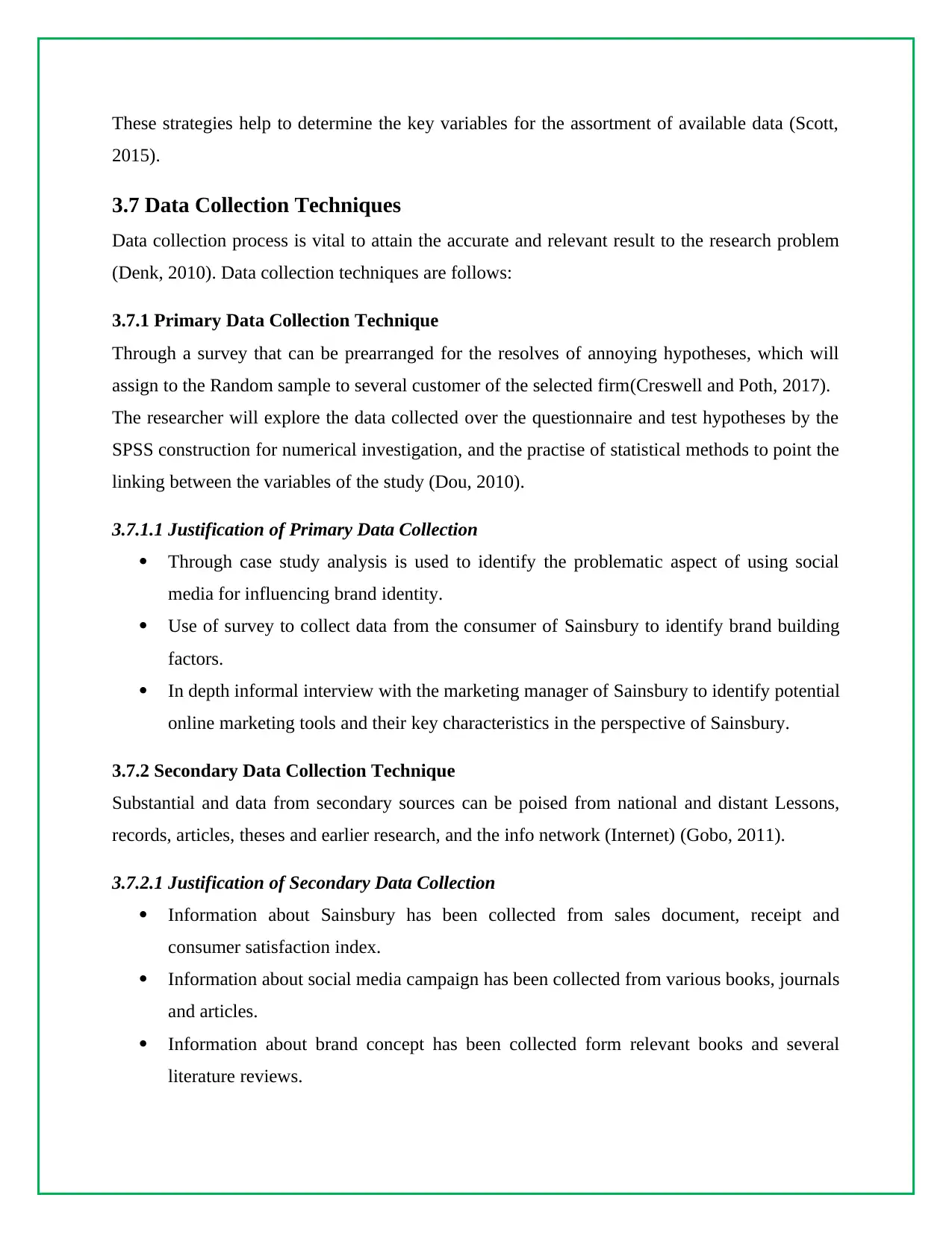
2015).
3.7 Data Collection Techniques
Data collection process is vital to attain the accurate and relevant result to the research problem
(Denk, 2010). Data collection techniques are follows:
3.7.1 Primary Data Collection Technique
Through a survey that can be prearranged for the resolves of annoying hypotheses, which will
assign to the Random sample to several customer of the selected firm(Creswell and Poth, 2017).
The researcher will explore the data collected over the questionnaire and test hypotheses by the
SPSS construction for numerical investigation, and the practise of statistical methods to point the
linking between the variables of the study (Dou, 2010).
3.7.1.1 Justification of Primary Data Collection
Through case study analysis is used to identify the problematic aspect of using social
media for influencing brand identity.
Use of survey to collect data from the consumer of Sainsbury to identify brand building
factors.
In depth informal interview with the marketing manager of Sainsbury to identify potential
online marketing tools and their key characteristics in the perspective of Sainsbury.
3.7.2 Secondary Data Collection Technique
Substantial and data from secondary sources can be poised from national and distant Lessons,
records, articles, theses and earlier research, and the info network (Internet) (Gobo, 2011).
3.7.2.1 Justification of Secondary Data Collection
Information about Sainsbury has been collected from sales document, receipt and
consumer satisfaction index.
Information about social media campaign has been collected from various books, journals
and articles.
Information about brand concept has been collected form relevant books and several
literature reviews.
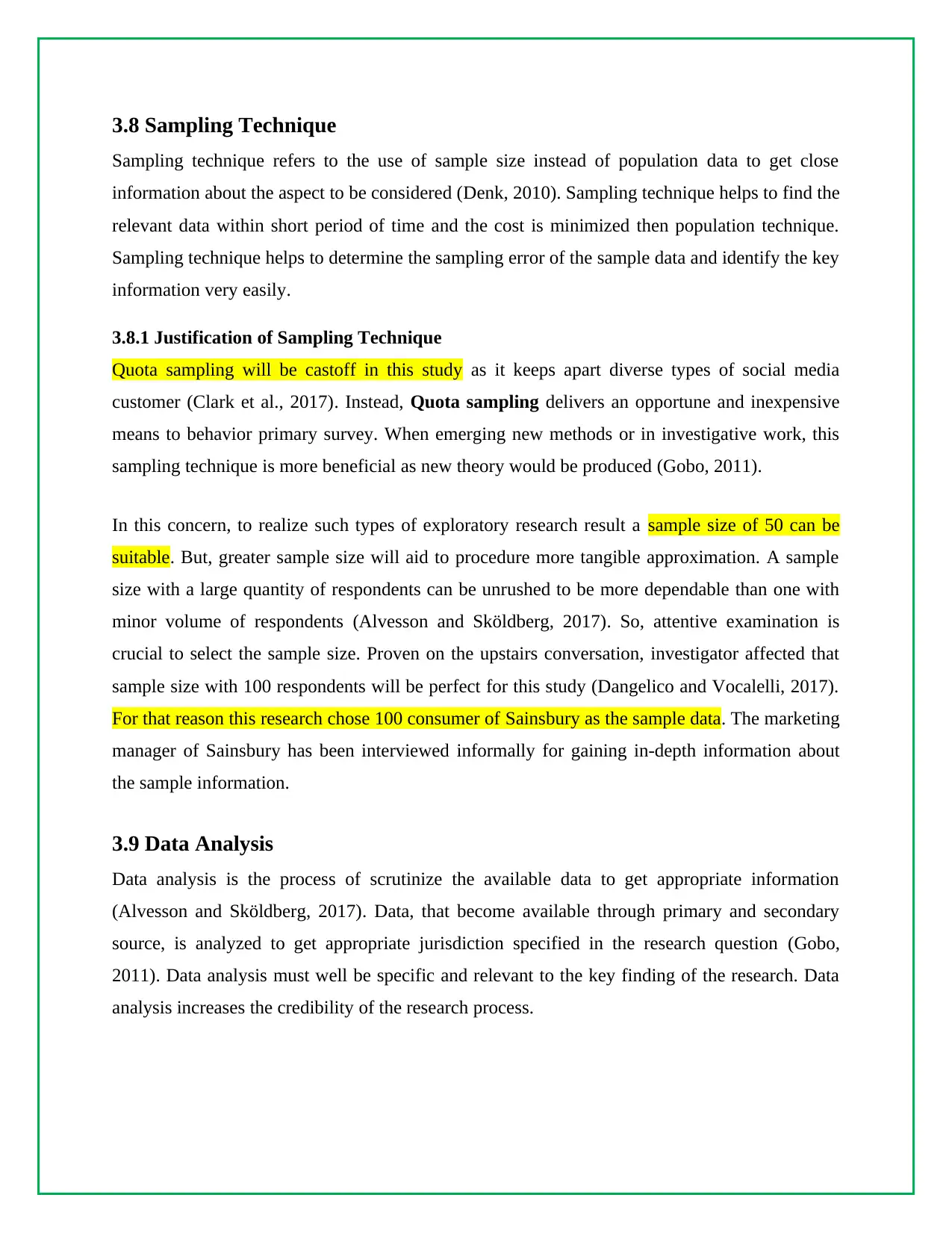
Sampling technique refers to the use of sample size instead of population data to get close
information about the aspect to be considered (Denk, 2010). Sampling technique helps to find the
relevant data within short period of time and the cost is minimized then population technique.
Sampling technique helps to determine the sampling error of the sample data and identify the key
information very easily.
3.8.1 Justification of Sampling Technique
Quota sampling will be castoff in this study as it keeps apart diverse types of social media
customer (Clark et al., 2017). Instead, Quota sampling delivers an opportune and inexpensive
means to behavior primary survey. When emerging new methods or in investigative work, this
sampling technique is more beneficial as new theory would be produced (Gobo, 2011).
In this concern, to realize such types of exploratory research result a sample size of 50 can be
suitable. But, greater sample size will aid to procedure more tangible approximation. A sample
size with a large quantity of respondents can be unrushed to be more dependable than one with
minor volume of respondents (Alvesson and Sköldberg, 2017). So, attentive examination is
crucial to select the sample size. Proven on the upstairs conversation, investigator affected that
sample size with 100 respondents will be perfect for this study (Dangelico and Vocalelli, 2017).
For that reason this research chose 100 consumer of Sainsbury as the sample data. The marketing
manager of Sainsbury has been interviewed informally for gaining in-depth information about
the sample information.
3.9 Data Analysis
Data analysis is the process of scrutinize the available data to get appropriate information
(Alvesson and Sköldberg, 2017). Data, that become available through primary and secondary
source, is analyzed to get appropriate jurisdiction specified in the research question (Gobo,
2011). Data analysis must well be specific and relevant to the key finding of the research. Data
analysis increases the credibility of the research process.
⊘ This is a preview!⊘
Do you want full access?
Subscribe today to unlock all pages.

Trusted by 1+ million students worldwide
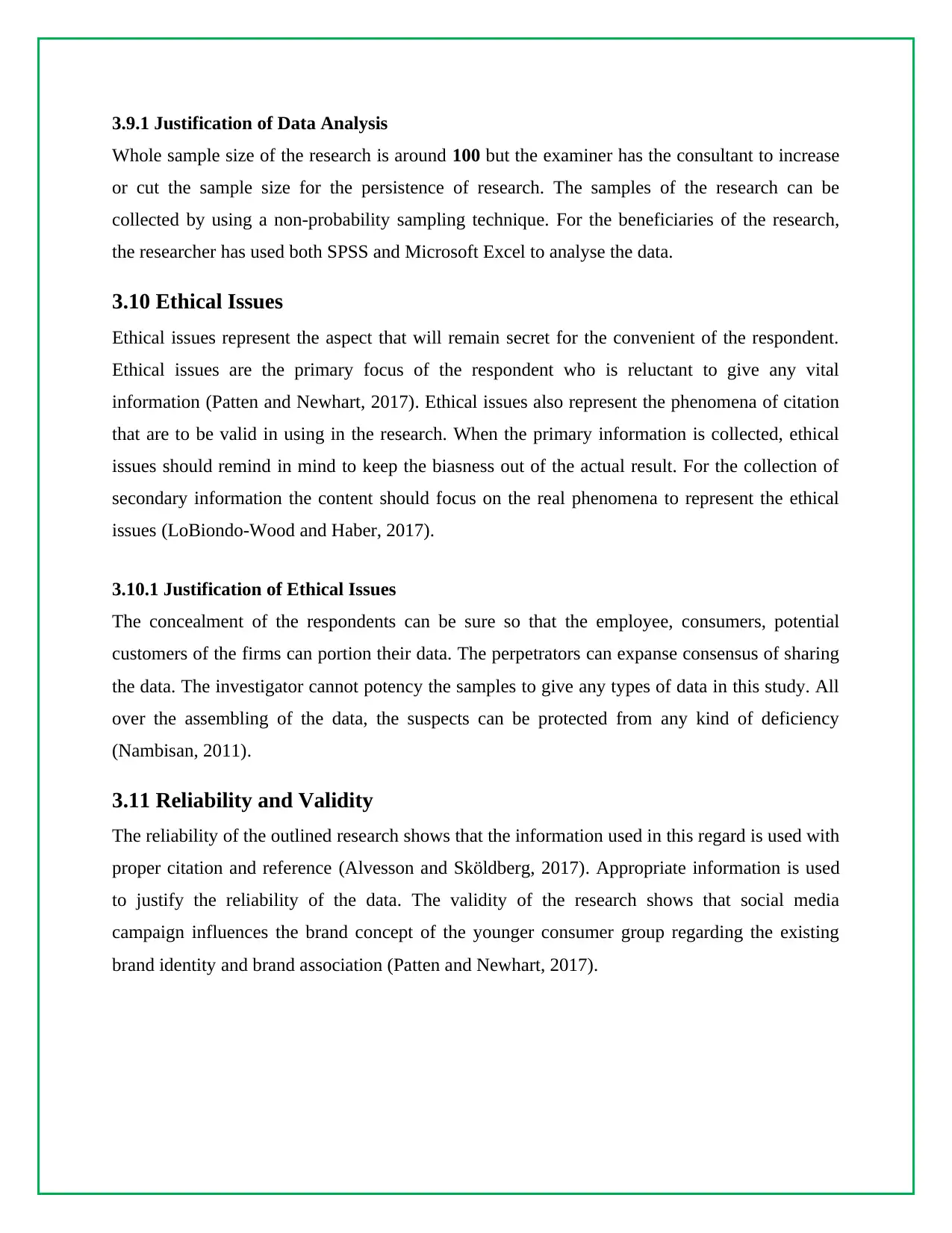
Whole sample size of the research is around 100 but the examiner has the consultant to increase
or cut the sample size for the persistence of research. The samples of the research can be
collected by using a non-probability sampling technique. For the beneficiaries of the research,
the researcher has used both SPSS and Microsoft Excel to analyse the data.
3.10 Ethical Issues
Ethical issues represent the aspect that will remain secret for the convenient of the respondent.
Ethical issues are the primary focus of the respondent who is reluctant to give any vital
information (Patten and Newhart, 2017). Ethical issues also represent the phenomena of citation
that are to be valid in using in the research. When the primary information is collected, ethical
issues should remind in mind to keep the biasness out of the actual result. For the collection of
secondary information the content should focus on the real phenomena to represent the ethical
issues (LoBiondo-Wood and Haber, 2017).
3.10.1 Justification of Ethical Issues
The concealment of the respondents can be sure so that the employee, consumers, potential
customers of the firms can portion their data. The perpetrators can expanse consensus of sharing
the data. The investigator cannot potency the samples to give any types of data in this study. All
over the assembling of the data, the suspects can be protected from any kind of deficiency
(Nambisan, 2011).
3.11 Reliability and Validity
The reliability of the outlined research shows that the information used in this regard is used with
proper citation and reference (Alvesson and Sköldberg, 2017). Appropriate information is used
to justify the reliability of the data. The validity of the research shows that social media
campaign influences the brand concept of the younger consumer group regarding the existing
brand identity and brand association (Patten and Newhart, 2017).
Paraphrase This Document
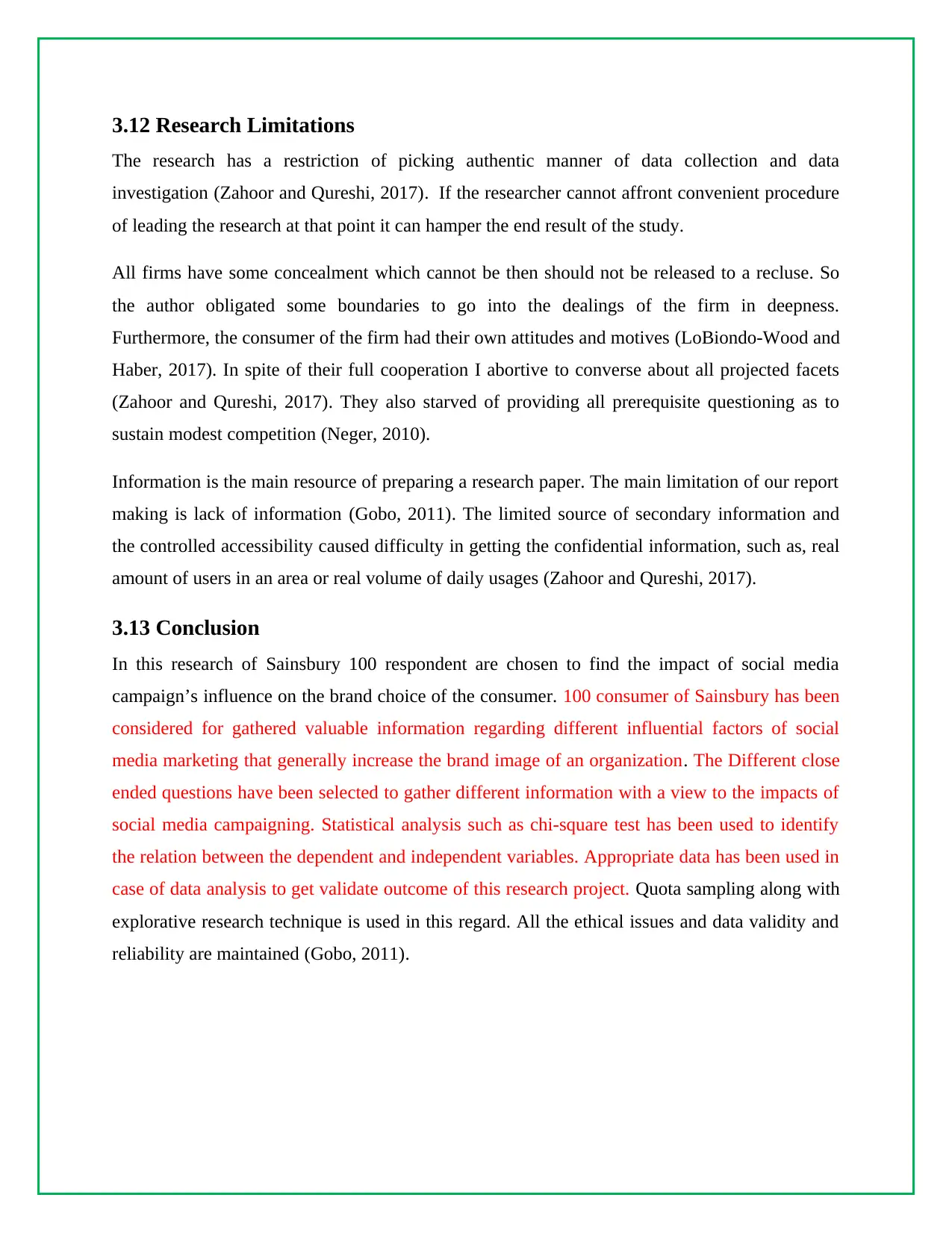
The research has a restriction of picking authentic manner of data collection and data
investigation (Zahoor and Qureshi, 2017). If the researcher cannot affront convenient procedure
of leading the research at that point it can hamper the end result of the study.
All firms have some concealment which cannot be then should not be released to a recluse. So
the author obligated some boundaries to go into the dealings of the firm in deepness.
Furthermore, the consumer of the firm had their own attitudes and motives (LoBiondo-Wood and
Haber, 2017). In spite of their full cooperation I abortive to converse about all projected facets
(Zahoor and Qureshi, 2017). They also starved of providing all prerequisite questioning as to
sustain modest competition (Neger, 2010).
Information is the main resource of preparing a research paper. The main limitation of our report
making is lack of information (Gobo, 2011). The limited source of secondary information and
the controlled accessibility caused difficulty in getting the confidential information, such as, real
amount of users in an area or real volume of daily usages (Zahoor and Qureshi, 2017).
3.13 Conclusion
In this research of Sainsbury 100 respondent are chosen to find the impact of social media
campaign’s influence on the brand choice of the consumer. 100 consumer of Sainsbury has been
considered for gathered valuable information regarding different influential factors of social
media marketing that generally increase the brand image of an organization. The Different close
ended questions have been selected to gather different information with a view to the impacts of
social media campaigning. Statistical analysis such as chi-square test has been used to identify
the relation between the dependent and independent variables. Appropriate data has been used in
case of data analysis to get validate outcome of this research project. Quota sampling along with
explorative research technique is used in this regard. All the ethical issues and data validity and
reliability are maintained (Gobo, 2011).

⊘ This is a preview!⊘
Do you want full access?
Subscribe today to unlock all pages.

Trusted by 1+ million students worldwide

4.1 Introduction
In this chapter primary data collected from consumers on social media campaigns have been
used to find level that influence the mind of customers. The survey results are shown using SPSS
and excel software. PRA findings are illustrated with appropriate qualitative formulation
(LoBiondo-Wood and Haber, 2017).
4.2 Findings of Questionnaire Survey
In this research first of all the demographic characteristics have been identified. The data showed
that 68.6 % of the respondents are male and 29.4% of the respondents are female. Though
Sainsbury is accessed by all groups of consumers, research data shows the percentage of male is
greater than the percentage of female.
Table 1 demographic character (sex)
sex
Frequency Percent Valid Percent Cumulative
Percent
Valid Male 70 68.6 70.0 70.0
female 30 29.4 30.0 100.0
Total 100 98.0 100.0
Missing System 2 2.0
Total 102 100.0
Then the researcher has identified another key demographic character age of the respondent in
following arena:
Table 2 Demographic character (Age)
age
Frequency Percent Valid Percent Cumulative
Percent
Valid 18-23 20 19.6 20.0 20.0
Paraphrase This Document
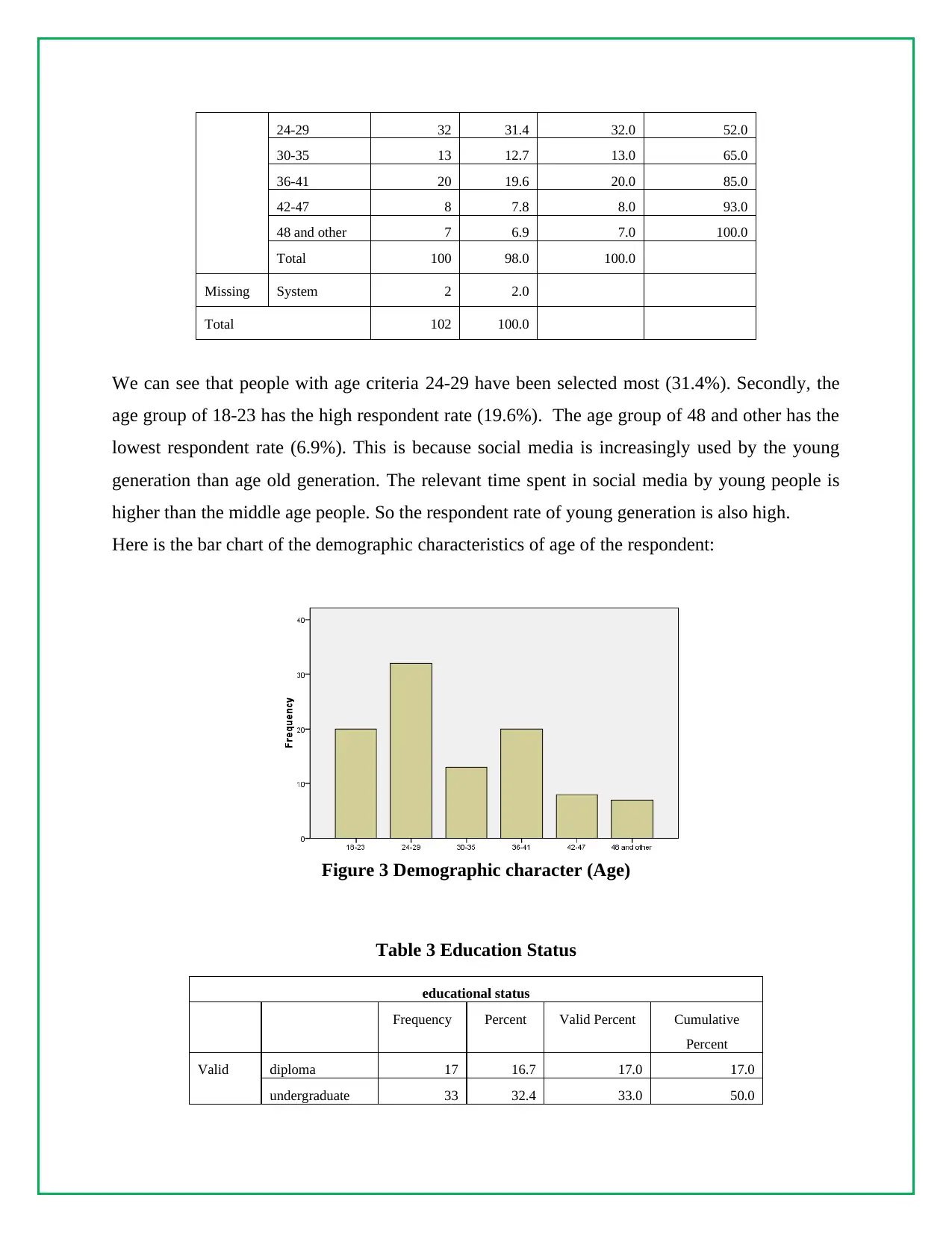
30-35 13 12.7 13.0 65.0
36-41 20 19.6 20.0 85.0
42-47 8 7.8 8.0 93.0
48 and other 7 6.9 7.0 100.0
Total 100 98.0 100.0
Missing System 2 2.0
Total 102 100.0
We can see that people with age criteria 24-29 have been selected most (31.4%). Secondly, the
age group of 18-23 has the high respondent rate (19.6%). The age group of 48 and other has the
lowest respondent rate (6.9%). This is because social media is increasingly used by the young
generation than age old generation. The relevant time spent in social media by young people is
higher than the middle age people. So the respondent rate of young generation is also high.
Here is the bar chart of the demographic characteristics of age of the respondent:
Figure 3 Demographic character (Age)
Table 3 Education Status
educational status
Frequency Percent Valid Percent Cumulative
Percent
Valid diploma 17 16.7 17.0 17.0
undergraduate 33 32.4 33.0 50.0
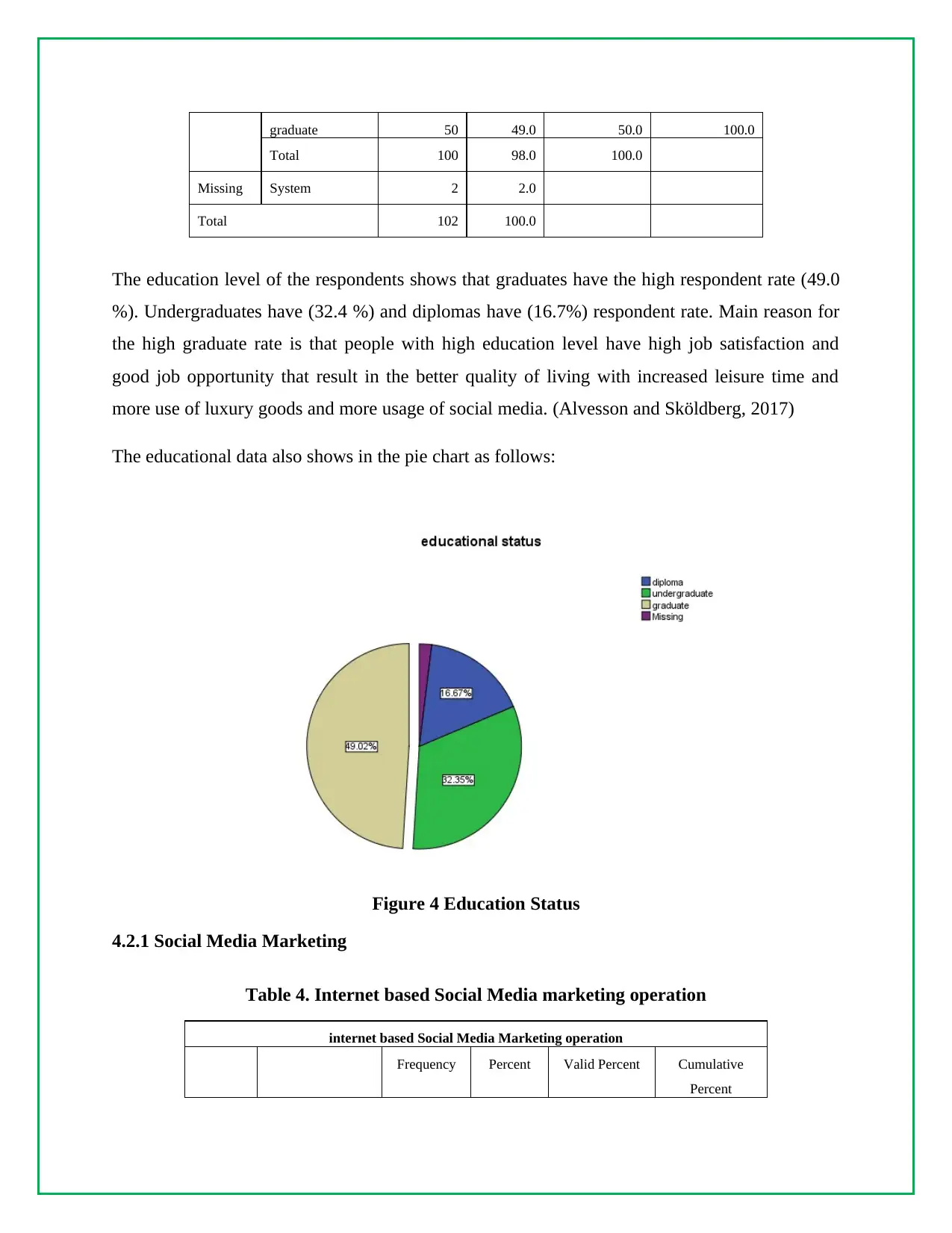
Total 100 98.0 100.0
Missing System 2 2.0
Total 102 100.0
The education level of the respondents shows that graduates have the high respondent rate (49.0
%). Undergraduates have (32.4 %) and diplomas have (16.7%) respondent rate. Main reason for
the high graduate rate is that people with high education level have high job satisfaction and
good job opportunity that result in the better quality of living with increased leisure time and
more use of luxury goods and more usage of social media. (Alvesson and Sköldberg, 2017)
The educational data also shows in the pie chart as follows:
Figure 4 Education Status
4.2.1 Social Media Marketing
Table 4. Internet based Social Media marketing operation
internet based Social Media Marketing operation
Frequency Percent Valid Percent Cumulative
Percent
⊘ This is a preview!⊘
Do you want full access?
Subscribe today to unlock all pages.

Trusted by 1+ million students worldwide
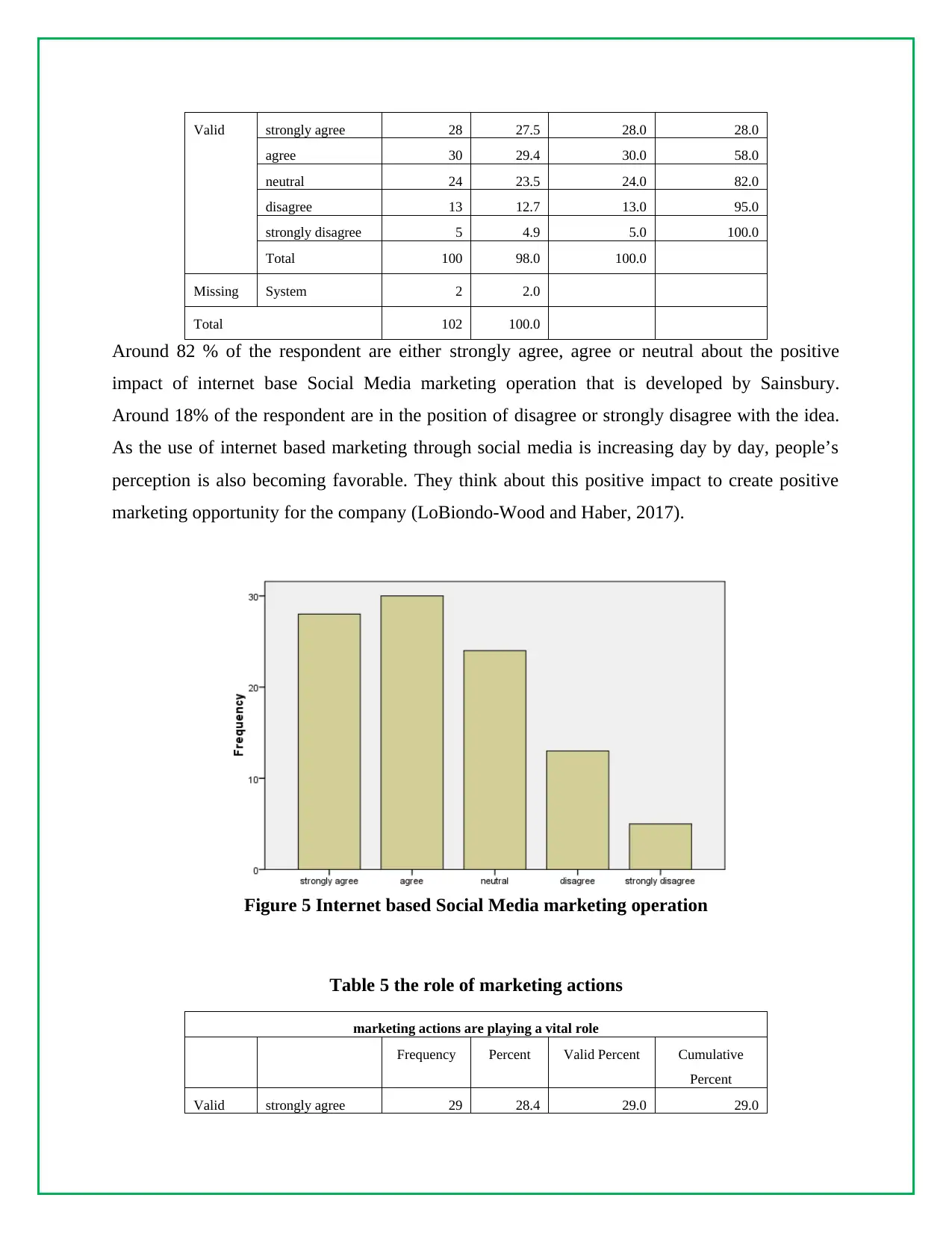
agree 30 29.4 30.0 58.0
neutral 24 23.5 24.0 82.0
disagree 13 12.7 13.0 95.0
strongly disagree 5 4.9 5.0 100.0
Total 100 98.0 100.0
Missing System 2 2.0
Total 102 100.0
Around 82 % of the respondent are either strongly agree, agree or neutral about the positive
impact of internet base Social Media marketing operation that is developed by Sainsbury.
Around 18% of the respondent are in the position of disagree or strongly disagree with the idea.
As the use of internet based marketing through social media is increasing day by day, people’s
perception is also becoming favorable. They think about this positive impact to create positive
marketing opportunity for the company (LoBiondo-Wood and Haber, 2017).
Figure 5 Internet based Social Media marketing operation
Table 5 the role of marketing actions
marketing actions are playing a vital role
Frequency Percent Valid Percent Cumulative
Percent
Valid strongly agree 29 28.4 29.0 29.0
Paraphrase This Document
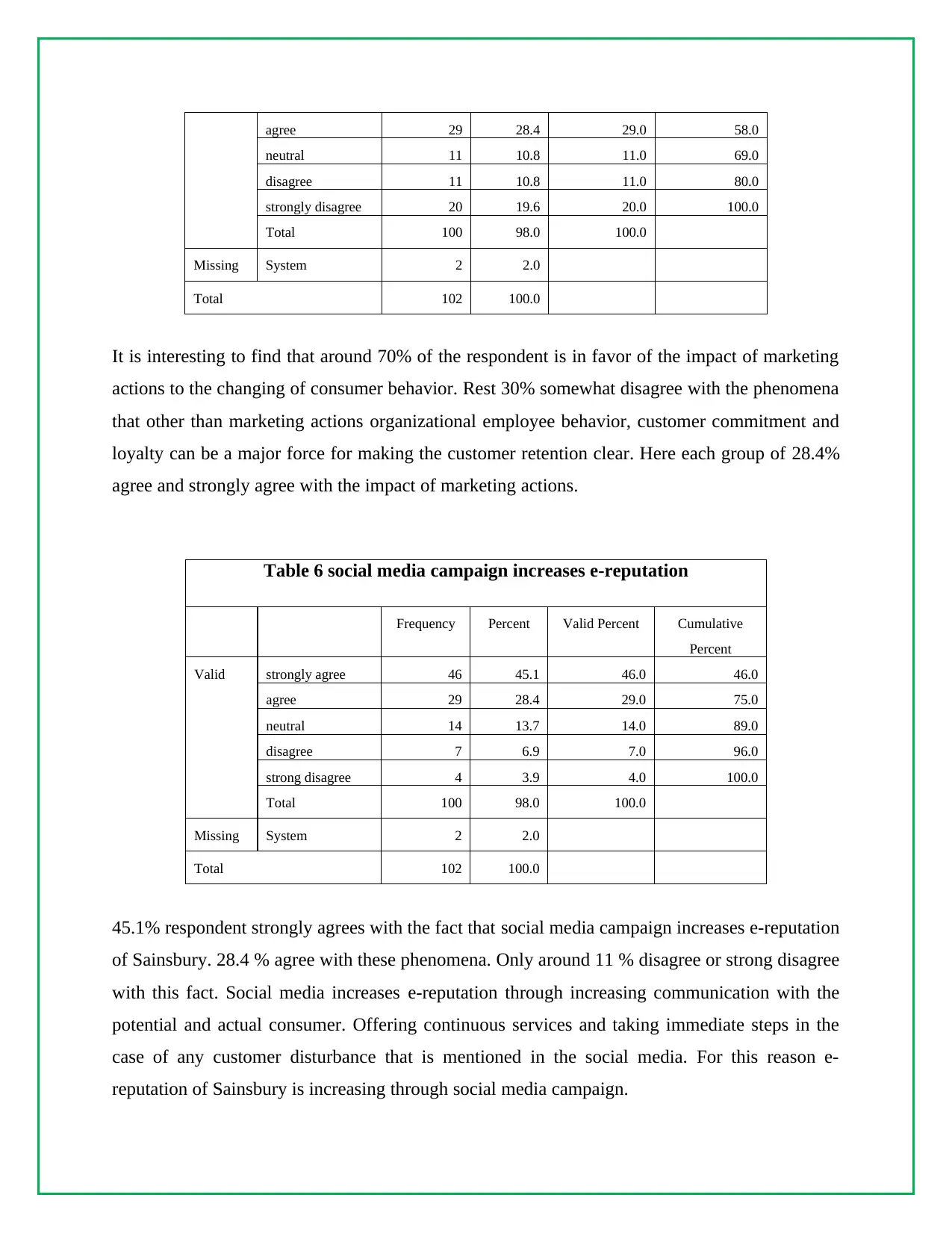
neutral 11 10.8 11.0 69.0
disagree 11 10.8 11.0 80.0
strongly disagree 20 19.6 20.0 100.0
Total 100 98.0 100.0
Missing System 2 2.0
Total 102 100.0
It is interesting to find that around 70% of the respondent is in favor of the impact of marketing
actions to the changing of consumer behavior. Rest 30% somewhat disagree with the phenomena
that other than marketing actions organizational employee behavior, customer commitment and
loyalty can be a major force for making the customer retention clear. Here each group of 28.4%
agree and strongly agree with the impact of marketing actions.
Table 6 social media campaign increases e-reputation
Frequency Percent Valid Percent Cumulative
Percent
Valid strongly agree 46 45.1 46.0 46.0
agree 29 28.4 29.0 75.0
neutral 14 13.7 14.0 89.0
disagree 7 6.9 7.0 96.0
strong disagree 4 3.9 4.0 100.0
Total 100 98.0 100.0
Missing System 2 2.0
Total 102 100.0
45.1% respondent strongly agrees with the fact that social media campaign increases e-reputation
of Sainsbury. 28.4 % agree with these phenomena. Only around 11 % disagree or strong disagree
with this fact. Social media increases e-reputation through increasing communication with the
potential and actual consumer. Offering continuous services and taking immediate steps in the
case of any customer disturbance that is mentioned in the social media. For this reason e-
reputation of Sainsbury is increasing through social media campaign.
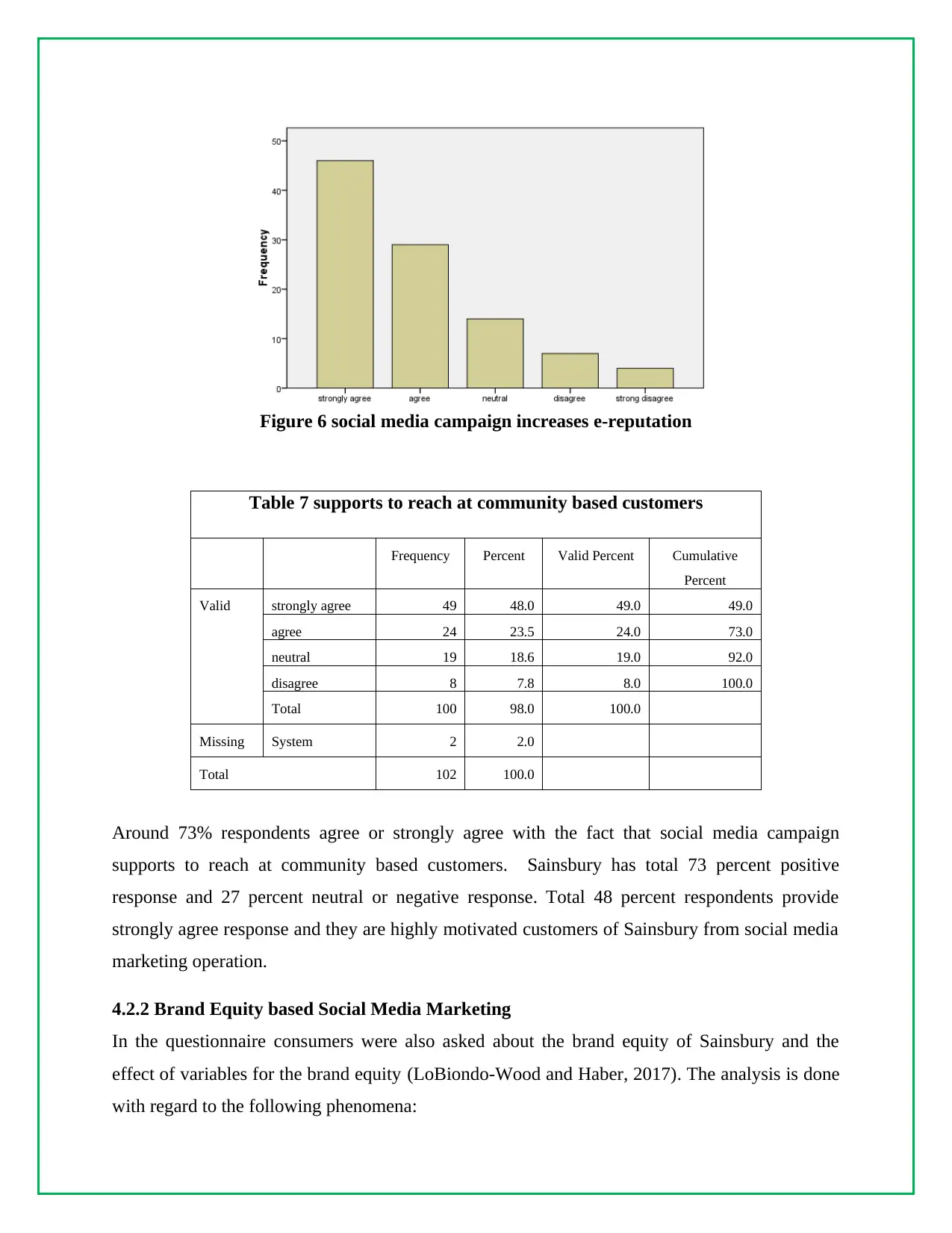
Table 7 supports to reach at community based customers
Frequency Percent Valid Percent Cumulative
Percent
Valid strongly agree 49 48.0 49.0 49.0
agree 24 23.5 24.0 73.0
neutral 19 18.6 19.0 92.0
disagree 8 7.8 8.0 100.0
Total 100 98.0 100.0
Missing System 2 2.0
Total 102 100.0
Around 73% respondents agree or strongly agree with the fact that social media campaign
supports to reach at community based customers. Sainsbury has total 73 percent positive
response and 27 percent neutral or negative response. Total 48 percent respondents provide
strongly agree response and they are highly motivated customers of Sainsbury from social media
marketing operation.
4.2.2 Brand Equity based Social Media Marketing
In the questionnaire consumers were also asked about the brand equity of Sainsbury and the
effect of variables for the brand equity (LoBiondo-Wood and Haber, 2017). The analysis is done
with regard to the following phenomena:
⊘ This is a preview!⊘
Do you want full access?
Subscribe today to unlock all pages.

Trusted by 1+ million students worldwide
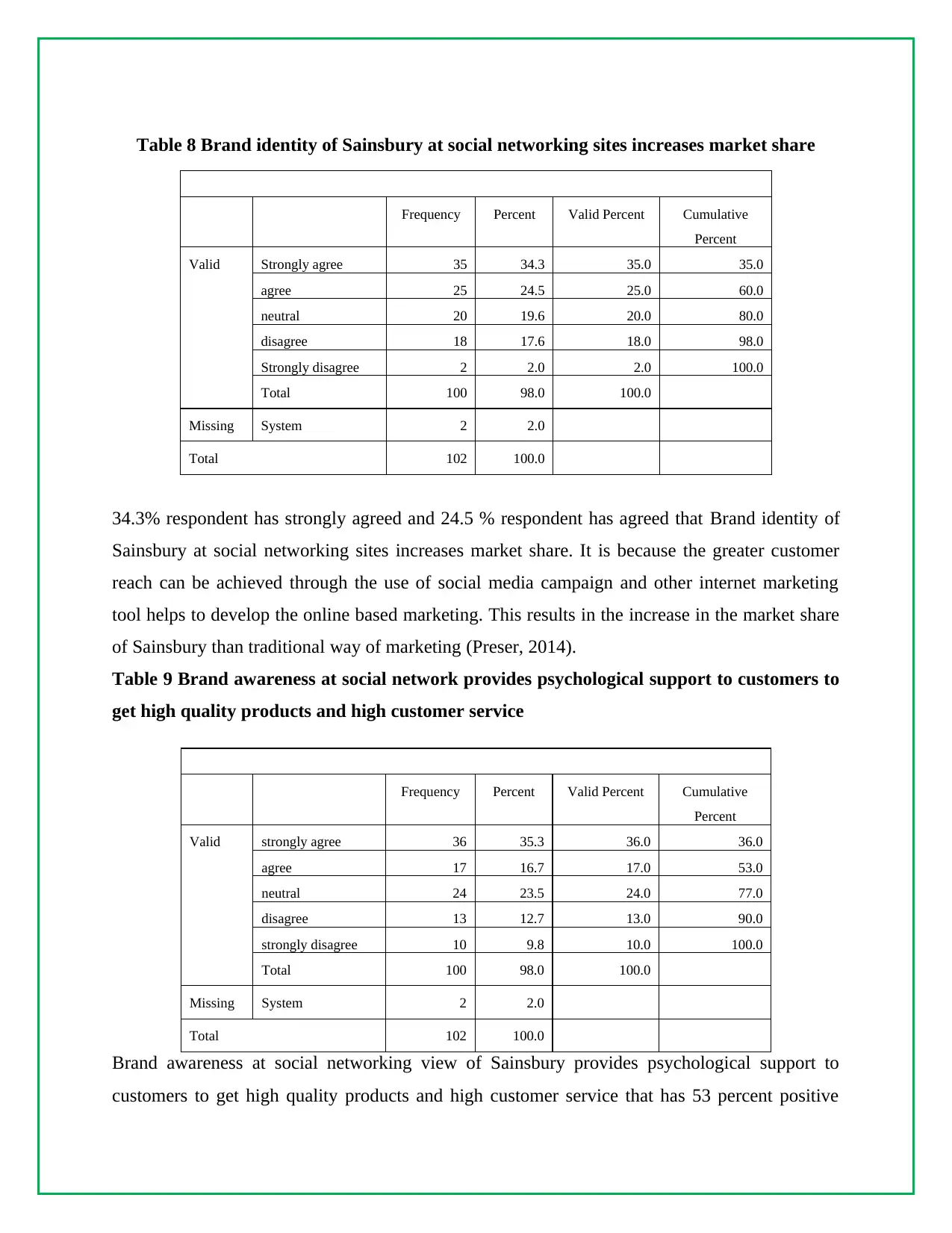
Frequency Percent Valid Percent Cumulative
Percent
Valid Strongly agree 35 34.3 35.0 35.0
agree 25 24.5 25.0 60.0
neutral 20 19.6 20.0 80.0
disagree 18 17.6 18.0 98.0
Strongly disagree 2 2.0 2.0 100.0
Total 100 98.0 100.0
Missing System 2 2.0
Total 102 100.0
34.3% respondent has strongly agreed and 24.5 % respondent has agreed that Brand identity of
Sainsbury at social networking sites increases market share. It is because the greater customer
reach can be achieved through the use of social media campaign and other internet marketing
tool helps to develop the online based marketing. This results in the increase in the market share
of Sainsbury than traditional way of marketing (Preser, 2014).
Table 9 Brand awareness at social network provides psychological support to customers to
get high quality products and high customer service
Frequency Percent Valid Percent Cumulative
Percent
Valid strongly agree 36 35.3 36.0 36.0
agree 17 16.7 17.0 53.0
neutral 24 23.5 24.0 77.0
disagree 13 12.7 13.0 90.0
strongly disagree 10 9.8 10.0 100.0
Total 100 98.0 100.0
Missing System 2 2.0
Total 102 100.0
Brand awareness at social networking view of Sainsbury provides psychological support to
customers to get high quality products and high customer service that has 53 percent positive
Paraphrase This Document

respondents are strongly agreeing and 17 percent respondents are agreeing that the customers are
getting psychological support brand awareness view to purchase goods from Sainsbury. As the
main expectation of the customers relay in the ultimate use of the goods and the post purchase
behaviour, Sainsbury should increase its efficiency in the point of sales service area. Although
social media will create brand awareness but the key success will relay upon the experience in
the point of sales area (Preser, 2014).
Figure 7 Brand awareness at social network provides psychological support to customers to
get high quality products and high customer service
Table 10 Brand association increases financial value of brand at social networking
sites
Brand association increases financial value of brand
Frequency Percent Valid Percent Cumulative
Percent
Valid strongly agree 45 44.1 45.0 45.0
agree 49 48.0 49.0 94.0
neutral 3 2.9 3.0 97.0
disagree 1 1.0 1.0 98.0
strongly disagree 2 2.0 2.0 100.0
Total 100 98.0 100.0
Missing System 2 2.0

Increase in brand collaboration of associations also increase increases financial value of brand
has analysed from customer’s viewpoint where total 94 percent respondents provide positive
response, 3 percent neutral response and 2 percent negative response. Total 45 percent
respondents are strongly agreeing and 49 percent respondents are agreeing that brand association
of Sainsbury at social media marketing operation increases financial value of brand. Total 3
percent respondents are disagreeing and strongly disagreeing the brand association has low
improvement of financial value of brand (Preser, 2014). The ultimate low cost marketing
approach of social media campaign helps to create unique brand association.
Table 11 Perceived quality is the superiority of ultimate compel of customers choosing
Sainsbury
Frequency Percent Valid Percent Cumulative
Percent
Valid strongly agree 40 39.2 40.0 40.0
agree 38 37.3 38.0 78.0
neutral 20 19.6 20.0 98.0
disagree 2 2.0 2.0 100.0
Total 100 98.0 100.0
Missing System 2 2.0
Total 102 100.0
Perceived quality is the superiority of ultimate compel of customers choosing Sainsbury brand in
future that has 78 percent positive response, 20 percent neutral response and only 2 percent
negative response. Total 40 percent respondents are strongly agreeing and 38 percent
respondents are agreeing that Sainsbury customers have high perceived quality to compel the
brand for future purchase. Total 2 percent respondents provide disagree comment and they think
perceived quality of customers remain low.
4.2.3 Customers Buying Behaviour influencing from Social Media Marketing
⊘ This is a preview!⊘
Do you want full access?
Subscribe today to unlock all pages.

Trusted by 1+ million students worldwide
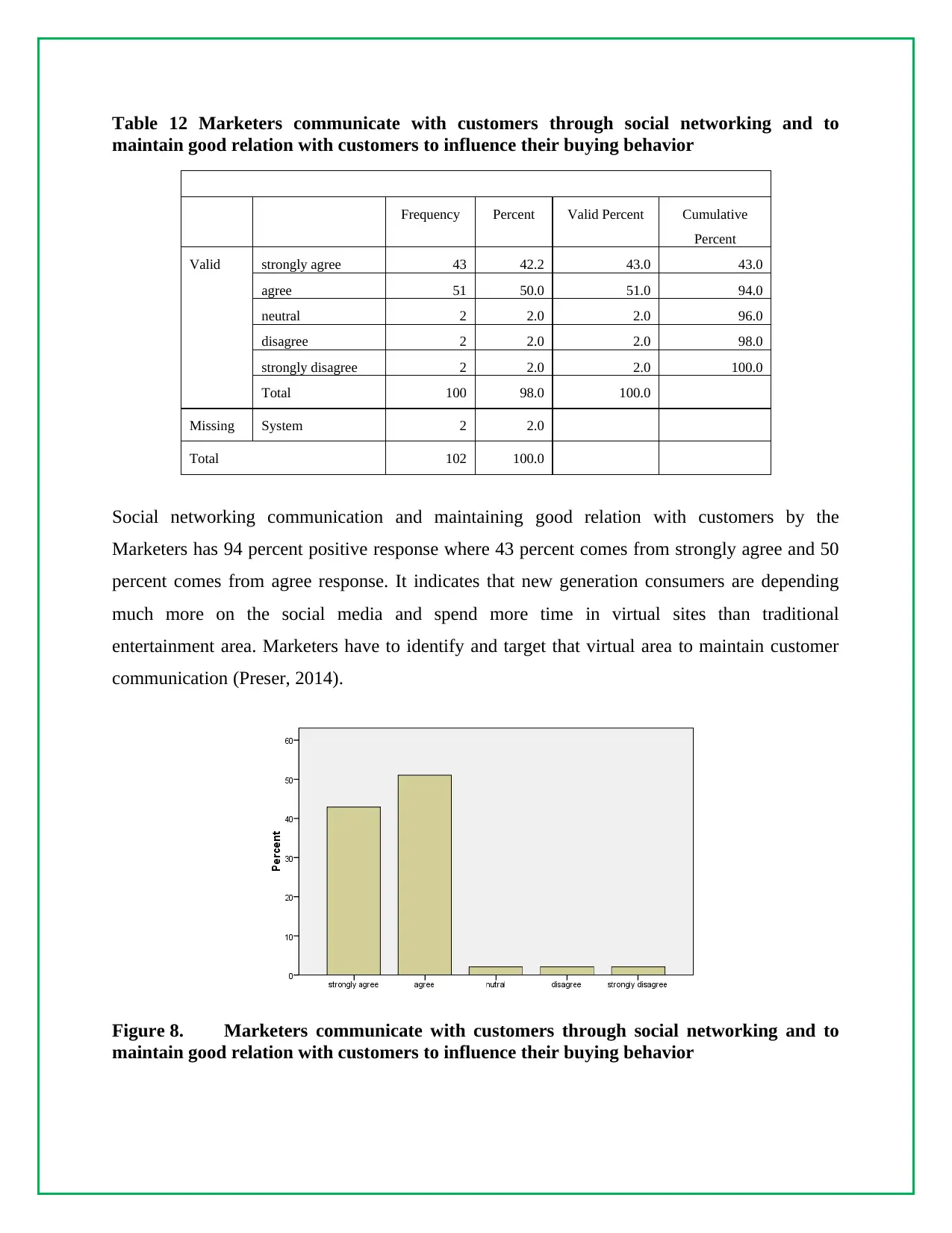
maintain good relation with customers to influence their buying behavior
Frequency Percent Valid Percent Cumulative
Percent
Valid strongly agree 43 42.2 43.0 43.0
agree 51 50.0 51.0 94.0
neutral 2 2.0 2.0 96.0
disagree 2 2.0 2.0 98.0
strongly disagree 2 2.0 2.0 100.0
Total 100 98.0 100.0
Missing System 2 2.0
Total 102 100.0
Social networking communication and maintaining good relation with customers by the
Marketers has 94 percent positive response where 43 percent comes from strongly agree and 50
percent comes from agree response. It indicates that new generation consumers are depending
much more on the social media and spend more time in virtual sites than traditional
entertainment area. Marketers have to identify and target that virtual area to maintain customer
communication (Preser, 2014).
Figure 8. Marketers communicate with customers through social networking and to
maintain good relation with customers to influence their buying behavior
Paraphrase This Document
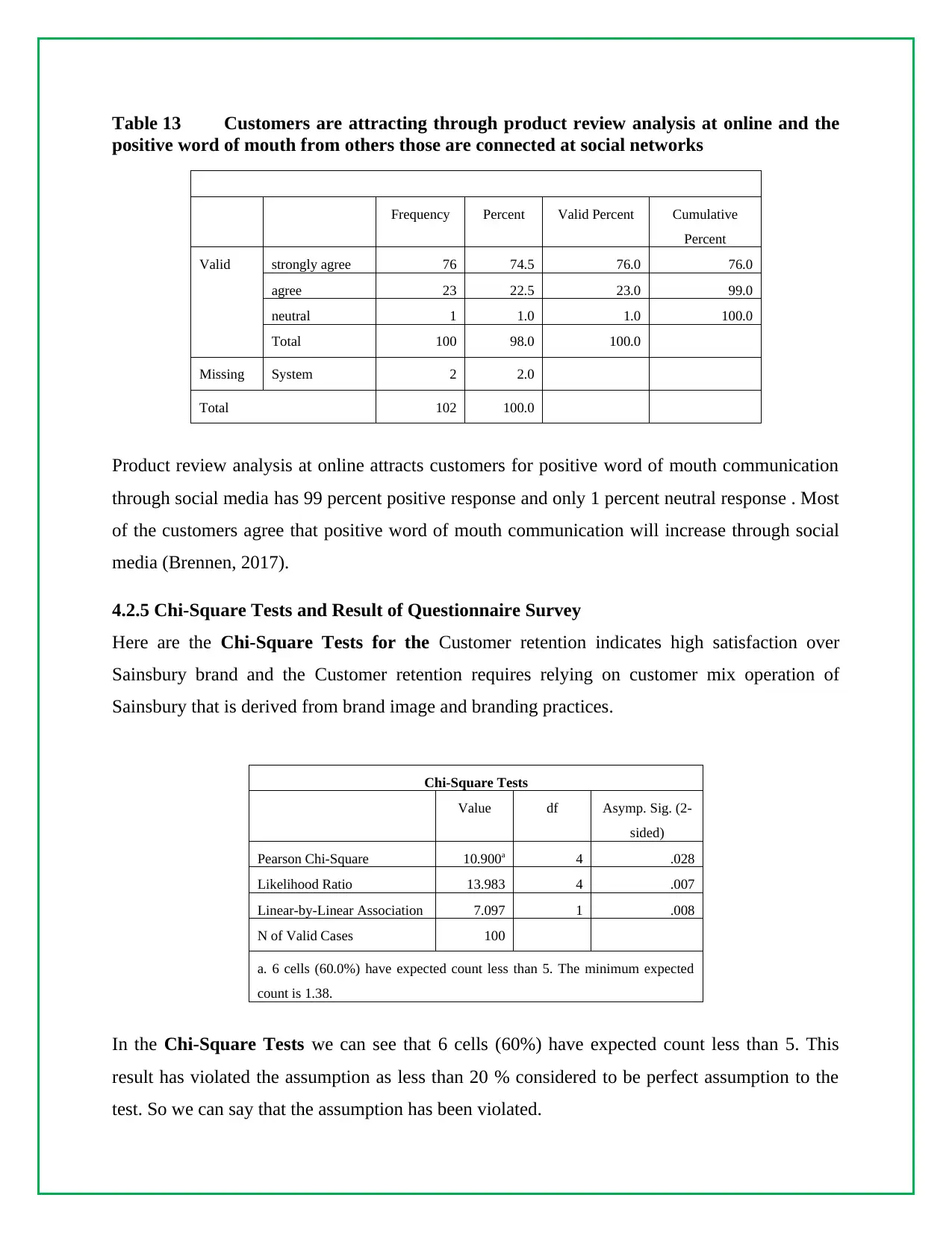
positive word of mouth from others those are connected at social networks
Frequency Percent Valid Percent Cumulative
Percent
Valid strongly agree 76 74.5 76.0 76.0
agree 23 22.5 23.0 99.0
neutral 1 1.0 1.0 100.0
Total 100 98.0 100.0
Missing System 2 2.0
Total 102 100.0
Product review analysis at online attracts customers for positive word of mouth communication
through social media has 99 percent positive response and only 1 percent neutral response . Most
of the customers agree that positive word of mouth communication will increase through social
media (Brennen, 2017).
4.2.5 Chi-Square Tests and Result of Questionnaire Survey
Here are the Chi-Square Tests for the Customer retention indicates high satisfaction over
Sainsbury brand and the Customer retention requires relying on customer mix operation of
Sainsbury that is derived from brand image and branding practices.
Chi-Square Tests
Value df Asymp. Sig. (2-
sided)
Pearson Chi-Square 10.900a 4 .028
Likelihood Ratio 13.983 4 .007
Linear-by-Linear Association 7.097 1 .008
N of Valid Cases 100
a. 6 cells (60.0%) have expected count less than 5. The minimum expected
count is 1.38.
In the Chi-Square Tests we can see that 6 cells (60%) have expected count less than 5. This
result has violated the assumption as less than 20 % considered to be perfect assumption to the
test. So we can say that the assumption has been violated.
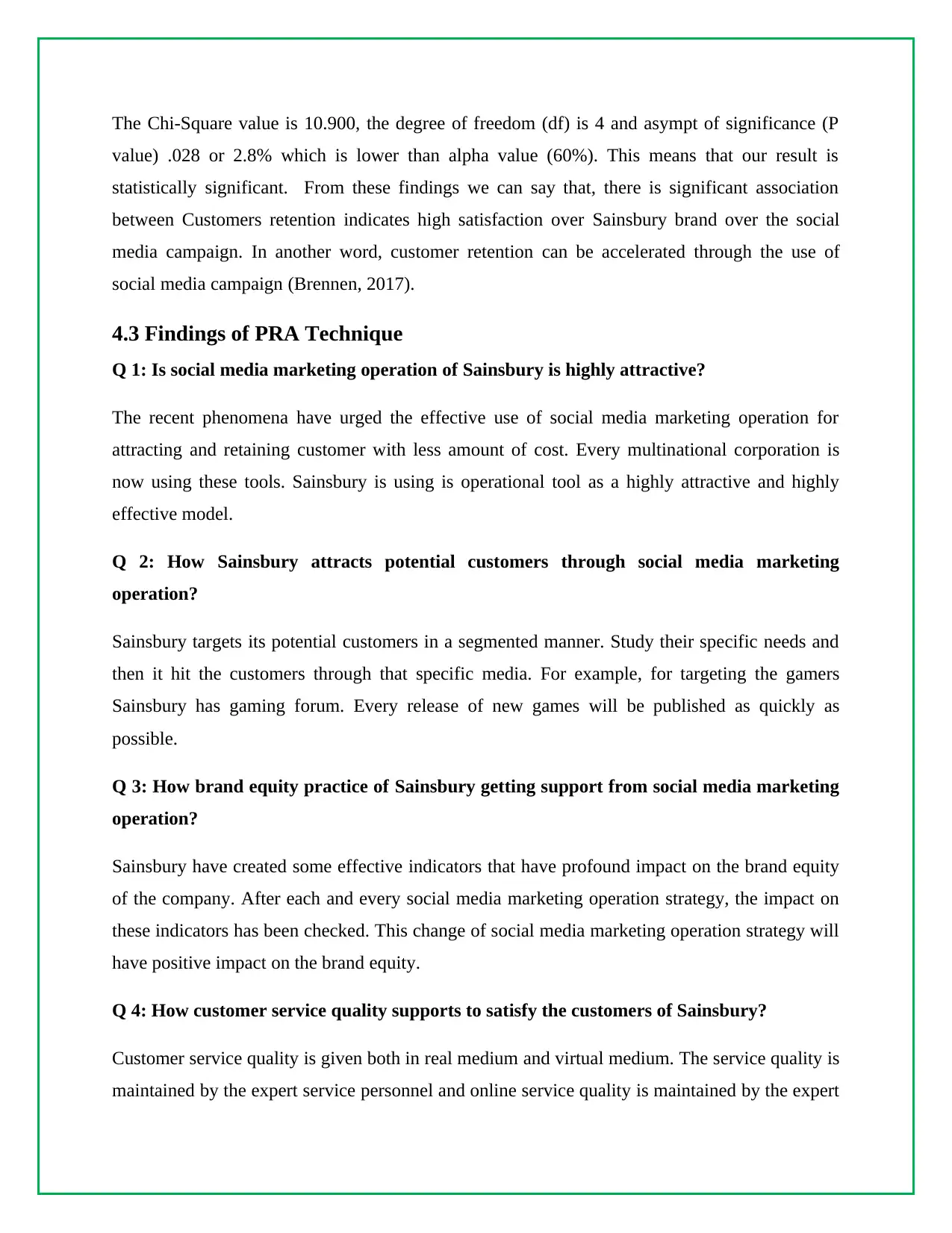
value) .028 or 2.8% which is lower than alpha value (60%). This means that our result is
statistically significant. From these findings we can say that, there is significant association
between Customers retention indicates high satisfaction over Sainsbury brand over the social
media campaign. In another word, customer retention can be accelerated through the use of
social media campaign (Brennen, 2017).
4.3 Findings of PRA Technique
Q 1: Is social media marketing operation of Sainsbury is highly attractive?
The recent phenomena have urged the effective use of social media marketing operation for
attracting and retaining customer with less amount of cost. Every multinational corporation is
now using these tools. Sainsbury is using is operational tool as a highly attractive and highly
effective model.
Q 2: How Sainsbury attracts potential customers through social media marketing
operation?
Sainsbury targets its potential customers in a segmented manner. Study their specific needs and
then it hit the customers through that specific media. For example, for targeting the gamers
Sainsbury has gaming forum. Every release of new games will be published as quickly as
possible.
Q 3: How brand equity practice of Sainsbury getting support from social media marketing
operation?
Sainsbury have created some effective indicators that have profound impact on the brand equity
of the company. After each and every social media marketing operation strategy, the impact on
these indicators has been checked. This change of social media marketing operation strategy will
have positive impact on the brand equity.
Q 4: How customer service quality supports to satisfy the customers of Sainsbury?
Customer service quality is given both in real medium and virtual medium. The service quality is
maintained by the expert service personnel and online service quality is maintained by the expert
⊘ This is a preview!⊘
Do you want full access?
Subscribe today to unlock all pages.

Trusted by 1+ million students worldwide
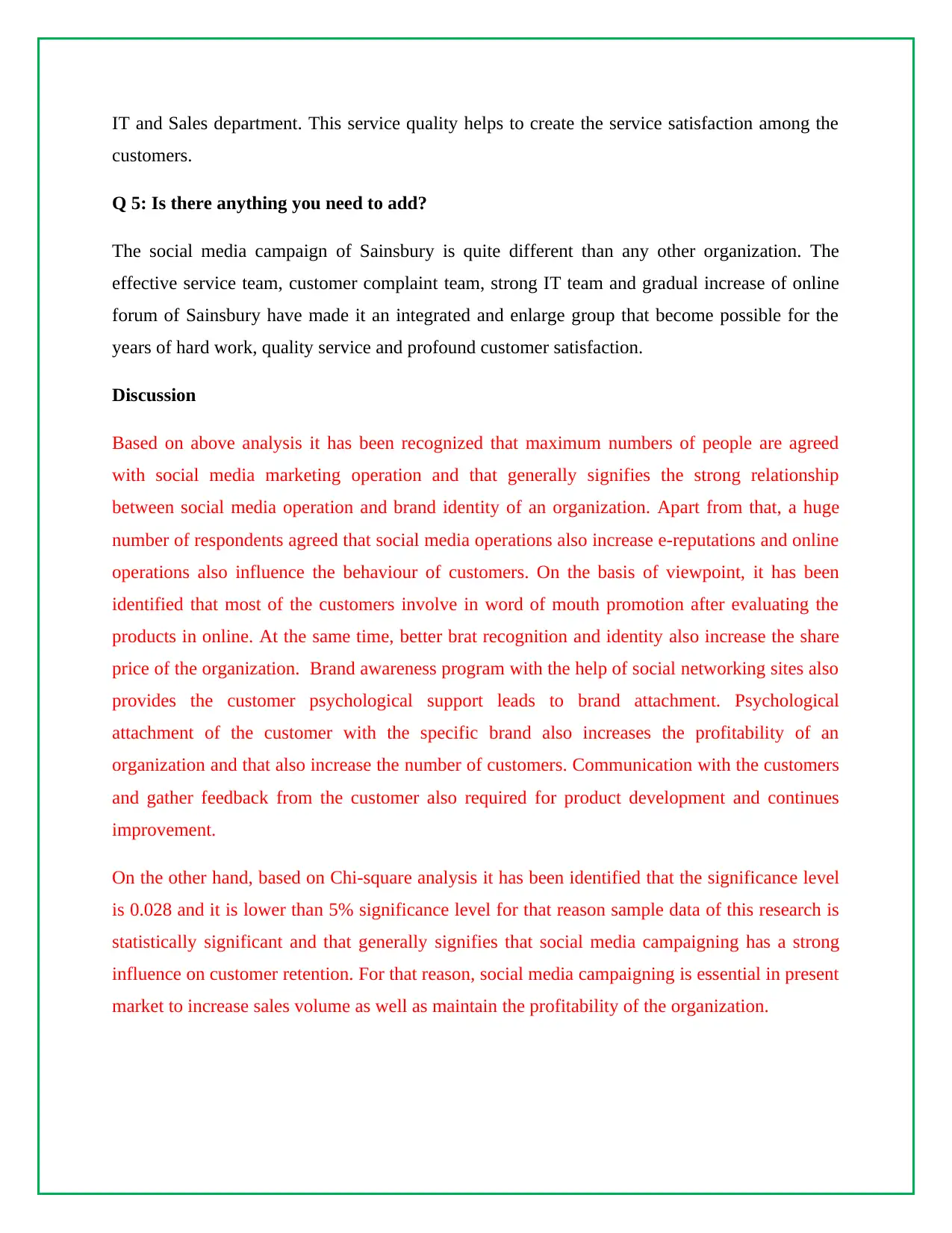
customers.
Q 5: Is there anything you need to add?
The social media campaign of Sainsbury is quite different than any other organization. The
effective service team, customer complaint team, strong IT team and gradual increase of online
forum of Sainsbury have made it an integrated and enlarge group that become possible for the
years of hard work, quality service and profound customer satisfaction.
Discussion
Based on above analysis it has been recognized that maximum numbers of people are agreed
with social media marketing operation and that generally signifies the strong relationship
between social media operation and brand identity of an organization. Apart from that, a huge
number of respondents agreed that social media operations also increase e-reputations and online
operations also influence the behaviour of customers. On the basis of viewpoint, it has been
identified that most of the customers involve in word of mouth promotion after evaluating the
products in online. At the same time, better brat recognition and identity also increase the share
price of the organization. Brand awareness program with the help of social networking sites also
provides the customer psychological support leads to brand attachment. Psychological
attachment of the customer with the specific brand also increases the profitability of an
organization and that also increase the number of customers. Communication with the customers
and gather feedback from the customer also required for product development and continues
improvement.
On the other hand, based on Chi-square analysis it has been identified that the significance level
is 0.028 and it is lower than 5% significance level for that reason sample data of this research is
statistically significant and that generally signifies that social media campaigning has a strong
influence on customer retention. For that reason, social media campaigning is essential in present
market to increase sales volume as well as maintain the profitability of the organization.
Paraphrase This Document
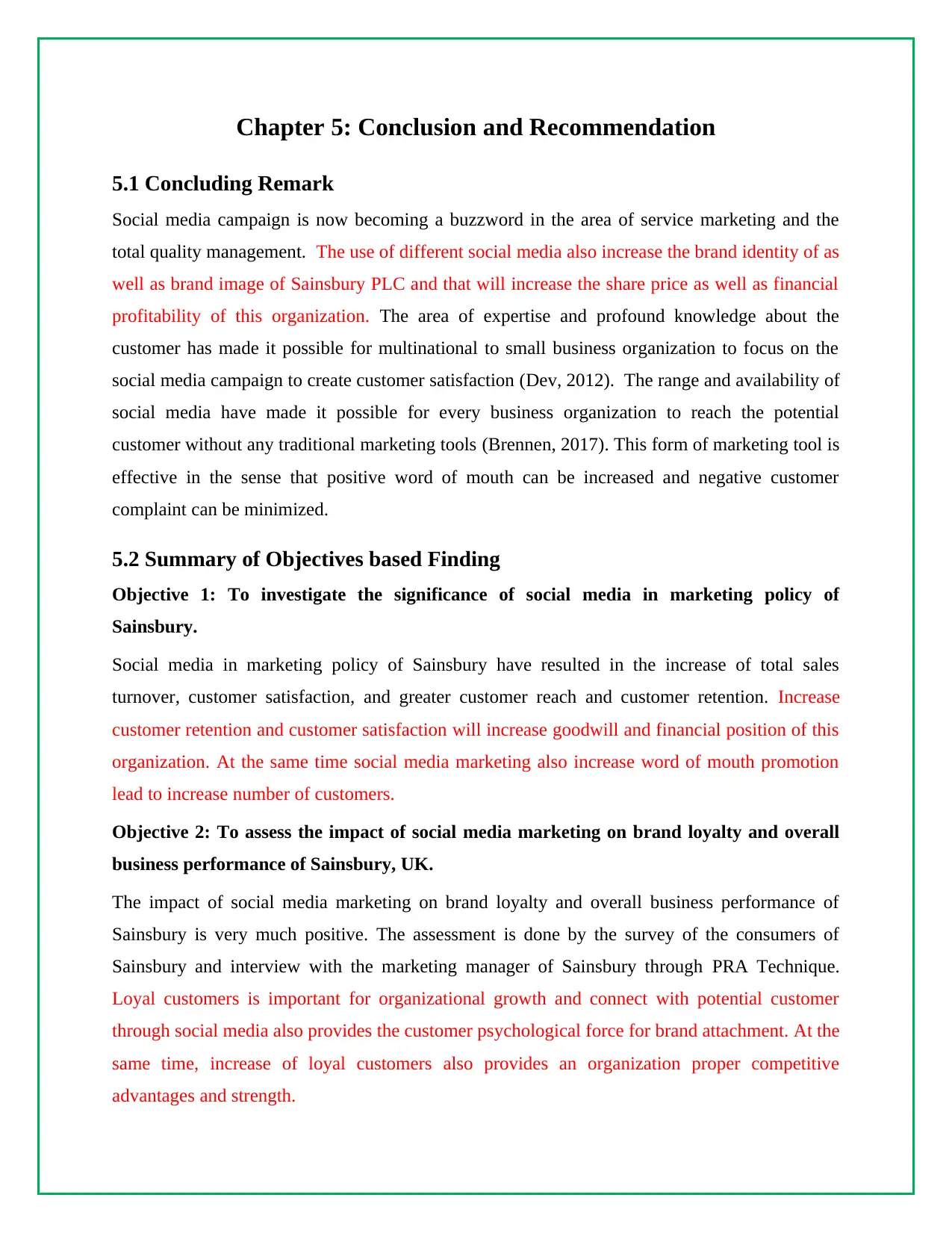
5.1 Concluding Remark
Social media campaign is now becoming a buzzword in the area of service marketing and the
total quality management. The use of different social media also increase the brand identity of as
well as brand image of Sainsbury PLC and that will increase the share price as well as financial
profitability of this organization. The area of expertise and profound knowledge about the
customer has made it possible for multinational to small business organization to focus on the
social media campaign to create customer satisfaction (Dev, 2012). The range and availability of
social media have made it possible for every business organization to reach the potential
customer without any traditional marketing tools (Brennen, 2017). This form of marketing tool is
effective in the sense that positive word of mouth can be increased and negative customer
complaint can be minimized.
5.2 Summary of Objectives based Finding
Objective 1: To investigate the significance of social media in marketing policy of
Sainsbury.
Social media in marketing policy of Sainsbury have resulted in the increase of total sales
turnover, customer satisfaction, and greater customer reach and customer retention. Increase
customer retention and customer satisfaction will increase goodwill and financial position of this
organization. At the same time social media marketing also increase word of mouth promotion
lead to increase number of customers.
Objective 2: To assess the impact of social media marketing on brand loyalty and overall
business performance of Sainsbury, UK.
The impact of social media marketing on brand loyalty and overall business performance of
Sainsbury is very much positive. The assessment is done by the survey of the consumers of
Sainsbury and interview with the marketing manager of Sainsbury through PRA Technique.
Loyal customers is important for organizational growth and connect with potential customer
through social media also provides the customer psychological force for brand attachment. At the
same time, increase of loyal customers also provides an organization proper competitive
advantages and strength.
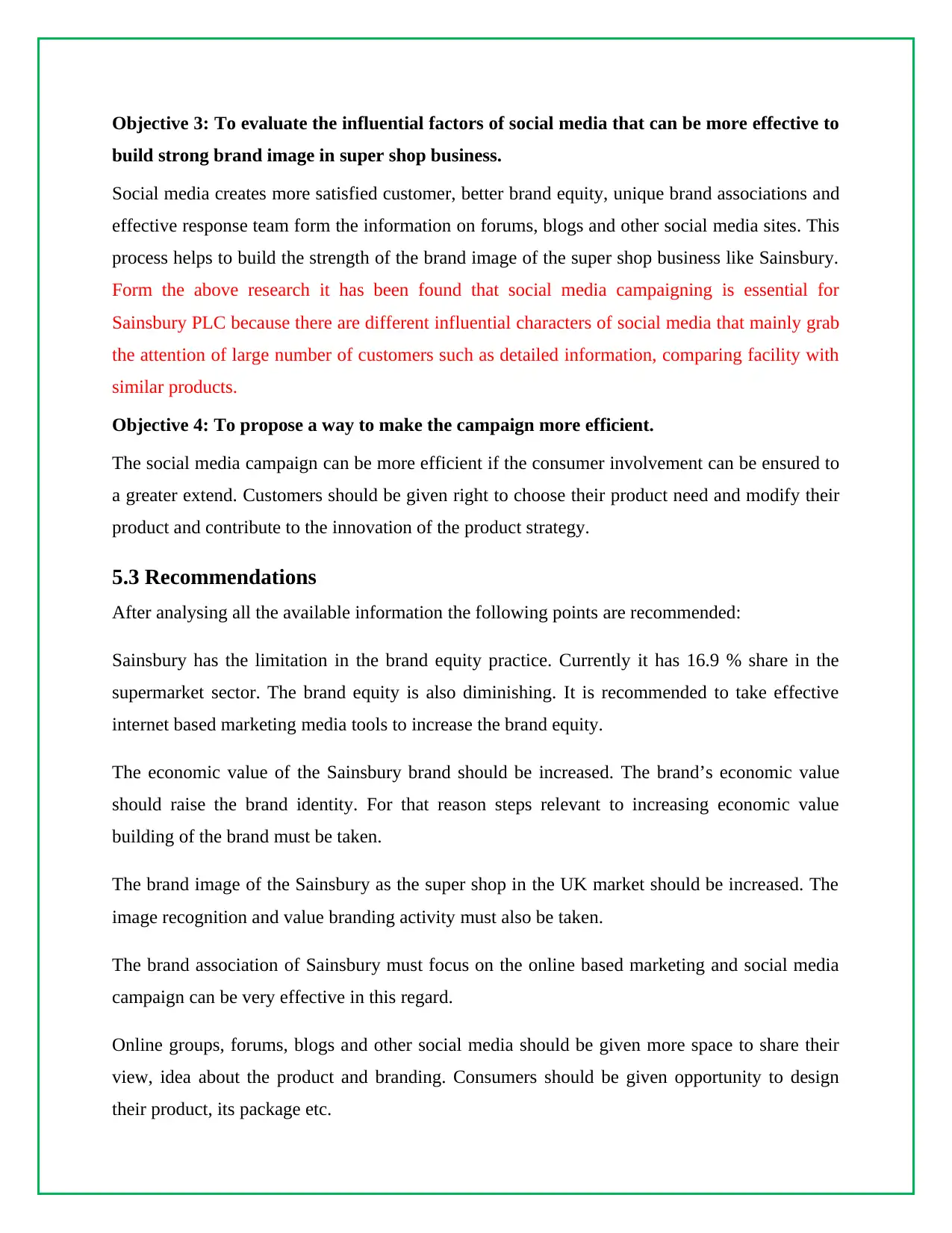
build strong brand image in super shop business.
Social media creates more satisfied customer, better brand equity, unique brand associations and
effective response team form the information on forums, blogs and other social media sites. This
process helps to build the strength of the brand image of the super shop business like Sainsbury.
Form the above research it has been found that social media campaigning is essential for
Sainsbury PLC because there are different influential characters of social media that mainly grab
the attention of large number of customers such as detailed information, comparing facility with
similar products.
Objective 4: To propose a way to make the campaign more efficient.
The social media campaign can be more efficient if the consumer involvement can be ensured to
a greater extend. Customers should be given right to choose their product need and modify their
product and contribute to the innovation of the product strategy.
5.3 Recommendations
After analysing all the available information the following points are recommended:
Sainsbury has the limitation in the brand equity practice. Currently it has 16.9 % share in the
supermarket sector. The brand equity is also diminishing. It is recommended to take effective
internet based marketing media tools to increase the brand equity.
The economic value of the Sainsbury brand should be increased. The brand’s economic value
should raise the brand identity. For that reason steps relevant to increasing economic value
building of the brand must be taken.
The brand image of the Sainsbury as the super shop in the UK market should be increased. The
image recognition and value branding activity must also be taken.
The brand association of Sainsbury must focus on the online based marketing and social media
campaign can be very effective in this regard.
Online groups, forums, blogs and other social media should be given more space to share their
view, idea about the product and branding. Consumers should be given opportunity to design
their product, its package etc.
⊘ This is a preview!⊘
Do you want full access?
Subscribe today to unlock all pages.

Trusted by 1+ million students worldwide

Based on the set objectives the key findings of this research will led to some new research
opportunities along with the present scenario in the case of brand image concept. The future
scope for research is given below:
The cognitive brand recognition of Sainsbury can be very effective for the future
development of branding attributes.
Image sharing and the value based sharing should be necessary for the integrated
complementation of the brand association process.
Integrated Social media marketing can be very fruitful for the accumulated value creation
of a particular business organization.
Social business criteria can be analyzed with the concept of social media campaign for
the development of corporate social responsibility.
Paraphrase This Document
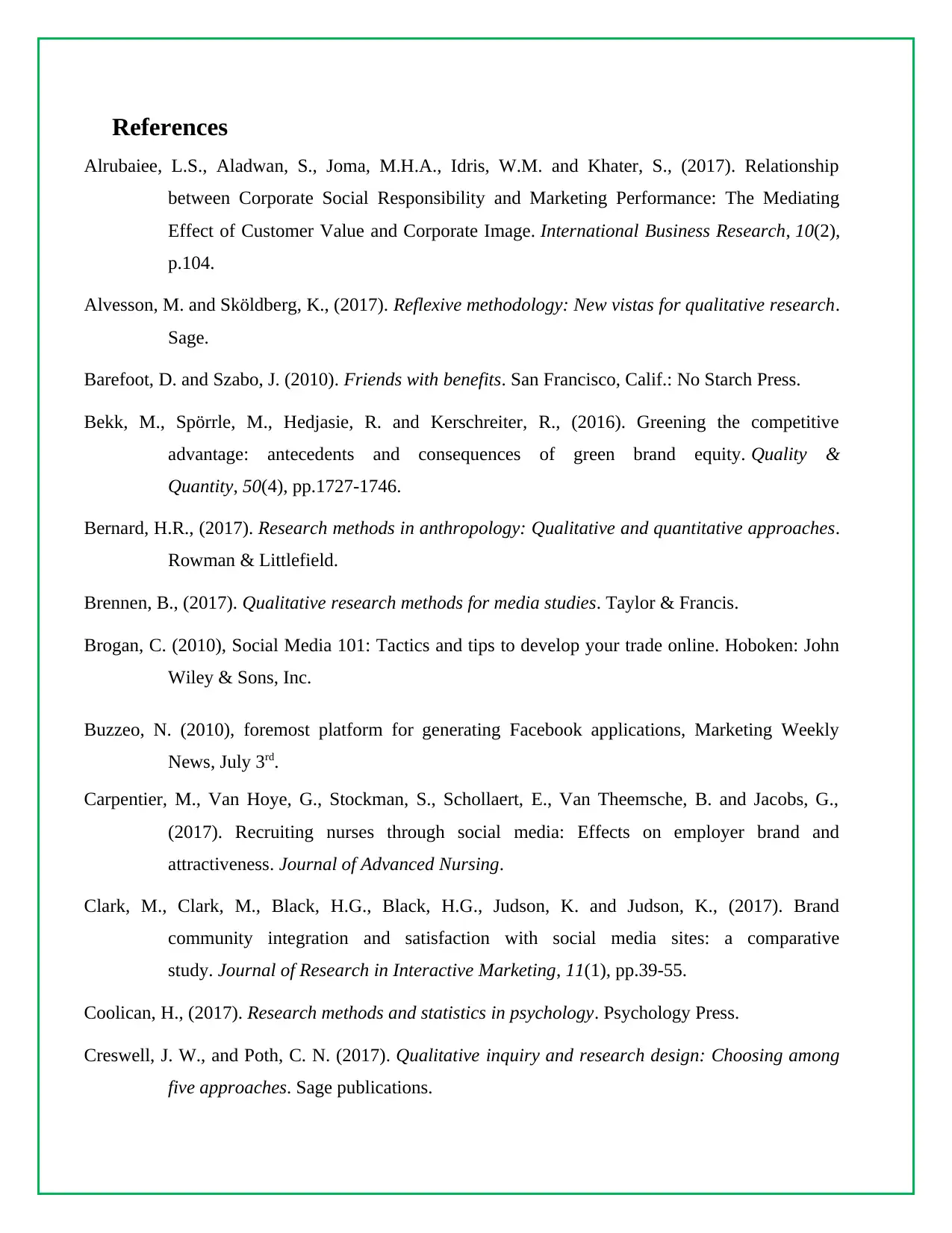
Alrubaiee, L.S., Aladwan, S., Joma, M.H.A., Idris, W.M. and Khater, S., (2017). Relationship
between Corporate Social Responsibility and Marketing Performance: The Mediating
Effect of Customer Value and Corporate Image. International Business Research, 10(2),
p.104.
Alvesson, M. and Sköldberg, K., (2017). Reflexive methodology: New vistas for qualitative research.
Sage.
Barefoot, D. and Szabo, J. (2010). Friends with benefits. San Francisco, Calif.: No Starch Press.
Bekk, M., Spörrle, M., Hedjasie, R. and Kerschreiter, R., (2016). Greening the competitive
advantage: antecedents and consequences of green brand equity. Quality &
Quantity, 50(4), pp.1727-1746.
Bernard, H.R., (2017). Research methods in anthropology: Qualitative and quantitative approaches.
Rowman & Littlefield.
Brennen, B., (2017). Qualitative research methods for media studies. Taylor & Francis.
Brogan, C. (2010), Social Media 101: Tactics and tips to develop your trade online. Hoboken: John
Wiley & Sons, Inc.
Buzzeo, N. (2010), foremost platform for generating Facebook applications, Marketing Weekly
News, July 3rd.
Carpentier, M., Van Hoye, G., Stockman, S., Schollaert, E., Van Theemsche, B. and Jacobs, G.,
(2017). Recruiting nurses through social media: Effects on employer brand and
attractiveness. Journal of Advanced Nursing.
Clark, M., Clark, M., Black, H.G., Black, H.G., Judson, K. and Judson, K., (2017). Brand
community integration and satisfaction with social media sites: a comparative
study. Journal of Research in Interactive Marketing, 11(1), pp.39-55.
Coolican, H., (2017). Research methods and statistics in psychology. Psychology Press.
Creswell, J. W., and Poth, C. N. (2017). Qualitative inquiry and research design: Choosing among
five approaches. Sage publications.
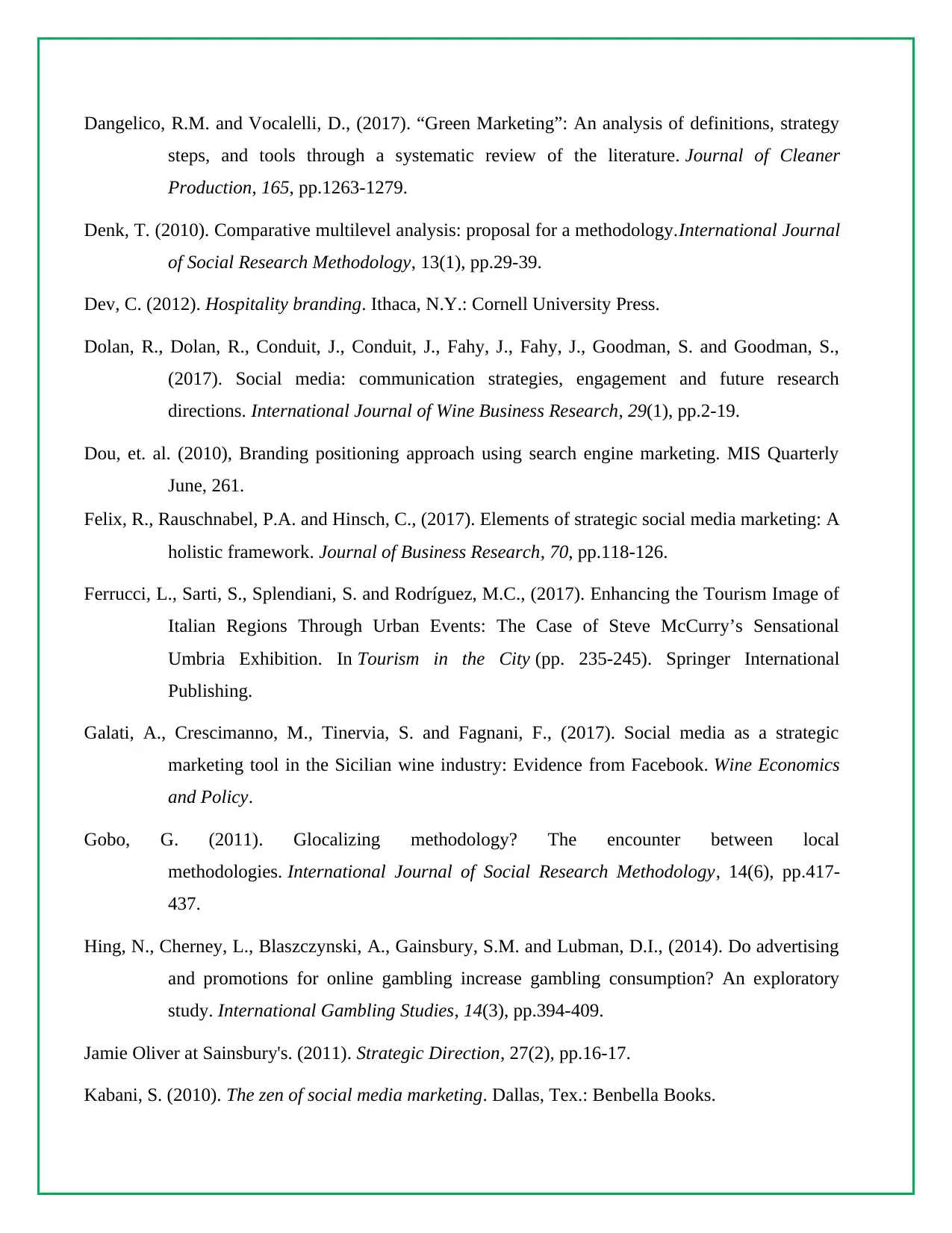
steps, and tools through a systematic review of the literature. Journal of Cleaner
Production, 165, pp.1263-1279.
Denk, T. (2010). Comparative multilevel analysis: proposal for a methodology.International Journal
of Social Research Methodology, 13(1), pp.29-39.
Dev, C. (2012). Hospitality branding. Ithaca, N.Y.: Cornell University Press.
Dolan, R., Dolan, R., Conduit, J., Conduit, J., Fahy, J., Fahy, J., Goodman, S. and Goodman, S.,
(2017). Social media: communication strategies, engagement and future research
directions. International Journal of Wine Business Research, 29(1), pp.2-19.
Dou, et. al. (2010), Branding positioning approach using search engine marketing. MIS Quarterly
June, 261.
Felix, R., Rauschnabel, P.A. and Hinsch, C., (2017). Elements of strategic social media marketing: A
holistic framework. Journal of Business Research, 70, pp.118-126.
Ferrucci, L., Sarti, S., Splendiani, S. and Rodríguez, M.C., (2017). Enhancing the Tourism Image of
Italian Regions Through Urban Events: The Case of Steve McCurry’s Sensational
Umbria Exhibition. In Tourism in the City (pp. 235-245). Springer International
Publishing.
Galati, A., Crescimanno, M., Tinervia, S. and Fagnani, F., (2017). Social media as a strategic
marketing tool in the Sicilian wine industry: Evidence from Facebook. Wine Economics
and Policy.
Gobo, G. (2011). Glocalizing methodology? The encounter between local
methodologies. International Journal of Social Research Methodology, 14(6), pp.417-
437.
Hing, N., Cherney, L., Blaszczynski, A., Gainsbury, S.M. and Lubman, D.I., (2014). Do advertising
and promotions for online gambling increase gambling consumption? An exploratory
study. International Gambling Studies, 14(3), pp.394-409.
Jamie Oliver at Sainsbury's. (2011). Strategic Direction, 27(2), pp.16-17.
Kabani, S. (2010). The zen of social media marketing. Dallas, Tex.: Benbella Books.
⊘ This is a preview!⊘
Do you want full access?
Subscribe today to unlock all pages.

Trusted by 1+ million students worldwide
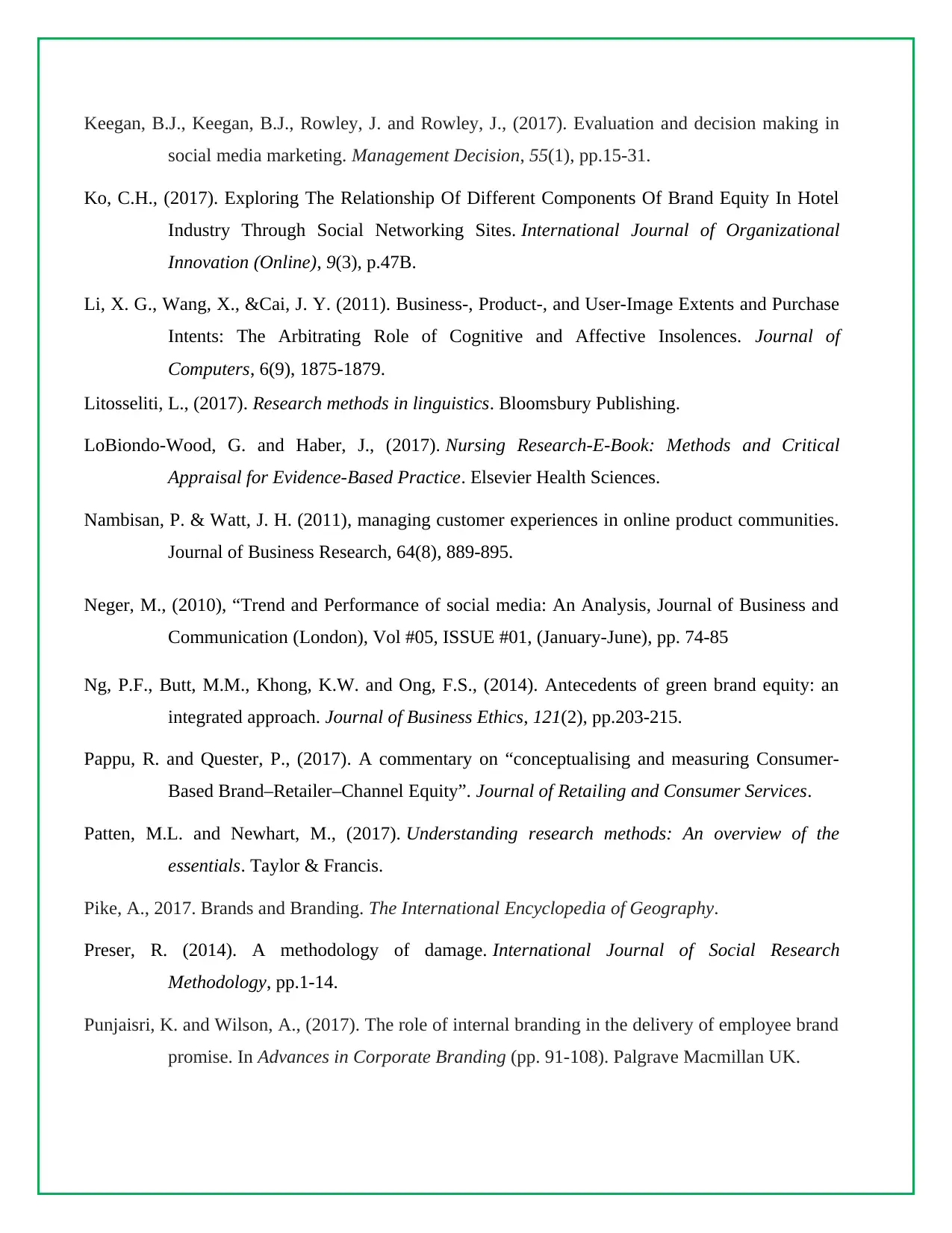
social media marketing. Management Decision, 55(1), pp.15-31.
Ko, C.H., (2017). Exploring The Relationship Of Different Components Of Brand Equity In Hotel
Industry Through Social Networking Sites. International Journal of Organizational
Innovation (Online), 9(3), p.47B.
Li, X. G., Wang, X., &Cai, J. Y. (2011). Business-, Product-, and User-Image Extents and Purchase
Intents: The Arbitrating Role of Cognitive and Affective Insolences. Journal of
Computers, 6(9), 1875-1879.
Litosseliti, L., (2017). Research methods in linguistics. Bloomsbury Publishing.
LoBiondo-Wood, G. and Haber, J., (2017). Nursing Research-E-Book: Methods and Critical
Appraisal for Evidence-Based Practice. Elsevier Health Sciences.
Nambisan, P. & Watt, J. H. (2011), managing customer experiences in online product communities.
Journal of Business Research, 64(8), 889-895.
Neger, M., (2010), “Trend and Performance of social media: An Analysis, Journal of Business and
Communication (London), Vol #05, ISSUE #01, (January-June), pp. 74-85
Ng, P.F., Butt, M.M., Khong, K.W. and Ong, F.S., (2014). Antecedents of green brand equity: an
integrated approach. Journal of Business Ethics, 121(2), pp.203-215.
Pappu, R. and Quester, P., (2017). A commentary on “conceptualising and measuring Consumer-
Based Brand–Retailer–Channel Equity”. Journal of Retailing and Consumer Services.
Patten, M.L. and Newhart, M., (2017). Understanding research methods: An overview of the
essentials. Taylor & Francis.
Pike, A., 2017. Brands and Branding. The International Encyclopedia of Geography.
Preser, R. (2014). A methodology of damage. International Journal of Social Research
Methodology, pp.1-14.
Punjaisri, K. and Wilson, A., (2017). The role of internal branding in the delivery of employee brand
promise. In Advances in Corporate Branding (pp. 91-108). Palgrave Macmillan UK.
Paraphrase This Document
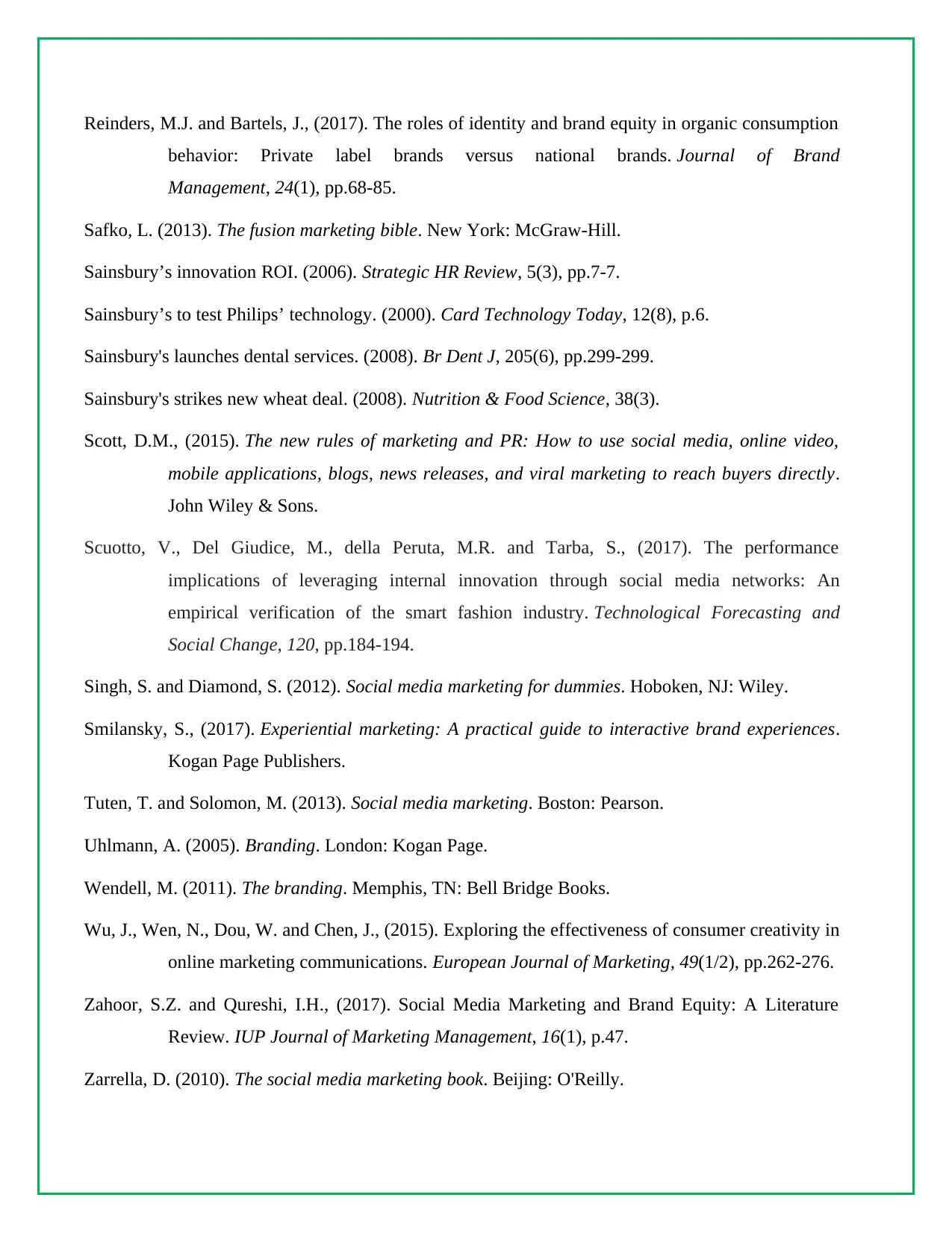
behavior: Private label brands versus national brands. Journal of Brand
Management, 24(1), pp.68-85.
Safko, L. (2013). The fusion marketing bible. New York: McGraw-Hill.
Sainsbury’s innovation ROI. (2006). Strategic HR Review, 5(3), pp.7-7.
Sainsbury’s to test Philips’ technology. (2000). Card Technology Today, 12(8), p.6.
Sainsbury's launches dental services. (2008). Br Dent J, 205(6), pp.299-299.
Sainsbury's strikes new wheat deal. (2008). Nutrition & Food Science, 38(3).
Scott, D.M., (2015). The new rules of marketing and PR: How to use social media, online video,
mobile applications, blogs, news releases, and viral marketing to reach buyers directly.
John Wiley & Sons.
Scuotto, V., Del Giudice, M., della Peruta, M.R. and Tarba, S., (2017). The performance
implications of leveraging internal innovation through social media networks: An
empirical verification of the smart fashion industry. Technological Forecasting and
Social Change, 120, pp.184-194.
Singh, S. and Diamond, S. (2012). Social media marketing for dummies. Hoboken, NJ: Wiley.
Smilansky, S., (2017). Experiential marketing: A practical guide to interactive brand experiences.
Kogan Page Publishers.
Tuten, T. and Solomon, M. (2013). Social media marketing. Boston: Pearson.
Uhlmann, A. (2005). Branding. London: Kogan Page.
Wendell, M. (2011). The branding. Memphis, TN: Bell Bridge Books.
Wu, J., Wen, N., Dou, W. and Chen, J., (2015). Exploring the effectiveness of consumer creativity in
online marketing communications. European Journal of Marketing, 49(1/2), pp.262-276.
Zahoor, S.Z. and Qureshi, I.H., (2017). Social Media Marketing and Brand Equity: A Literature
Review. IUP Journal of Marketing Management, 16(1), p.47.
Zarrella, D. (2010). The social media marketing book. Beijing: O'Reilly.
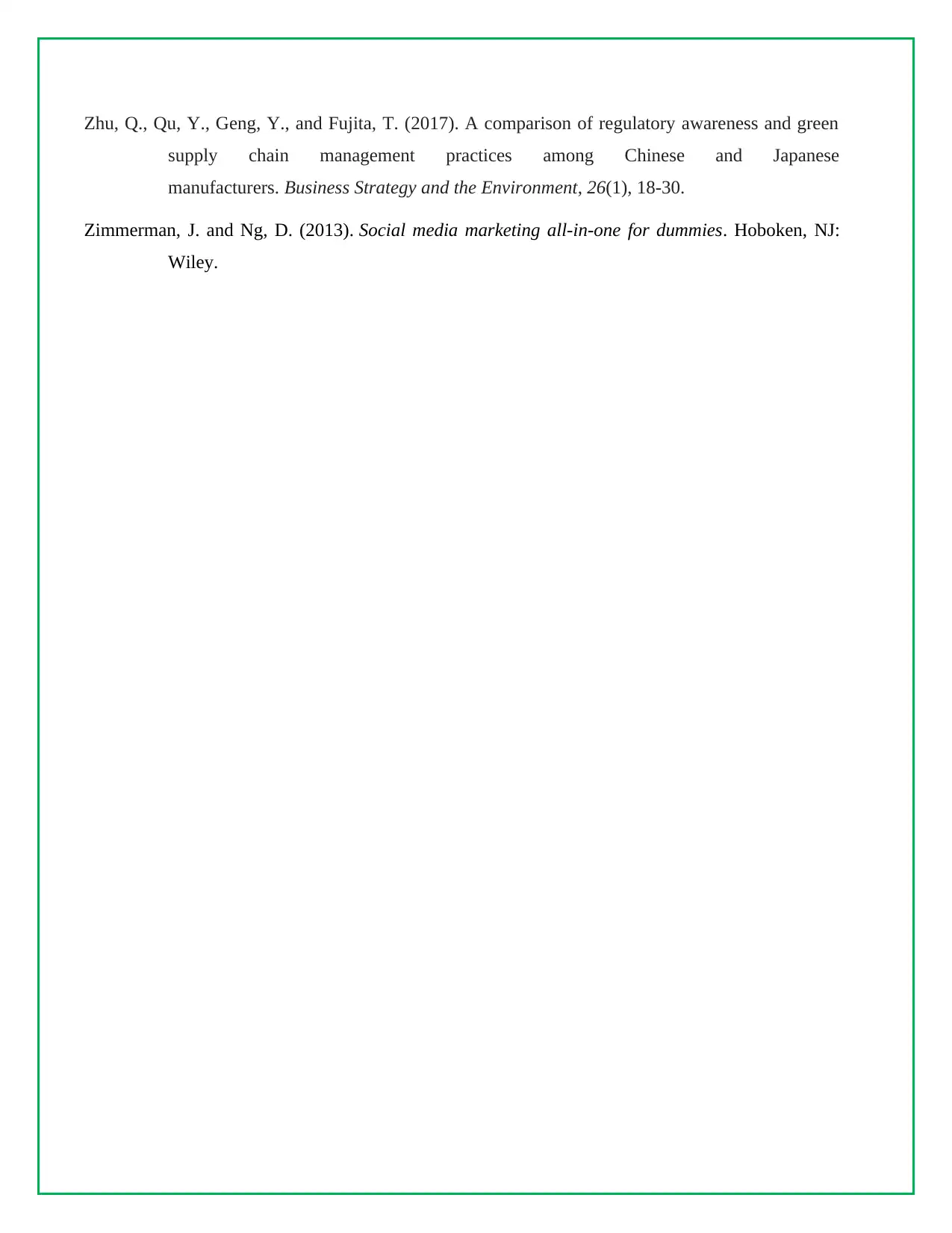
supply chain management practices among Chinese and Japanese
manufacturers. Business Strategy and the Environment, 26(1), 18-30.
Zimmerman, J. and Ng, D. (2013). Social media marketing all-in-one for dummies. Hoboken, NJ:
Wiley.
⊘ This is a preview!⊘
Do you want full access?
Subscribe today to unlock all pages.

Trusted by 1+ million students worldwide
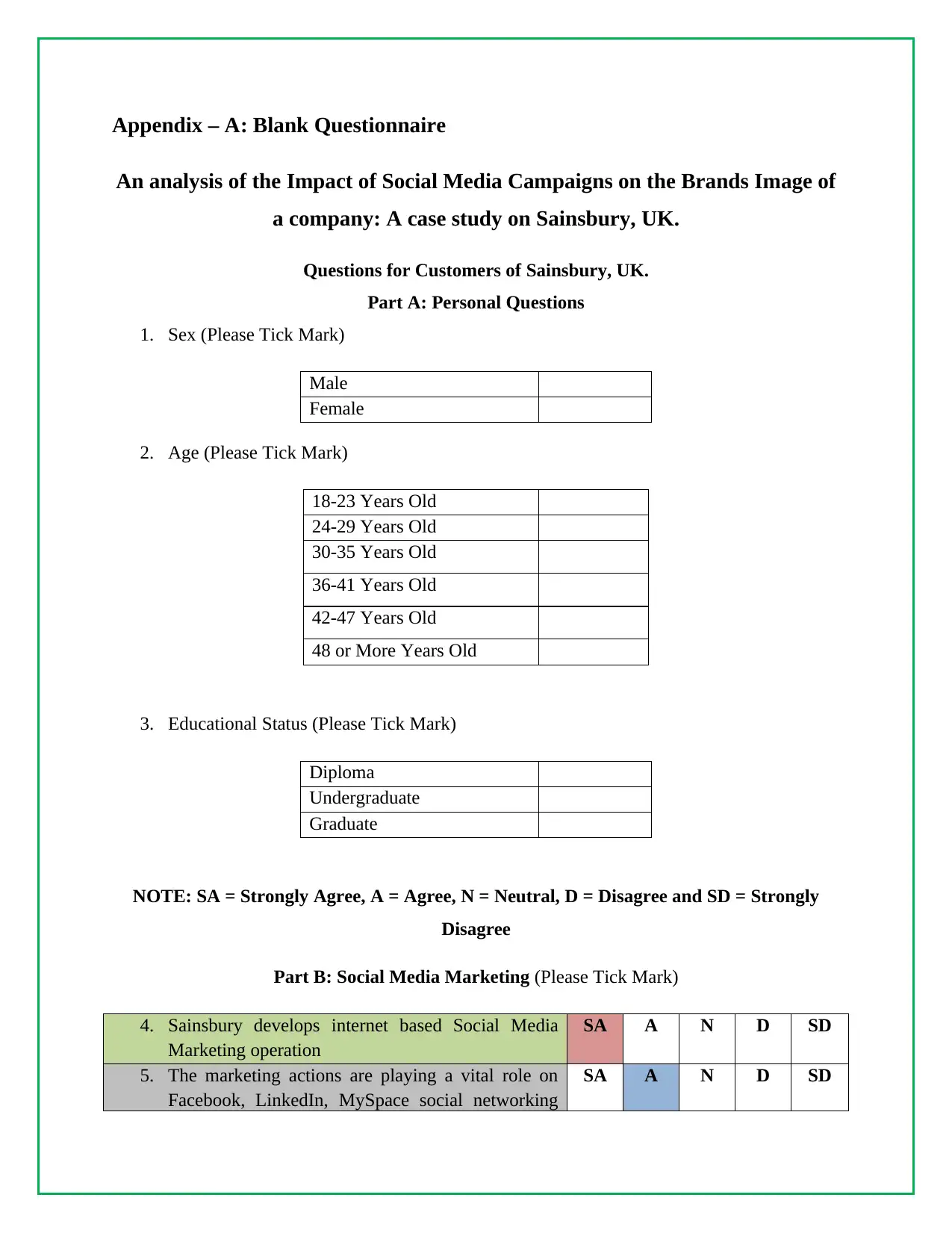
An analysis of the Impact of Social Media Campaigns on the Brands Image of
a company: A case study on Sainsbury, UK.
Questions for Customers of Sainsbury, UK.
Part A: Personal Questions
1. Sex (Please Tick Mark)
Male
Female
2. Age (Please Tick Mark)
18-23 Years Old
24-29 Years Old
30-35 Years Old
36-41 Years Old
42-47 Years Old
48 or More Years Old
3. Educational Status (Please Tick Mark)
Diploma
Undergraduate
Graduate
NOTE: SA = Strongly Agree, A = Agree, N = Neutral, D = Disagree and SD = Strongly
Disagree
Part B: Social Media Marketing (Please Tick Mark)
4. Sainsbury develops internet based Social Media
Marketing operation
SA A N D SD
5. The marketing actions are playing a vital role on
Facebook, LinkedIn, MySpace social networking
SA A N D SD
Paraphrase This Document
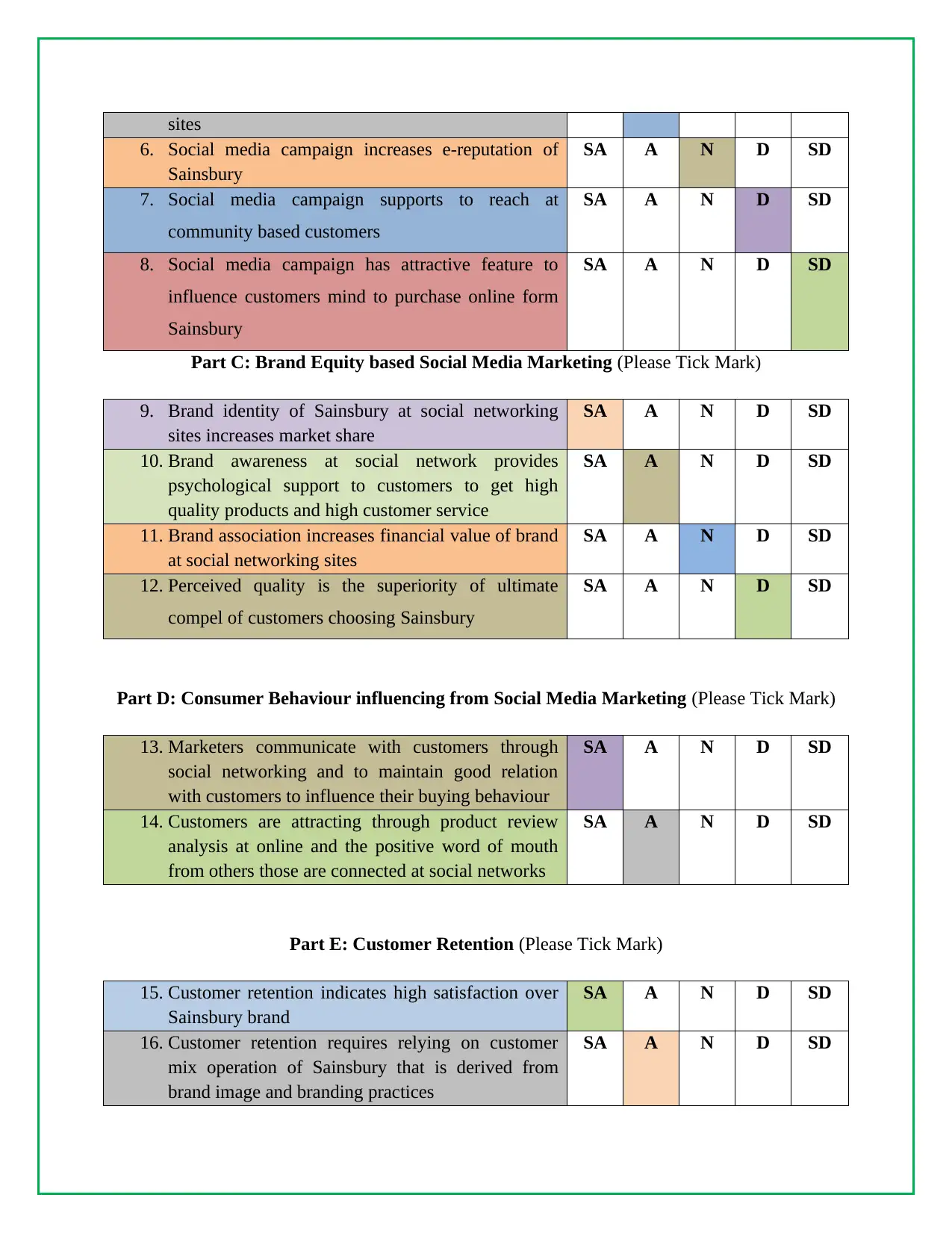
6. Social media campaign increases e-reputation of
Sainsbury
SA A N D SD
7. Social media campaign supports to reach at
community based customers
SA A N D SD
8. Social media campaign has attractive feature to
influence customers mind to purchase online form
Sainsbury
SA A N D SD
Part C: Brand Equity based Social Media Marketing (Please Tick Mark)
9. Brand identity of Sainsbury at social networking
sites increases market share
SA A N D SD
10. Brand awareness at social network provides
psychological support to customers to get high
quality products and high customer service
SA A N D SD
11. Brand association increases financial value of brand
at social networking sites
SA A N D SD
12. Perceived quality is the superiority of ultimate
compel of customers choosing Sainsbury
SA A N D SD
Part D: Consumer Behaviour influencing from Social Media Marketing (Please Tick Mark)
13. Marketers communicate with customers through
social networking and to maintain good relation
with customers to influence their buying behaviour
SA A N D SD
14. Customers are attracting through product review
analysis at online and the positive word of mouth
from others those are connected at social networks
SA A N D SD
Part E: Customer Retention (Please Tick Mark)
15. Customer retention indicates high satisfaction over
Sainsbury brand
SA A N D SD
16. Customer retention requires relying on customer
mix operation of Sainsbury that is derived from
brand image and branding practices
SA A N D SD
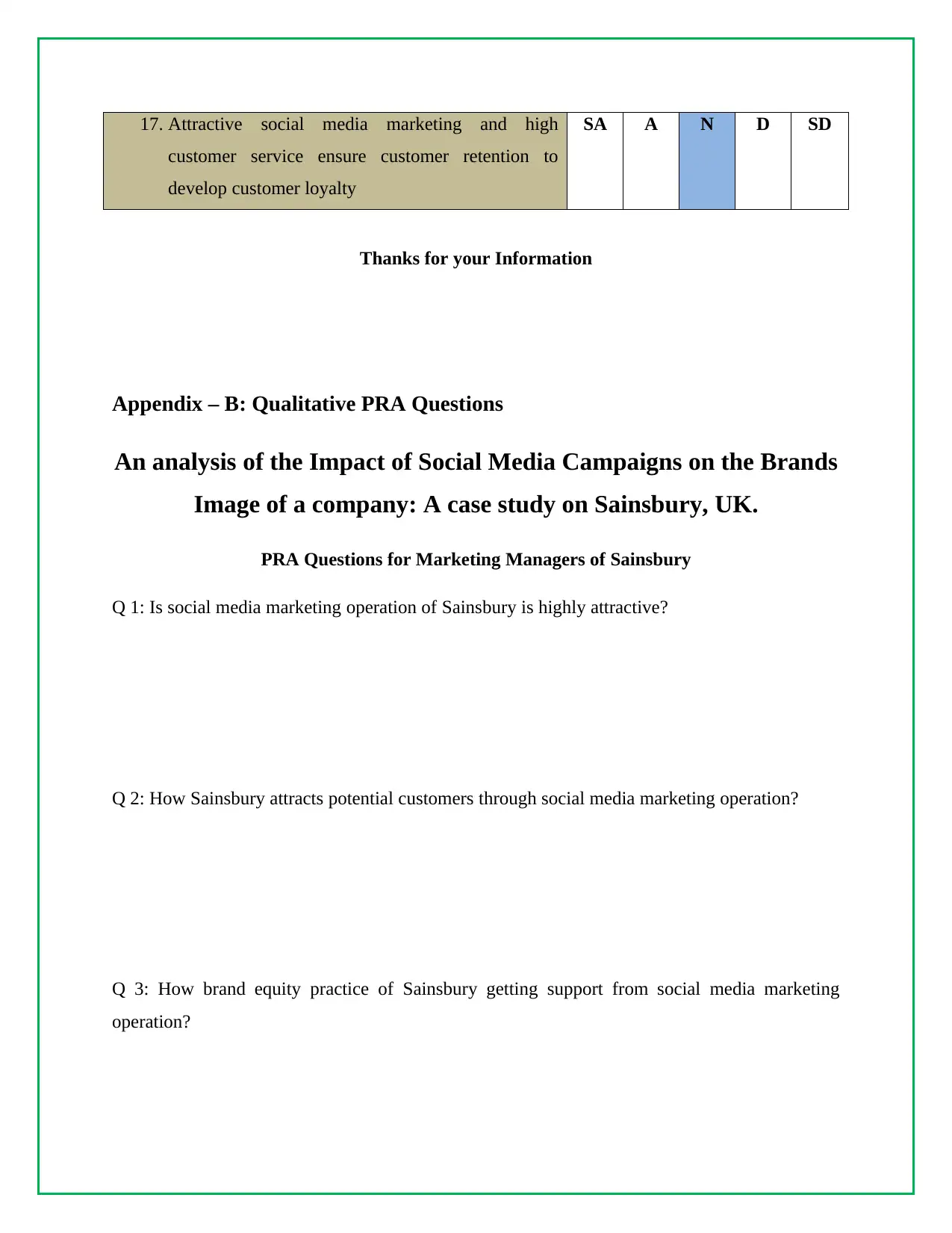
customer service ensure customer retention to
develop customer loyalty
SA A N D SD
Thanks for your Information
Appendix – B: Qualitative PRA Questions
An analysis of the Impact of Social Media Campaigns on the Brands
Image of a company: A case study on Sainsbury, UK.
PRA Questions for Marketing Managers of Sainsbury
Q 1: Is social media marketing operation of Sainsbury is highly attractive?
Q 2: How Sainsbury attracts potential customers through social media marketing operation?
Q 3: How brand equity practice of Sainsbury getting support from social media marketing
operation?
⊘ This is a preview!⊘
Do you want full access?
Subscribe today to unlock all pages.

Trusted by 1+ million students worldwide
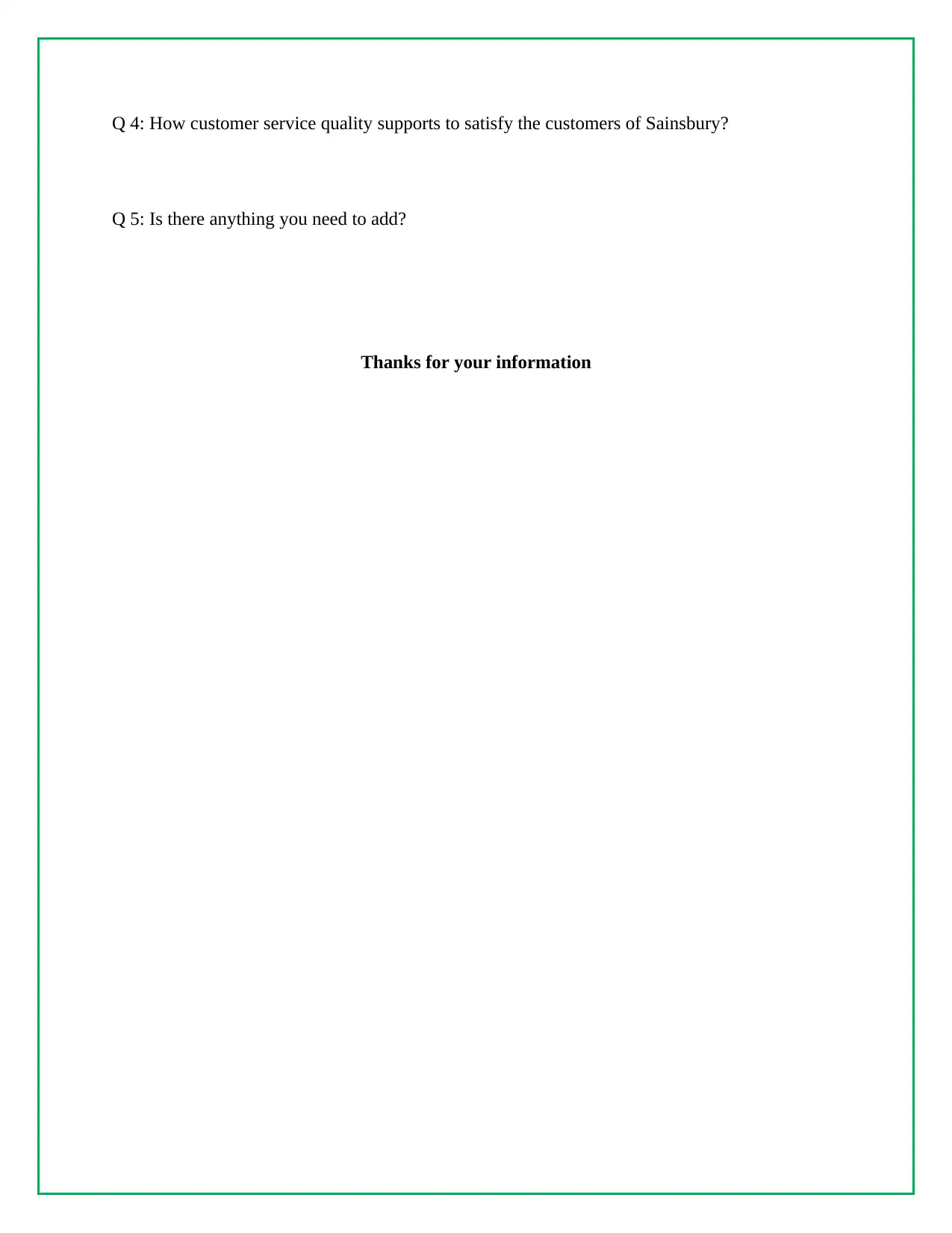
Q 5: Is there anything you need to add?
Thanks for your information
Related Documents
Your All-in-One AI-Powered Toolkit for Academic Success.
+13062052269
info@desklib.com
Available 24*7 on WhatsApp / Email
![[object Object]](/_next/static/media/star-bottom.7253800d.svg)
© 2024 | Zucol Services PVT LTD | All rights reserved.





